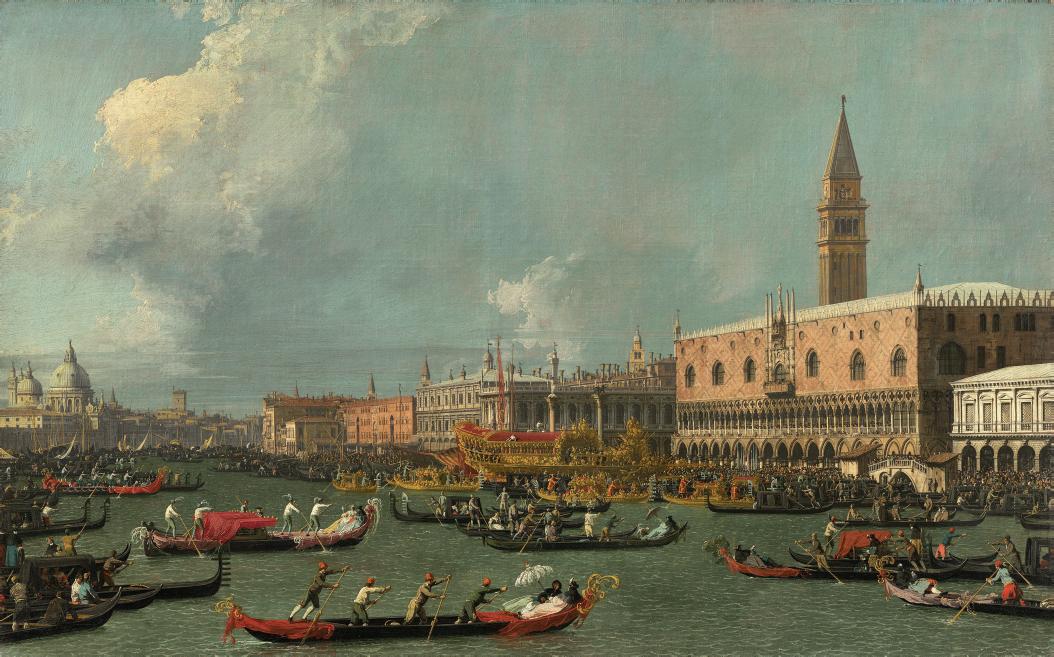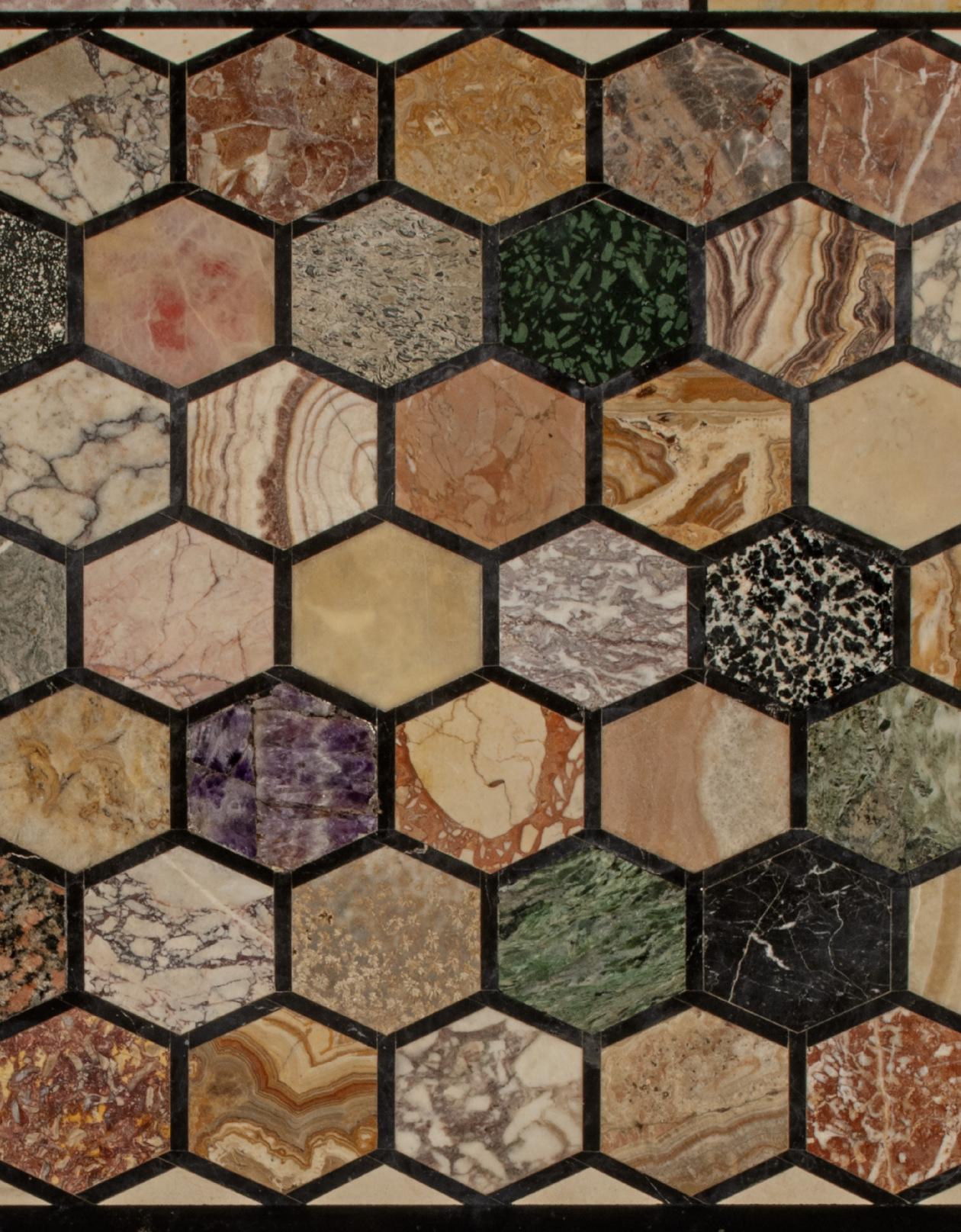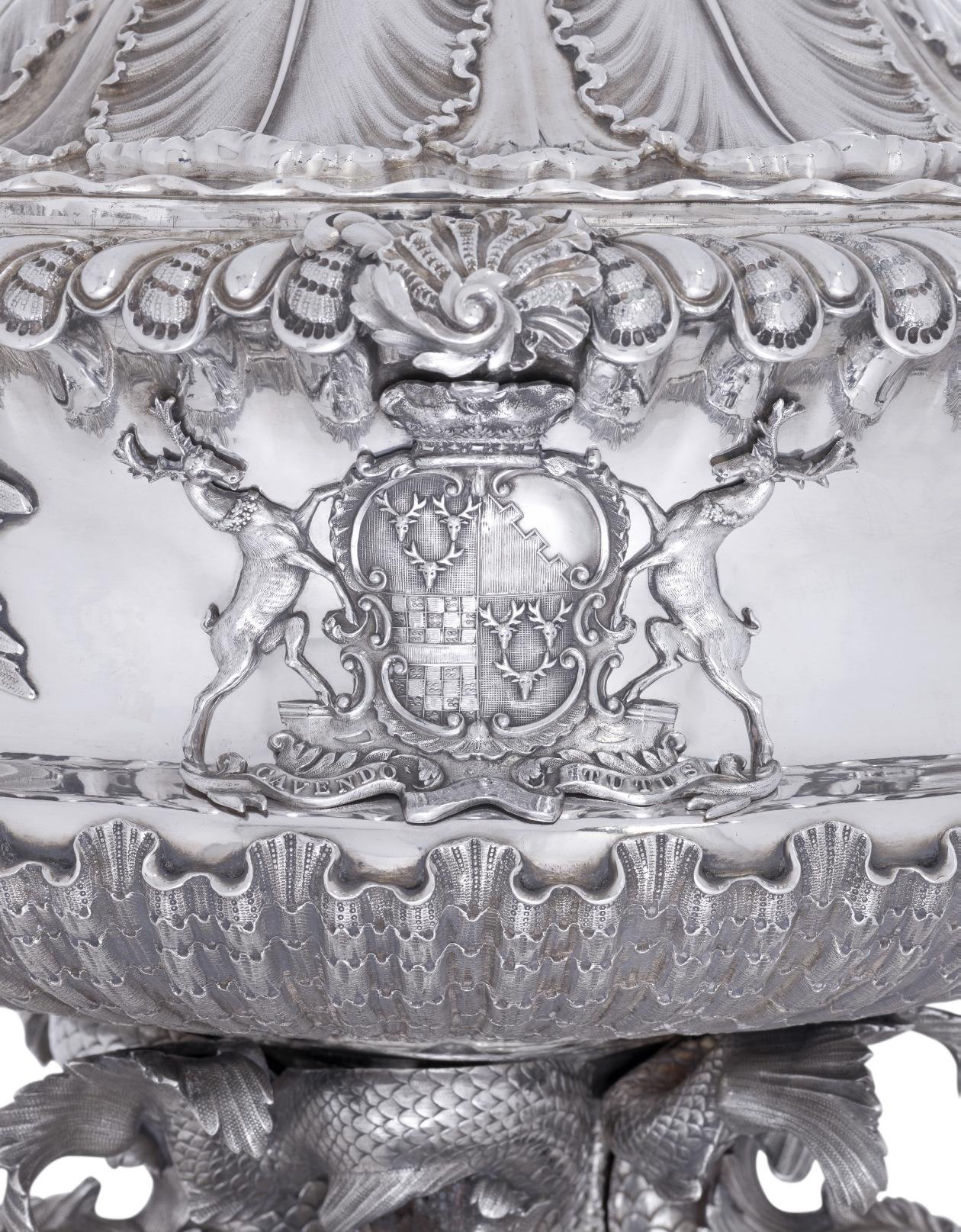

THE EXCEPTIONAL SALE
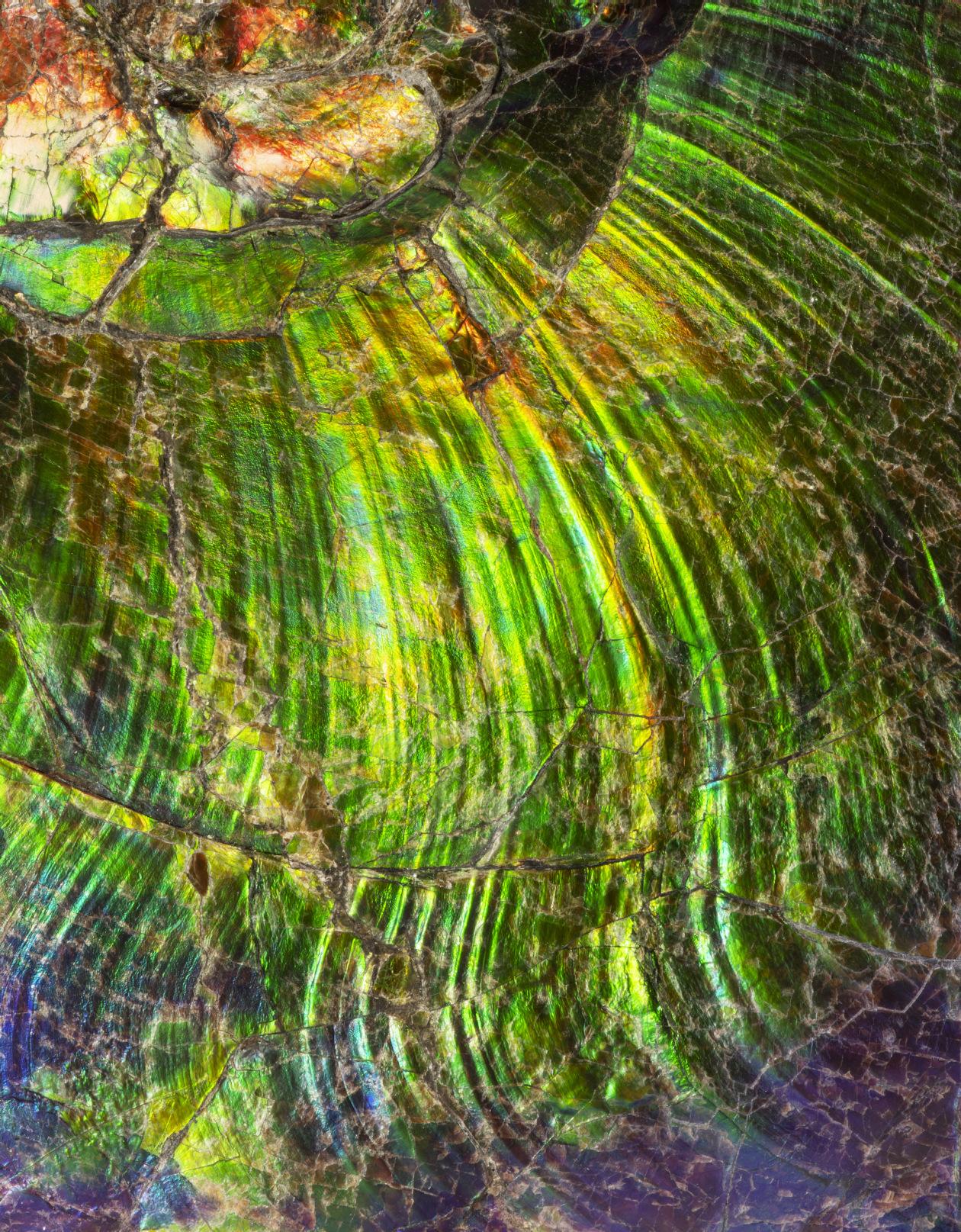
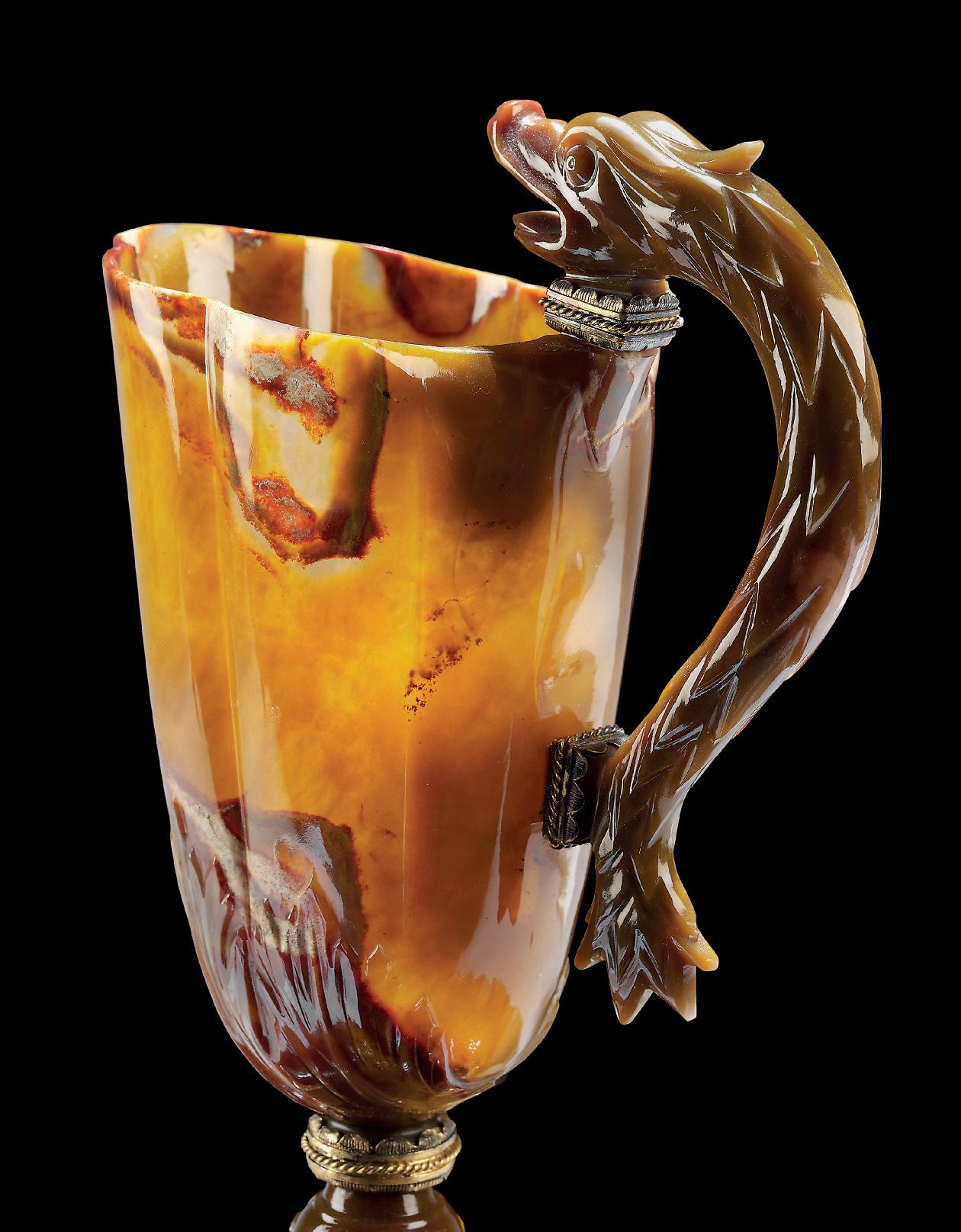
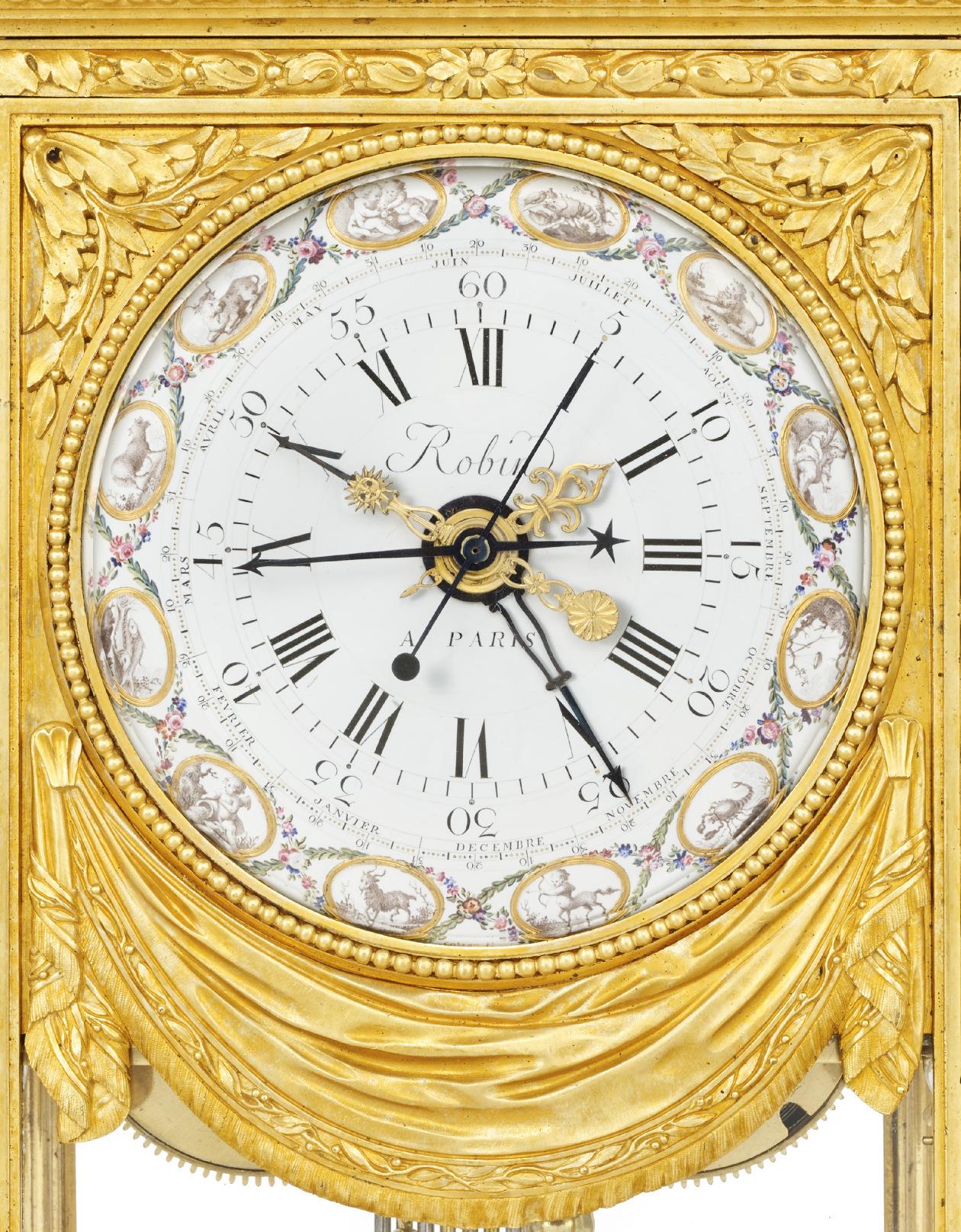
FRONT COVER
Lot 10
INSIDE FRONT COVER
Lot 27 (detail)
PAGE 1
Lot 5 (detail)
OPPOSITE
Lot 33 (detail)
PAGE 120
Lot 4 (detail)
INSIDE BACK COVER
Lot 14 (detail)
BACK COVER
Lot 15 (detail)
The Exceptional Sale MMXXV
AUCTION
Tuesday 1 July 2025 at 5:00 pm
8 King Street, St. James’s London SW1Y 6QT
VIEWING
Thursday 26 June 10.00 am - 5.00 pm
Friday 27 June 9.00 am - 5.00 pm
Saturday 28 June 12.00 pm - 5.00 pm
Sunday 29 June 12.00 pm - 5.00 pm
Monday 30 June 9.00 am - 5.00 pm
Tuesday 1 July 9.00 am - 2.00 pm
AUCTION CODE AND NUMBER
In sending absentee bids or making enquiries, this sale should be referred to as SPARTIATE-23851
ABSENTEE AND TELEPHONE BIDS
Tel: +44 (0)20 7389 2658
Fax: +44 (0)20 7930 8870
CONDITIONS OF SALE
The sale of each lot is subject to the Conditions of Sale, Important Notices and Explanation of Cataloguing Practice, which are set out in this catalogue and on christies.com. Please note that the symbols and cataloguing for some lots may change before the auction.
For the most up to date sale information for a lot, please see the full lot description, which can be accessed through the sale landing page on christies.com.
BUYER’S PREMIUM
In addition to the hammer price, a Buyer’s Premium (plus VAT) is payable. Other taxes and/or an Artist Resale Royalty fee are also payable if the lot has a tax or λ symbol.
Check Section D of the Conditions of Sale at the back of this catalogue.
please scan for complete auction information and extended lot essays
INTERNATIONAL CLASSIC ART GROUP

ORLANDO ROCK
Chairman, Christie’s UK, Co-Chairman
Decorative Arts
orock@christies.com
+44 (0)20 7389 2031
London

PAUL GALLOIS
Head of European Furniture, EMEA
pgallois@christies.com
+44 (0)20 7389 2260

BEN WIGGINS
Regional Managing Director
bwiggins@christies.com
+44 (0)20 7389 2288
EMEA

CHARLES CATOR
Chairman of Group, Deputy Chairman, Christie’s International ccator@christies.com
+44 (0)20 7389 2355
London

CASEY ROGERS
International Head of 19th Century Furniture & Sculpture, crogers@christies.com
+1 212 707 5912
New York

BRITTANY GERSH
Regional Managing Director bgersh@christies.com
+1 212 636 2110
New York

WILL STRAFFORD
Deputy Chairman, European Furniture & Decorative Arts, Americas wstrafford@christies.com
+1 212 636 2348
New York

HARRY WILLIAMSBULKELEY
International Head of Silver hwilliams-bulkeley@ christies.com
+44 (0)20 7389 2666
London

MEG FORD
International Head of Group – Books, Travel & Science mford@christies.com
+44 (0)20 7389 2150
London

HIPPOLYTE DE LA FÉRONNIÈRE Head of European Furniture department, hdelaferonniere@christies.com
+33 1 40 76 84 24
Paris

AMJAD RAUF
International Head, Masterpiece & Private Sales arauf@christies.com
+44 (0)20 7389 2358
London

THOMAS WILLIAMS
International Head of English Furniture & Clocks twilliams@christies.com
+44 (0)20 7752 3239
London
COPYRIGHT NOTICE
No part of this catalogue may be reproduced, stored in a retrieval system or transmitted by any form or by any means, electronic, mechanical, photocopying, recording or otherwise, without the prior written permission of Christie’s.
© COPYRIGHT, CHRISTIE, MANSON & WOODS LTD. (2025)
SPECIALISTS & CONTACTS FOR THIS AUCTION

THOMAS WILLIAMS
International Head of English Furniture & Clocks twilliams@christies.com
+44 (0)20 7752 3239

PAUL GALLOIS
Head of European Furniture, EMEA pgallois@christies.com
+44 (0)20 7389 2260

MARGO OGANESIAN
Head of Department, Fabergé and Russian Works of Art moganesian@christies.com
+44 (0)20 7389 2783

CLAUDIO CORSI
Specialist, Head of Antiquities ccorsi@christies.com
+44 (0)20 7389 2607

JAMES HYSLOP
Head of Department, Science & Natural History jhyslop@christies.com
+44 (0)20 7752 3205

SCARLETT WALSH
Associate Specialist, European Sculpture swalsh@christies.com +44 (0)20 7389 2333
POST-SALE COORDINATOR
Nick Meyer
Tel: +44 (0)20 7752 3200
PAYMENT, SHIPPING, AND COLLECTION
Tel: +44 (0)20 7752 3200
Fax: +44 (0)20 7752 3300
Email: PostSaleUK@christies.com

CASEY ROGERS
International Head of 19th Century Furniture & Sculpture, crogers@christies.com
+1 212 707 5912 New York

ISABELLE CARTIER-STONE
Specialist, Silver and Gold Boxes icartier-stone@ christies.com
+44 (0)20 7389 2660

THAIS HITCHINS
Junior Specialist, Classic Art Group thitchins@christies.com
+44 (0)20 7389 2987

THOMAS VENNING Head of Department, Books tvenning@christies.com
+44 (0)20 7389 2255

BENJAMIN BERRY
Associate Specialist , Decorative Arts bberry@christies.com
+44 (0)20 7389 2775

RACHEL MCLAUGHLIN
Sale Coordinator rmclaughlin@christies.com
+44 (0)20 7389 2053

HARRY WILLIAMSBULKELEY
International Head of Silver hwilliams-bulkeley@ christies.com
+44 (0)20 7389 2666
London

ALIX MELVILLE
Associate Specialist , Decorative Arts amelville@christies.com
+44 (0)20 7389 2226
DOMINIC SIMPSON Consultant, European Ceramics
TOBY WOOLLEY Consultant, Clocks
First initial followed by last name @christies.com (eg. Rachel McLaughlin = rmclaughlin@christies.com)
For general enquiries about this auction, please email the sale coordinator.
NOTICE FOR BUYERS WISHING TO IMPORT CERTAIN LOTS INTO THE EU
Certain lots in this sale may be impacted by the new licensing requirements and regulations relating to the import of “cultural goods” into the EU (Regulation (EU) 2019/880 and its Implementing Regulation 2021/1079). We recommend clients check before bidding whether the lot they wish to bid on is subject to these regulations. Please contact Rachel McLaughlin (RMcLaughlin@christies.com) and see H2 of our Conditions of Sale for more information.
A DUTCH STILL LIFE IN SILVER
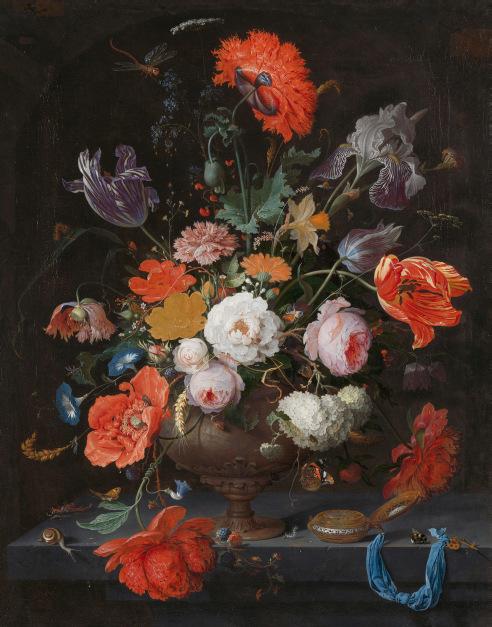
PROPERTY FROM A PRIVATE DUTCH COLLECTION (LOTS 1 & 29)
*1
A RARE PAIR OF DUTCH SILVER-MOUNTED GREEN GLASS BOTTLES AND STOPPERS
MARK OF THIJMEN / TYMEN VAN LEEUWEN, UTRECHT, 1665
Each mallet shaped with tapering neck and with string rim, the openwork sleeves on short spreading foot and embossed and chased with large flowers on scrolling leafy stems and vacant cartouche in the centre, the neck mounted above and below the string rim with a band of acanthus leaf tips applied with a chained stopper, marked on foot; on stoppers with later French control mark in use between 1798 and 1809
11.2/ in. (29 cm.)
£60,000-80,000
PROVENANCE:
Anonymous sale; Sotheby's, Geneva, 12 May 1987, lot 204.
A Private Dutch Collection.
US$82,000-110,000
€72,000-95,000
This pair of bottles is part of a very small group of silver-mounted wine bottles and the only know example made in Utrecht. Crafted by Tymen van Leeuwen who was apprenticed to Adam Van Vianen, they differ from other surviving examples by their flower design inspired by the floral still life paintings of the Utrecht painter Abraham Mignon.
Abraham Mignon, Still Life with Flowers and a Watch, circa 1660-1679 © Rijksmuseum, Amsterdam
LEARN MORE

8
THE MESSER WINE-COOLER FROM TYTHROP PARK
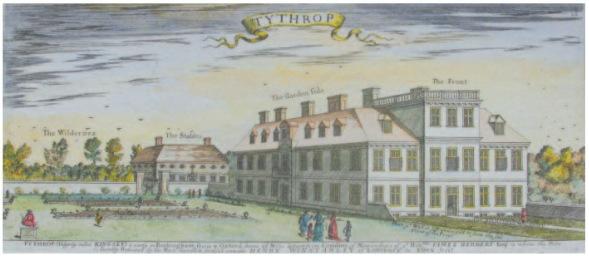
PROPERTY FROM AN IMPORTANT PRIVATE COLLECTION: SELLING WITHOUT RESERVE ■
A GEORGE II GILT-LACQUERED-BRASS-MOUNTED PADOUK WINE COOLER
CIRCA 1740
The chain-and-rosette edge above the oval tapering body mounted with two carrying handles with pierced foliate backplates, the body with cabochon waist moulding on a conforming integral base with rope-twist border carved with scrolling acanthus, the shaped apron centred to the long edge with bunches of grapes on short cabriole legs headed by foliate clasps issuing trailing harebells, terminating in boldly-carved hairypaw feet with concealed leather barrel castors
16 in. (40.5 cm.) high; 27Ω in. (70 cm) wide; 19Ω in. (49.5 cm.) deep
£100,000-150,000
PROVENANCE:
Probably commissioned by James Herbert for Tythrop Park, Buckinghamshire. By descent at Tythrop Park to A.A. W. Wykeham, Esq., D.L., J.P., sold Sotheby's house sale, 21 and 22 August 1933, lot 519.
Anonymous sale; Sotheby's, London, 26 February 1954, lot 89.
US$140,000-200,000
€120,000-180,000
Acquired from Mallett at the Grosvenor House Fair, June 1954 (invoiced 9 June 1954, the invoice endorsed by R.W. Symonds).
The Samuel Messer Collection of English Furniture, Clocks and Barometers; Christie's, London, 5 December 1991, lot 101 (£165,000 with premium).
Acquired from the above by the present owner.
EXHIBITED:
London, Victoria & Albert Museum, B.A.D.A. Golden Jubilee Exhibition, 1968, no. 157 (Catalogue, fig. 110).
LITERATURE:
P. Macquoid and R. Edwards, The Dictionary of English Furniture, rev. edn., 1954, vol. III, p. 372, fig. 3. G. Bernard Hughes, 'Wine-Cisterns and Cellarets', Country Life, 8 December 1955, p. 1381, fig. 5.
This rare cistern wine-cooler, likely commissioned by James Herbert in the late 1730s for his Palladian-style banqueting room at Tythrop, reflects the refined taste of the English Augustan age, with ornamentation inspired by Gaetano Brunetti’s 1736 Ornaments and echoing the craftsmanship of John Hodson. Its richly scrolled escutcheon and paw-footed form exemplify the elegant fusion of classical and picturesque design that flourished among elite 18th-century patrons. Later part of the celebrated Samuel Messer collection, the cooler stands as a testament to the discerning eye of a connoisseur who, guided by R.W. Symonds, helped define a golden era of British furniture collecting.
Tythrop Park, Buckinghamshire
LEARN MORE
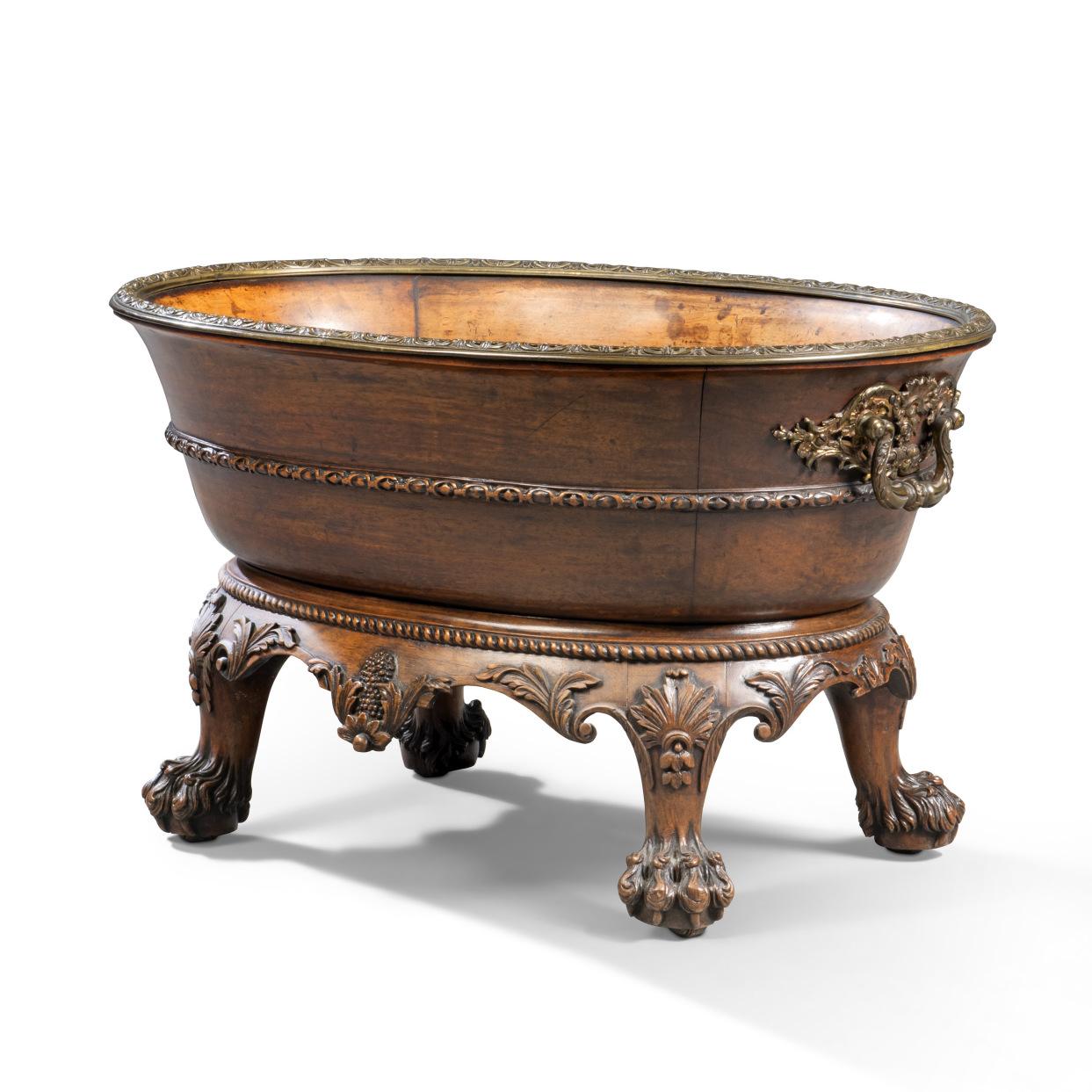
A RARE AND IMPORTANT KOVSH BY FABERGÉ
*3
A LARGE AND IMPRESSIVE GUILLOCHÉ ENAMEL AND GOLDMOUNTED NEPHRITE KOVSH BY FABERGÉ, WORKMASTER HENRIK WIGSTRÖM, ST PETERSBURG, CIRCA 1912, SCRATCHED INVENTORY NUMBER 23166
The carved nephrite body of traditional form, the gold handle with translucent opalescent enamel on sunburst guilloché ground, decorated with a gold acanthus-capped vase at the top, clasped by two caryatids, all entwined with foliage and acanthus wreaths, marked under handle with ‘Fabergé’, workmaster’s initials, 72 zolotnik gold standard (18k), and London import marks for 1912 9¡ in. (23.6 cm.) long
£150,000-250,000
EXHIBITED:
US$210,000-340,000
€180,000-300,000
New York, A La Vieille Russie, The Art of Peter Carl Fabergé: Exhibition for the Benefit of the Scholarship Fund of the Manhattan School of Music, 25 October – 7 November 1961, no. 244.
New York, A La Vieille Russie, Fabergé: Exhibition for the Benefit of the Scholarship Fund of the CooperHewitt Museum, the Smithsonian Institution's National Museum of Design, 22 April – 21 May 1983, no. 291.
New York, A La Vieille Russie, Golden Years of Fabergé. Objects and Drawings from the Wigström Workshop, 12 April – 19 May 2000.
Munich, Kunsthalle der Hypo-Kulturstiftung, Fabergé - Cartier, Rivalen am Zarenhof, 28 November 2003 – 12 April 2004, no. 166.
LITERATURE:
Exhibition catalogue, The Art of Peter Carl Fabergé: Exhibition for the Benefit of the Scholarship Fund of the Manhattan School of Music, New York, 1961, p. 53, no. 244 (illustrated).
Exhibition catalogue, Fabergé: Exhibition for the Benefit of the Scholarship Fund of the Cooper-Hewitt Museum, New York, 1983, p. 91, no. 291 (illustrated).
G. von Habsburg, M. Lopato, Fabergé: Imperial Jeweller, London, 1993, p. 87, no. 4 (illustrated).
U. Tillander-Godenhielm et al., Golden Years of Fabergé: Drawings and Objects from the Wigström Workshop, Paris, 2000, p. 121, pl. 263 and back cover (illustrated).
Exhibition catalogue, Fabergé - Cartier, Rivalen am Zarenhof, Munich, 2003, p. 196, no. 166 (illustrated).
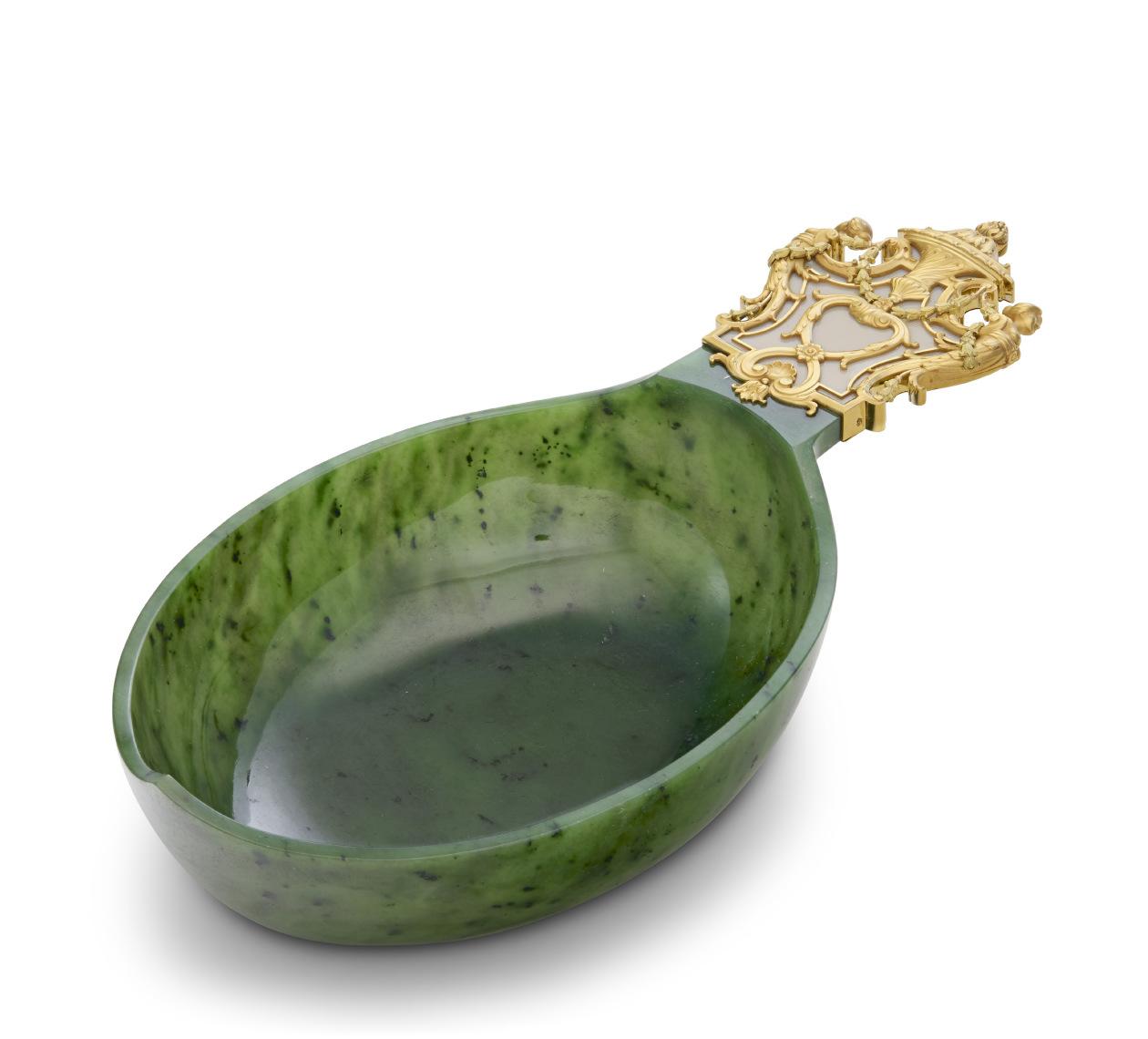

This magnificent nephrite kovsh by Fabergé reflects the resurgence of historical styles in decorative arts in the late 19th and early 20th centuries. The present rare example combines the traditional form of a Russian drinking vessel, kovsh, with a beautifully designed enamelled gold handle in neoclassical taste.
The kovsh is stamped with London import marks of 1912, and was most likely a special commission for one of Fabergé's British customers who often favoured classical design over neo-Russian style. The drawing of the present kovsh is featured in a surviving album of completed pieces by Henrik Wigström, numbered ‘13379’ and dated '19.XII.1912', the same year it was imported to London.
During the 1860s Carl Fabergé undertook his Grand Tour of Europe, before taking over his father's jewellery firm in 1872. Fabergé's interest in historical movements led him to visit numerous cities and princely collections, which served as inspiration for his future creations. Fabergé’s workmasters often reinterpreted European art as well as traditional Russian crafts.
A design of a candelabrum in the form of an urn with caryatids, attributed to a British architect Henry Holland (1745–1806), has some striking similarities with the design of the handle on the present lot, and might have been a source of inspiration (in the collection of the Metropolitan Museum, New York, inv. 61.516.1).
Other comparable nephrite kovshes by Fabergé of this size are housed in important museums and royal collections around the world and were commissioned for imperial presentation. A kovsh of similar size with the cypher of Nicholas II on the handle, which was presented by the tsar to the French Ambassador to Russia in 1906, is part of the Musée des Arts Décoratifs collection in Paris (inv. 2599). Another large nephrite kovsh with the handle in the rococo style is in the Fabergé Collection of His Late Majesty King Chulalongkorn of Thailand (see
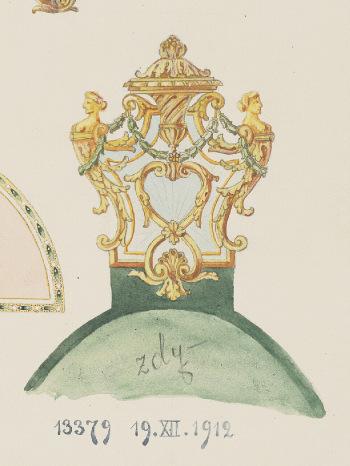
Exhibition Catalogue, The Faberge Collection of His Late Majesty King Chulalongkorn of Thailand, Bangkok, 1983, p. 104). One more comparable kovsh with a double-headed eagle on the handle, which is believed to be an imperial presentation gift, is in the Walters Art Museum, Baltimore, Maryland (inv. 57.1076).

Candelabrum in the form of an urn clasped by caryatides and candle branches. Attributed to Henry Holland (17451806) ©Metropolitan Museum of Art, New York.
The drawing of the present lot in Henrik Wigström’s album of completed pieces.
(reverse of the handle)
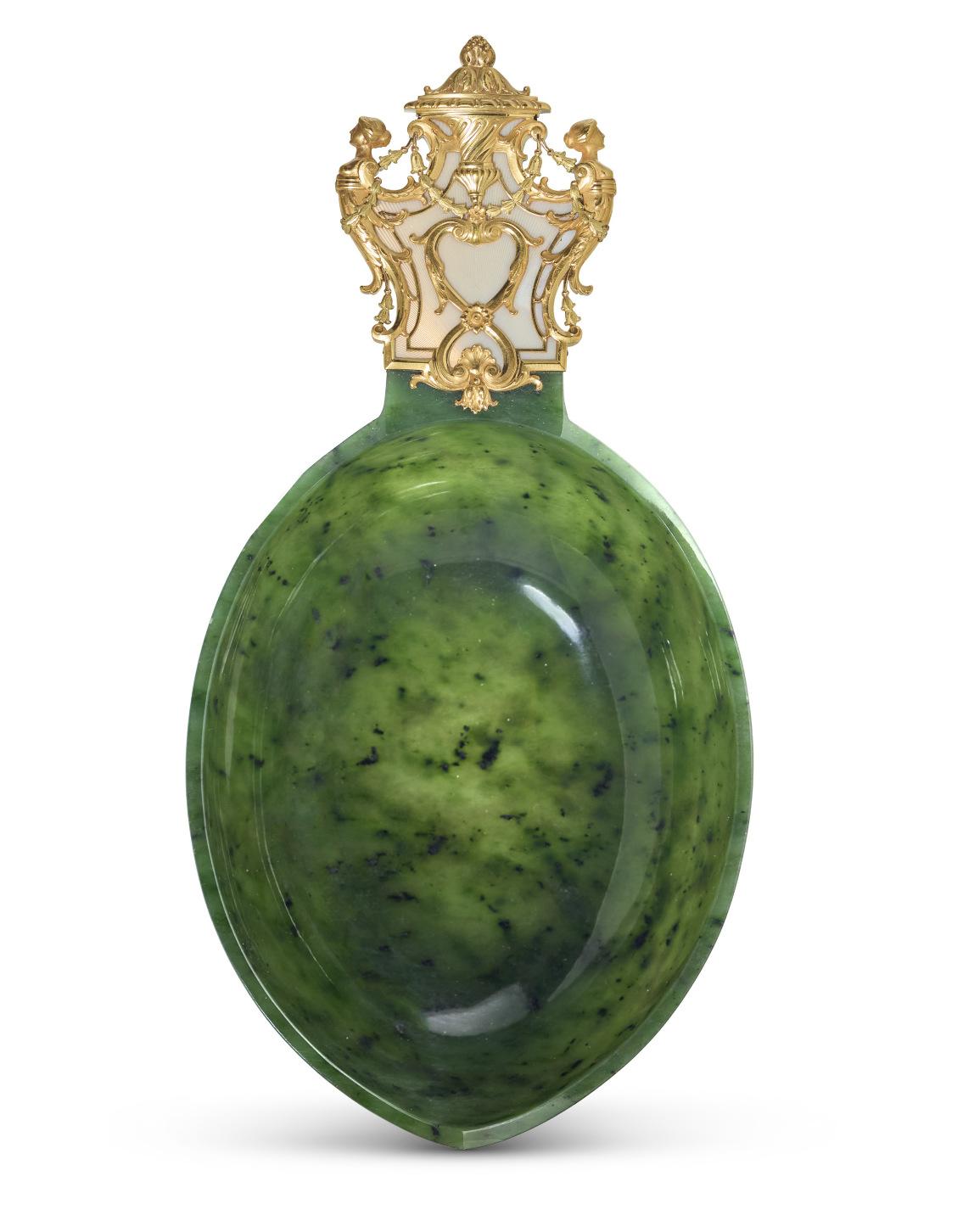
THE TYTTENHANGER GILT-GESSO TABLES
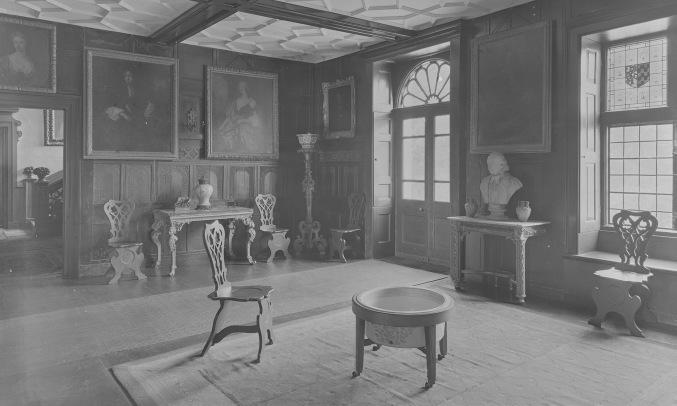
Entrance Hall, Tyttenhanger House, Hertfordshire,
PROPERTY OF AN AMERICAN PRIVATE COLLECTOR
■*4
A PAIR OF GEORGE I GILT-GESSO AND SPECIMEN MARBLE SIDE TABLES
IN THE MANNER OF JAMES MOORE, CIRCA 1720-25, THE TOPS ROMAN, CIRCA 1770 AND ENLARGED
The rectangular tops inlaid with a variety of hexagonal marble and hardstone specimens including lapis lazuli, alabaster, Porfido serpentino antico, amethyst, Spanish broccatello, Serpentino di Genova and Granito rosso antico, above a foliate-decorated frieze with a punched ground, on hipped cabriole legs headed by plumed masks and scrolling acanthus terminating in scroll feet, the tops originally with verde antico borders and separate slab to back edge and probably enlarged to current form post-1972, regilt 31æ in. (80.5 cm.) high; 47æ in. (121 cm.) wide; 30 in. (76 cm.) deep (2)
£150,000-250,000
PROVENANCE:
US$210,000-340,000
€180,000-300,000
The collection of Elizabeth Scot Yorke (née Lindsay), Countess of Hardwicke (1763–1858) at Tyttenhanger House, Hertfordshire, Thence by descent to the Earls of Caledon until sold, Tyttenhanger House: The Contents; Ralph Pay and Ransom, London, 27-29 June 1972, lot 405 (£5,500).
With Mallett & Son Antiques, London and subsequently acquired by Gerald Hochschild.
The Hochschild Collection of Highly Important English Furniture; Sotheby's, London, 1 December 1978, lot 16.
Acquired from the above through Hotspur Ltd. and thence by descent.
LITERATURE:
Inventory & Valuation of Furniture, Fixtures and Effects at Tittenhanger [sic] House St Albans, the property of the late Countess Dowager of Hardwicke, 20 July 1858, p. 67 (Hertfordshire Archives Office D/ECd (Add) F38).
An Inventory of Furniture, China, Glass, Books and other effects at Tyttenhanger House near St Albans, The Property of the Right Honourable Countess of Caledon and let to H. W. Eaton Esq., July 1864 (Hertfordshire Archives Office D/ECd (Add) E15).
H. Avray Tipping, ‘Tyttenhanger, Hertfordshire, The Seat of the Earl of Caledon – II’, Country Life, 11 October 1919, p. 454, fig. 1.
H. Avray Tipping, ‘Furniture at Tyttenhanger’, Country Life, 8 November 1919, p. 590, fig. 1 (showing tops in original form).
H. Avray Tipping, English Homes, Period IV – Vol. I, Late Stuart 1649-1714, London, 1920, p. 77, fig. 108A.
L. Synge, Mallet’s Great English Furniture, London, 1991, p. 86, pl. 90.
These fine gilt-gesso pier tables, the nascent cabriole legs animated by masks with plumed headdress, typify the output of James Moore who became cabinet-maker to King George I. The tables are recorded in an inventory of the contents at Tyttenhanger House, Hertfordshire, taken on the death of Elizabeth Dowager Countess of Hardwicke in 1858. While the 18th century history of these magnificent tables remains uncertain, there are several tantalising strands of ancestry from which they may descend. These include Edward Harley, 2nd Earl of Oxford and the Earls of Hardwicke at Wimpole Hall, and Sir Thomas Pope Blount, 2nd Bt., grandson of Sir Henry Blount, the builder of Tyttenhanger.
The
showing one of the present tables in situ, 1919 © Country Life / Future Content Hub Publishing
LEARN MORE
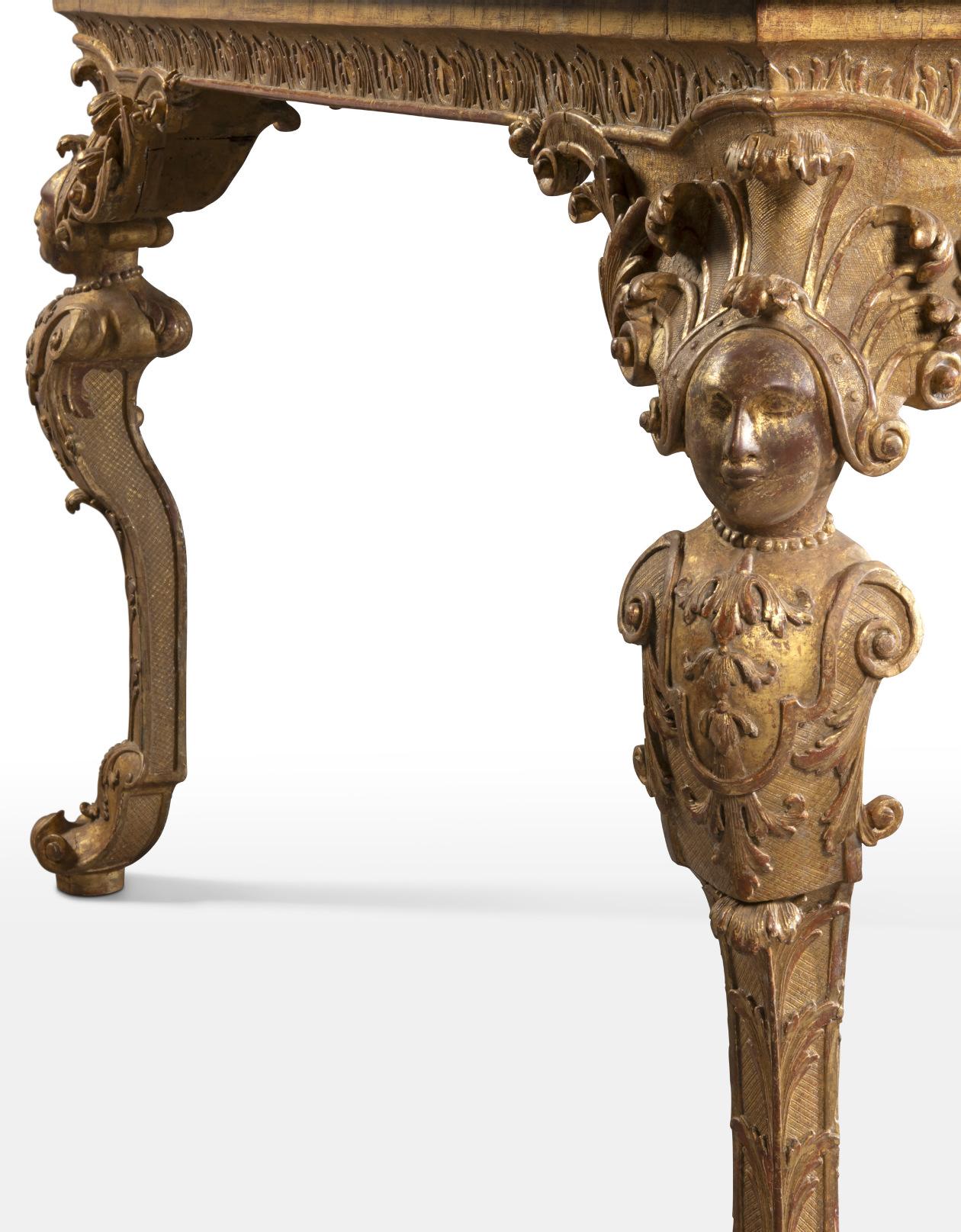
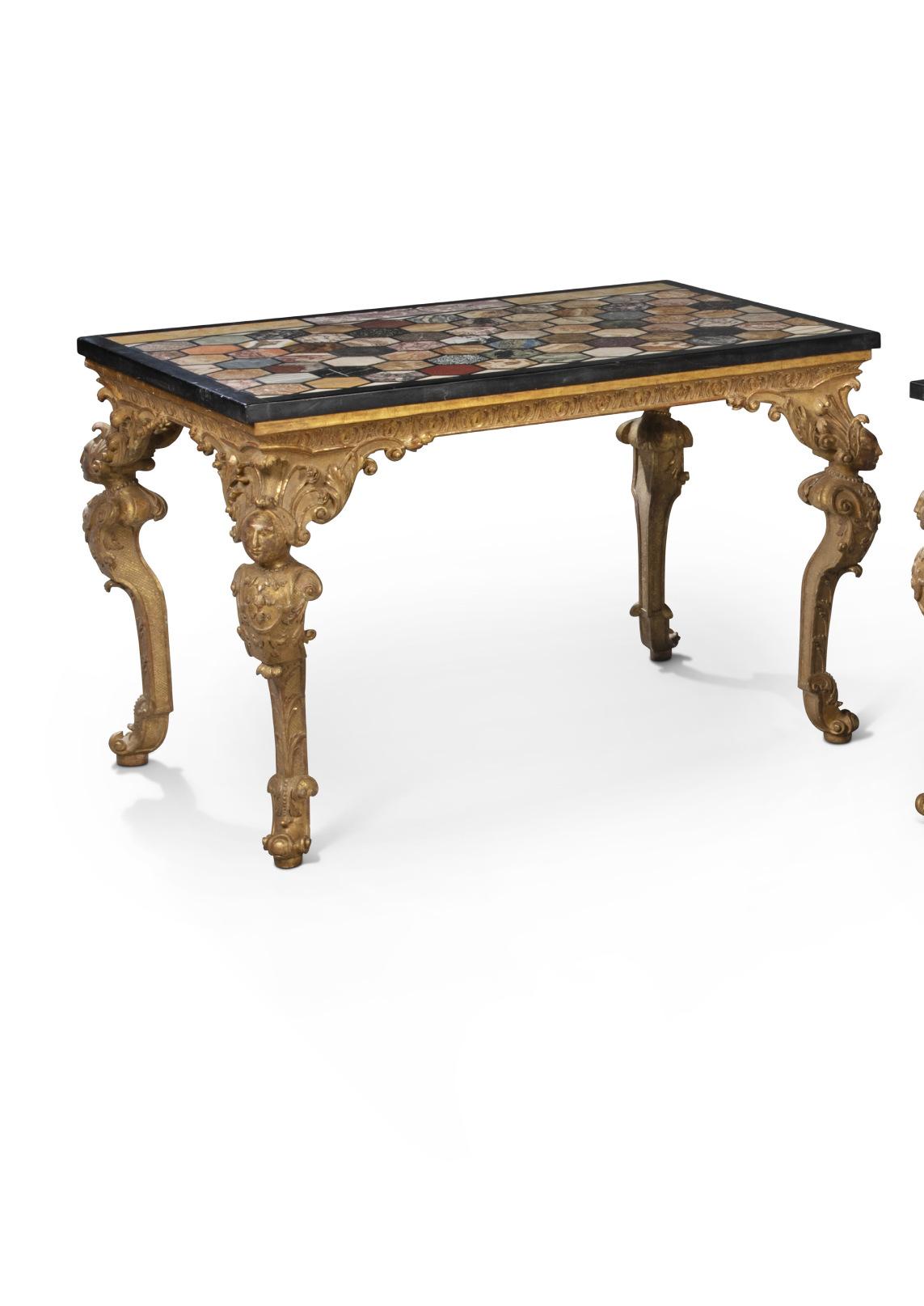

THE HAMILTON PALACE AGATE EWER AND LAPIS LAZULI TAZZA LOTS 5 & 6
PROPERTY
5
AN ORMOLU AND SILVER-GILT MOUNTED CARVED AGATE EWER AND BASIN
THE AGATE EWER BASIN LATE 17TH CENTURY, THE ORMOLU MOUNTS ATTRIBUTED TO PIERRE-PHILIPPE THOMIRE, CIRCA 1789-1800
The ewer with a lobed body with acanthus decoration in relief and a carved dolphin handle above a baluster and carved foliate stem and on an oval spreading base mounted with a spirally turned collar rim and with original late 17th century silver mounts; above a lobed and foliate-engraved oval basin supported by ormolu mounts of four kneeling tritons issuing from scrolling foliage supporting the ewer and four winged sphinxes with scrolling tails terminating in flower heads, on a re-entrant base centred by a fruiting finial supporting the basin
19 ½ in. (42 cm.) high; 12 ½ in. (32. cm.) wide; 10 ½ in. (27 cm.) deep (2)
£500,000-800,000
PROVENANCE:
US$680,000-1,100,000
€600,000-950,000
Anonymous sale organised by the marchands experts Paillet and Delaroche, Notice de Tableaux, Gouches, Aquarelles, Dessins et Estampes..., Paris, 20 July 1801, lot 47.
Acquired by Alexander Douglas-Hamilton, Marquis of Douglas and later 10th Duke of Hamilton (d.1852), possibly in Russia, when Ambassador in St Petersburg, circa 1807.
Thence by descent to William, 12th Duke of Hamilton (d. 1895), Hamilton Palace, Lanarkshire;
sold Christie's, London, 17 June-20 July 1882, lot 1436 (£850 10s) to Christopher Beckett Denison;
sold Christie's, London, 6 June 1885, lot 777 (£573 6s) to William, 5th Earl of Carysfort, Elton Hall, Cambridgeshire and thence by descent, until sold Christie’s, London, 7 July 2005, lot 445.
The Taste of the Royal Court: Important French Furniture and Works of Art from a Private Collection; Christie's, London, 9 July 2015, lot 20, where acquired by the present owner (£1,046,500 including premium).
LITERATURE:
Russian Lists, circa 1807, Hamilton Archives/ 332/ M12.30.
Art Furniture Purchased by 5th Earl [of Carysfort], manuscript, circa 1885. P. Humfrey ed., The Reception of Titian in Britain, Belgium, 2013, p. 143.
This magnificent and highly-prized agate ewer and basin is a tour-deforce of exotic, translucent agate, possibly commissioned for the Grand Dauphin's personal collection in the late 17th Century, and later owned by some of the greatest collectors in Europe following the French Revolution.
The ewer and basin is first described in an 1801 sale catalogue of an anonymous, but important collection of exotic hardstones, objets d'arts and fine furniture and paintings. Highlighted on both the title and in
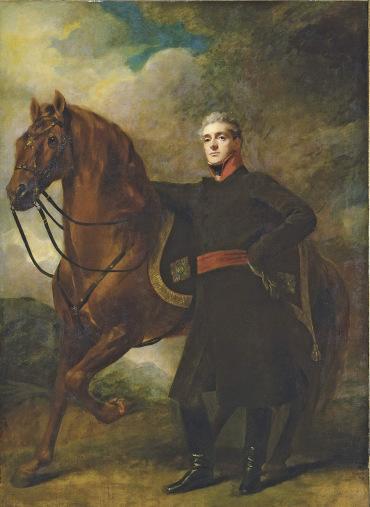
the introduction to the sale, the ewer and basin is described under number 47. Interestingly, it was said to be non doré (ungilded): The ewer next appears in an undated and unaddressed shipping list in the Hamilton archive (Hamilton MSS Misc. M12.30). Written in French but priced in roubles, this shipping list is believed to be of works of art brought back from Russia by Alexander Hamilton, 10th Duke of Hamilton (1767-1852) when he served as the British Ambassador to Russia in St Petersburg between late January and June 1807.
The Duke of Hamilton's remarkable schatzkammer was comprised principally of sumptuously mounted hardstones, many of which have a direct association with the French Royal collections. These factors open up the possibility that several of the works of art on the Hamilton Russian shipping lists, especially the hardstones, may originally have formed part of the collections assembled by French royalty, most notably the Grand Dauphin.
Henry Raeburn, Portrait of Alexander Douglas-Hamilton, 10th Duke of Hamilton and 7th Duke of Brandon (1767-1852), circa 1812-1823, Private Collection.
LEARN MORE
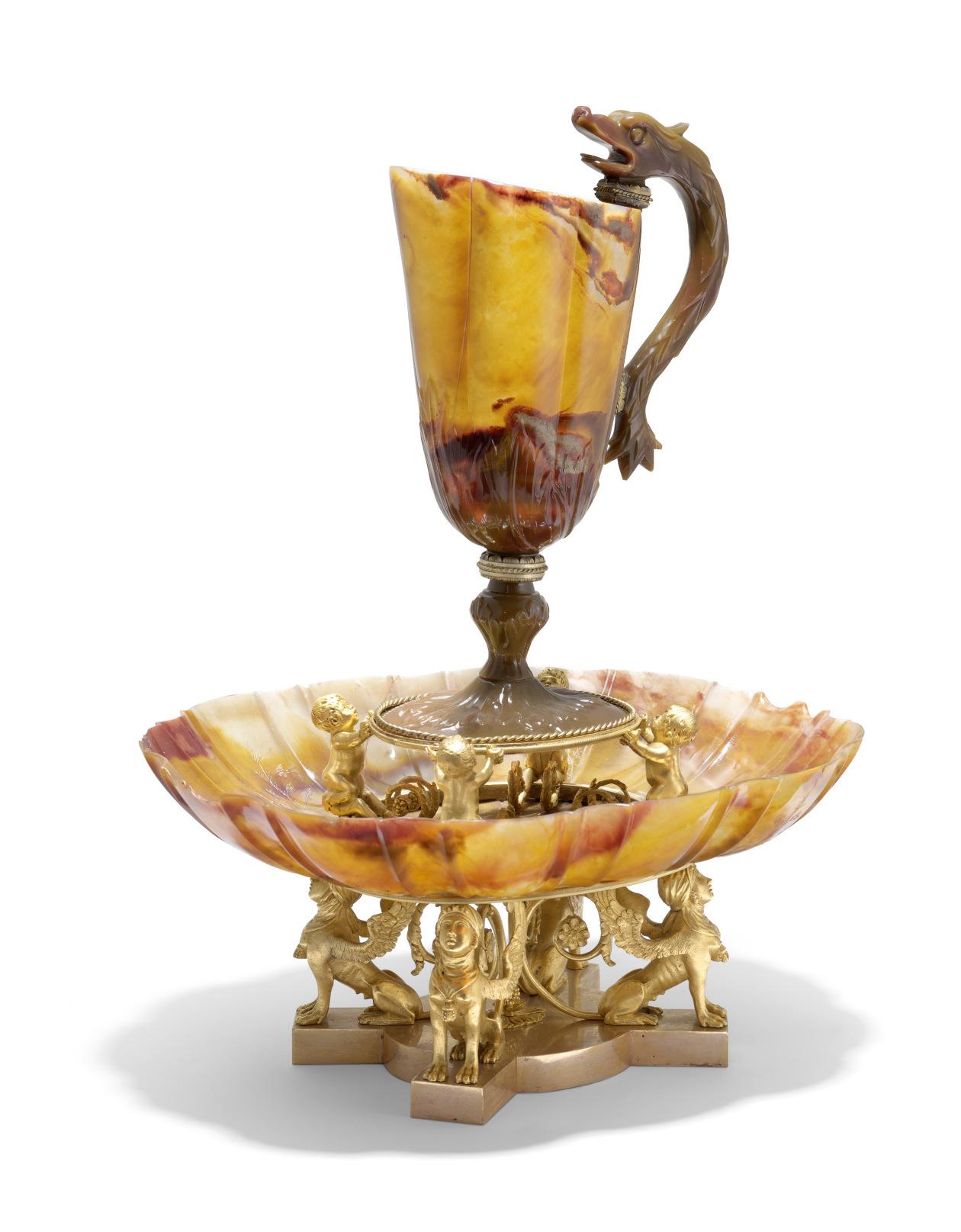
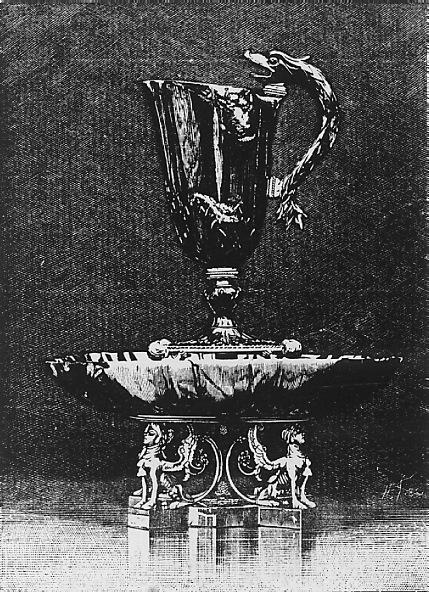
THE GRAND DAUPHIN'S COLLECTION OF HARDSTONE OBJETS D'ARTS
The striking Dauphin agate handle on the present ewer is extremely similar to the open-mouthed, leaping dolphin of the coat-of-arms of the Dauphin of France, an emblem repeatedly seen in hardstone objects known to have belonged to Louis, the Grand Dauphin, son of Louis XIV. The Grand Dauphin formed an extraordinary treasury of hardstone objects of jasper, agate, rock crystal and lapis-lazuli, purchased predominantly from Parisian dealers between 1681 and 1689, and mounted in gold or silver-gilt.
The ewer and basin, both with agate of the same fiery, volcanic natural colourings, were likely carved in northern Italy during the period when the Grand Dauphin was collecting most abundantly in the 1680s. A related rock crystal salt cellar in the form of a dolphin, which is mounted with silver bands similar to those on the present ewer was recorded in the 1776 inventory of the Grand Dauphin and is preserved in the Prado, Madrid. When the Grand Dauphin died in 1711 the Treasury was divided - his second son the King of Spain inherited one fifth of the collection, while his two other sons inherited one sixth of the collection, and the rest was auctioned at Meudon in July 1711.
THE ORMOLU MOUNTS AND 1801 SALE CATALOGUE
The superbly chased mounts, executed by a master ciseleur, are designed in the unusual 'arabesque' style, and are likely the work of Pierre-Philippe Thomire (1751-1833). The use and style of the classically-inspired sphinxes and the characterisation of the faces of the tritons can be seen in comparable work by Thomire from this period (M. Ottomeyer & P. Pröschel, Vergoldete Bronzen: Bronzearbeiten des Spätbarock und Klassizismus, Munich, 1986, vol. II, pp. 657-665; J. Niclausse, Thomire, Fondeur-Ciseleur (1751-1843) Sa Vie - Son Oeuvre, Paris, 1947, pls. 10-12 and 19).
The description of the mounts in the 1801 sale catalogue as non doré suggests that the mounts were unfinished in 1801. It is unlikely that they were purposefully left ungilded and it is possible that the ciseleurdoreur responsible had not completed the work in 1801 or the years following the Revolution.
THE DUKE OF HAMILTON’S RUSSIAN LISTS OF 1807
Alongside the agate ewer and basin, the Russian shipping lists of circa 1807 record a number of ormolu or gold-mounted hardstone objects of such extraordinarily rich taste and distinguished historical associations that would suggest that Hamilton was either presented with them as a diplomatic gift en bloc, or that he purchased them en bloc from an imperial or aristocratic schatzkammer.
A number of the objects on these lists have now been identified including the present lot and lot 6 in this sale, recorded as La Cassolette de Lapis Lazuli monté en bronze. This ormolu-mounted lapis lazuli tazza was almost certainly mounted by the same ciseleurdoreur
The superlative collections ultimately gathered at Hamilton Palace by 1882 - as a result of both Hamilton's and his friend William Beckford's inheritances - led one commentator to describe it as 'One of the noblest residences in Europe.. and probably containing a greater collection of rare works of art than the abode of any man under the rank of sovereign..'.
1882 TO THE PRESENT DAY
Christie's dispersal of the Hamilton Palace Collection was amongst the greatest auctions of furniture and works of art ever held. The ewer and basin, as well as the lapis lazuli tazza in this sale, also included on the Russian list, were purchased in the Hamilton Palace sale by Christopher Beckett Denison, who sold them shortly afterwards in 1885; in his sale both lots were then purchased by William, 5th Earl of Carysfort, and recorded in a manuscript of his purchases for that year.
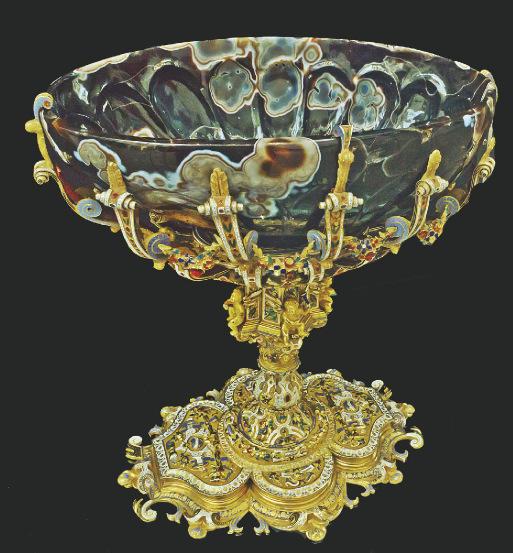
The ewer and basin engraved in Christie’s 1882 catalogue of the Hamilton Palace sale
The Hamilton-Rothschild Tazza, National Gallery of Scotland
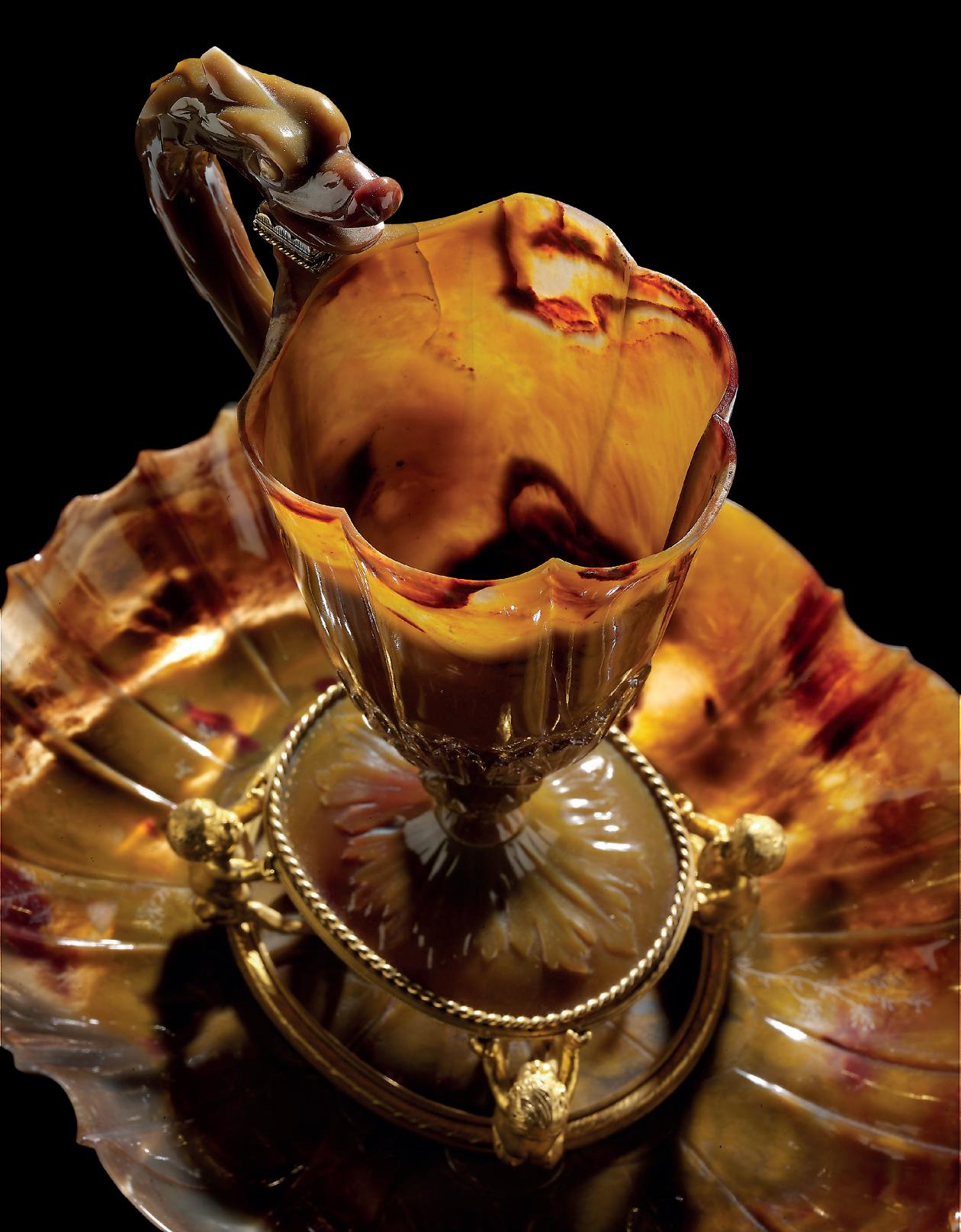
THE HAMILTON PALACE AGATE EWER AND LAPIS LAZULI TAZZA LOTS 5 & 6
PROPERTY FROM AN IMPORTANT PRIVATE COLLECTION
A LATE LOUIS XVI ORMOLU-MOUNTED CARVED LAPIS LAZULI TAZZA
THE LAPIS LAZULI, ITALIAN, LATE 16TH OR 17TH CENTURY, THE MOUNTS ATTRIBUTED TO FRANCOIS REMOND OR PIERRE-PHILIPPE THOMIRE, CIRCA 1792
The circular lobed dish flanked by acanthus-wrapped and eagle-headed supports each issuing spirally-twisted tendrils and terminating in paired legs with hoof feet, centred by a berried staff and scrolled serpent, above an oval platform with stiff-leaf and milled rim supported by four recumbent lions each on a mille raies plinth, the underside with a white circular paper label and remains of a red circular paper label, old restorations to the lapis, including a circa 5 in. (13 cm.) spliced section to the rim of the dish, probably dating from the time of the late 18th century remounting 18 in. (46 cm.) high; 111/4 in. (29 cm.) wide
£400,000-600,000
PROVENANCE:
The Lapis Tazza:
Almost certainly:
US$550,000-810,000
€480,000-710,000
Randon de Boisset, sold in Paris, 27 February 1777, lot 468 (1822 livres to the marchand Langlier).
The Boileau sale, sold in Paris, 1782, lot 209 (2192 livres). The Le Brun sale, sold in Paris, 11 April 1791, lot 404 (repurchased by Le Brun for 2,200 livres).
The Lapis Tazza and its mounts:
Almost certainly acquired in Russia, by Alexander Douglas-Hamilton, Marquis of Douglas and later 10th Duke of Hamilton (d.1852) when Ambassador in St Petersburg, circa 1807, and certainly at Hamilton Palace by 1825.
Thence by descent to William, 12th Duke of Hamilton (d. 1895), Hamilton Palace, Lanarkshire,
sold Christie's London, 17 June - 20 July 1882, lot 1430 (£320 50s) to, Christopher Beckett Denison; sold Christie's London, 6 June 1885, lot 778 (£192 18s 9) to William, 5th Earl of Carysfort, Elton Hall, Cambridgeshire and thence by descent, until sold to the current owner in 2015.
LITERATURE:
Circa 1807, Russian Lists, ‘No. 6': 'La Cassolette de Lapis Lazuli monté en bronze' [together with a Chinese jade hookah mounted in gilt bronze and 3 rock crystal vases mounted in bronze and gold, costing 6000 roubles] Hamilton Archives/ 332/ M12.30
1825 Inventory of Hamilton Palace, p. 31, State Bed Room 'An ornamental Cup standing on rich figures with a Glass Globe over it, of Lapis Lazuli, £70' (Hamilton Archives/332/M4.70)
1852-3 Inventory of Hamilton Palace, p. 142, Drawing Room 'A Lapis Lazuli Cassolette on a stand of the same supported by richly chased gilt bronze standard with eagle head handles and the Lapis base encased in gilt Bronze rim with Lion supports glass shade over Do.' Hamilton Archives/2177/Vol. 1228
1853 Fire Insurance Inventory of Hamilton Palace, p. 47. Drawing Room 'A Lapis Lazuli Cassolette on a stand of the same Supported by Gilt Bronze Standards with Eagle head and the stand below Encased in a Rich Gilt Bronze Rim and Lion Supports under Do., £80' (Hamilton Archives/2177/Bundle 2714)
1876 Inventory of Hamilton Palace, p. 95, Old State Bedroom 'A circular fluted Dish of Lapis Lazuli mounted on gilt Metal Stand – the Base an oval piece of Lapis Lazuli on four gilt Metal Lions, under Glass Shade' (Hamilton Estate Papers/4551)
Art Furniture Purchased by 5th Earl (of Carysfort), manuscript, circa 1885.
This magnificent and highly prized lapis lazuli tazza is first described in an undated and unaddressed shipping list in the Hamilton archive (Hamilton MSS Misc. M12.30). Like the preceding lot in this sale and the other schatzkammer hardstones from Hamilton Palace, this tazza was presumably dispersed during the various Revolutionary sales, brought together by a Parisian marchand-mercier and remounted by a leading ciseleur-doreur, such as Pierre-Philippe Thomire or François Remond, in the prevailing Neo-classical taste, presumably with the express intention of selling it en bloc to the richest market in the 1790s, the Imperial Court of Russia.
THE RARITY OF LAPIS LAZULI OBJECTS IN 17TH AND 18TH CENTURY INVENTORIES
The fluted basin of the Hamilton lapis tazza stylistically dates from circa 1600 and echoes the lapidary masterpieces purchased by Louis XIV, his son the Grand Dauphin and Cardinal Mazarin. However, the scale of the Hamilton tazza – with a diameter of 26.5 cm - as well as its depth of colour, is of great rarity and perhaps unique.
The principal reason for lapis lazuli’s historic rarity is that it came from so far away – Sar-e-Sang in Afghanistan - and with no other nearer mines, it has been prized since antiquity. Interestingly, only one type was sought after: the dense blue with gold powder (called "the male one" in French Dictionaries), while the pale white variety was largely rejected. In early inventories, carved objects in lapis lazuli executed mainly in Milan and Rome were very rare and expensive, valued between 10 and 50 pistoles each (100-500 livres), the grande nef of the Dauphin being valued at the huge price of 350 pistoles (3500 livres). In Louis XIV’s collections, out of more than 700 hardstone objects (350 jasper and agate vases, 384 rock crystal pieces), only 14 were made of lapis – and these were predominantly small cups ("tasses rondes ou ovales") between 10 to 15 cm. wide, some being shell-shaped and the only comparable large scale example to this lot being the "grande nef" de lapis, which is now in the Louvre.
LEARN MORE
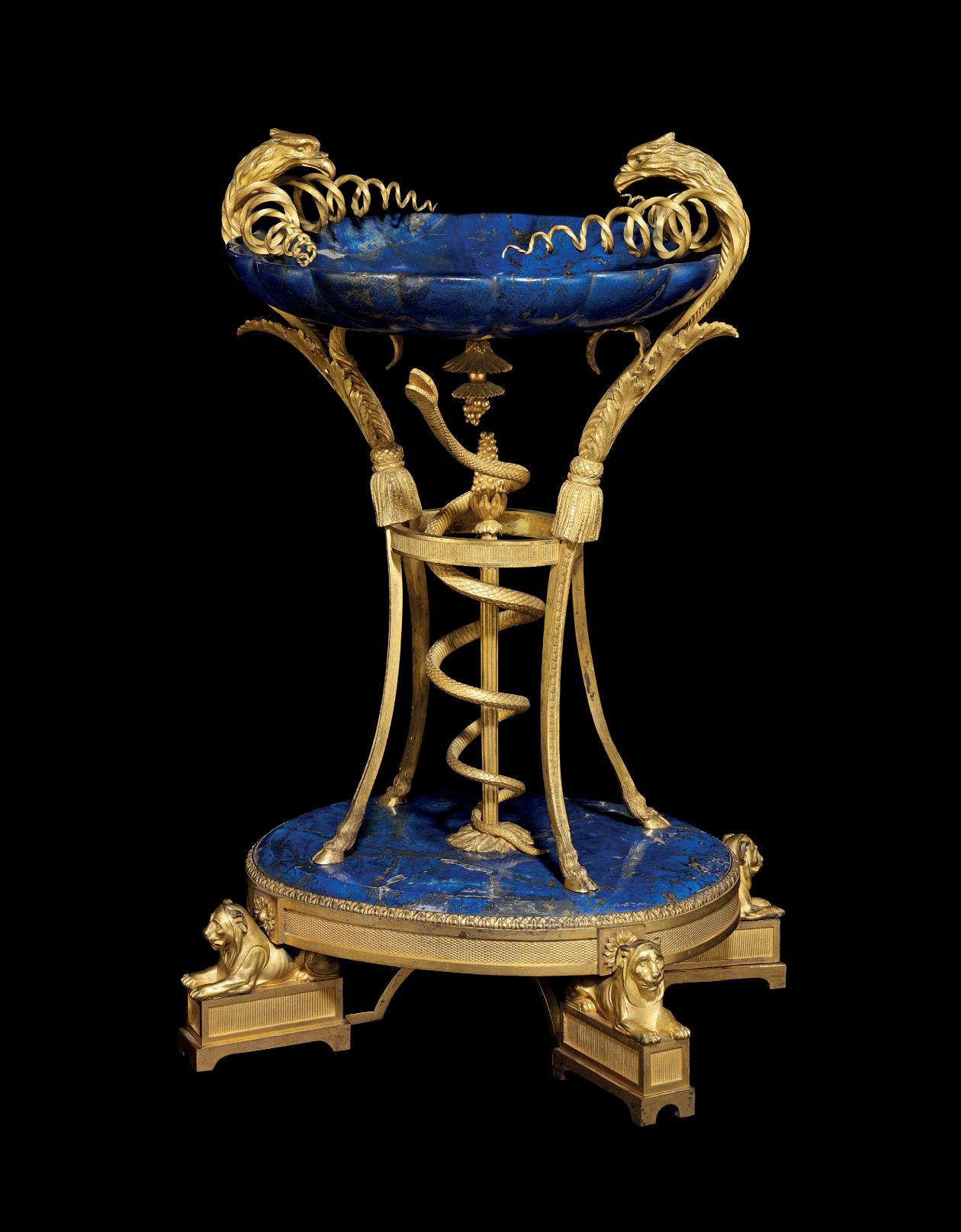
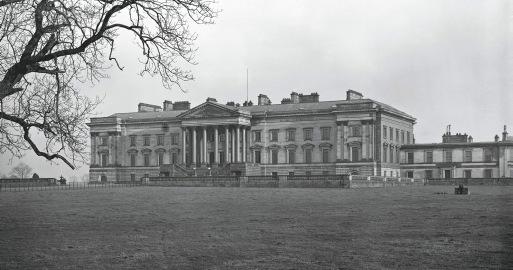
RANDON DE BOISSET’S LAPIS TAZZA
The Hamilton lapis tazza - being 26.5 cm. diameter and 4 cm. high overall - is almost certainly that first described with different mounts in the sale of the celebrated collections of Randon de Boisset on 27 February 1777. References to lapis objects in 18th Century sale catalogues are extremely rare. Apart from a vase in the Watteville sale in 1779, the only piece of this scale - which appears to be identical in both size and design - is that which Randon de Boisset is thought to have brought back from Rome and had mounted in Paris. This same lapis tazza was resold again in the Boileau sale on 4th March 1782 and again for a third time in the Le Brun sale of 11 April 1791. Such was the rarity and value of so precious a specimen that - even though it was richly mounted by Randon de Boisset ("socle à trois enfants richement ciselé et doré") and fetched a huge price on both occasions - in the following decade it was again re-mounted, presumably by the dealer Le Brun, this time in the latest Neo-Classical fashion in "or mat", the matt mercury gilding introduced by Pierre Gouthière.
The catalogue descriptions in both the Randon de Boisset sale and the Le Brun sale underline the suitability of such an extraordinary lapis object to be placed dans le trésor d’un souverain. However it is unlikely that the ormolu mounts added by Le Brun between the 1782 and 1792 sales are still those on the Hamilton tazza to this day. Whilst the chimères mentioned could refer to the recumbent lion feet, only 3 rather than 4 are noted. There is also no mention of the lower oval lapis plaque. Finally, it is measured as 6 pouces high in the Le Brun sale, which seems too short.
It is also possible that the purchaser in the Le Brun 1792 sale further enriched the piece by adding the oval lapis plaque to the base. It is interesting to note, therefore, that the next lot in the Le Brun sale was a lapis cup on an oval plaque of lapis.
The tazza itself was acquired back by the dealer Le Brun, whilst the following lot was bought by another fellow marchand, Julliot. It is possible that the marchands-merciers would have done the same again to enrich it in 1791, to accord to the tastes of an Imperial Russian patron. The French market was struggling for obvious reasons, and the only outlets for the French luxury trade were England, the Spanish Royal court and Russia.
THE LAPIDARIST’S ART
Reputedly bought back from Italy by Randon de Boisset, presumably in 1762/3, the Hamilton lapis tazza could certainly have been carved in the lapidary workshops in either Rome, Florence or Milan. The dazzling gold inclusions, streaks of light blue running through the stone and the delicately carved fluted borders of the basin all bear comparison to a lapis bowl from the cabinet of Louis XIV now in the Musée National d’Histoire Naturelle, Paris that was carved in Florence at the end of the 16th century.
THE MOUNTS: PIERRE-PHILIPPE THOMIRE OR FRANCOIS REMOND
The superbly chased mounts, executed by a master ciseleur-doreur, are of great technical virtuosity and executed in d’or mat. The overall tripod form with entwined serpent and spirally-twisted ribbons closely recalls the documented oeuvre of Pierre-Philippe Thomire (1732-1832) – as can be seen on the pair of tripod breccia marble vases in the Wallace Collection (F342-3), a pair of green jade coupes supplied by Daguerre to the Princesse Kinsky in 1786 (now in the Louvre) and the celebrated Sèvres vases/ jardinières in the Royal Collection at Windsor, the J. Paul Getty Museum, as well as that sold in the Boulle to Jansen collection, Christie’s London, 11 July 2003, lot 10.
By contrast, the distinctive eagle’s head terminals and tasseled fringes recall the production of François Rémond (d. 1812), one of the foremost doreur sur metaux of the Louis XVI period. Like Thomire, Rémond also collaborated extensively with Daguerre, to whom he supplied work between 1778 and 1792 valued at the staggering sum of 920,000 livres – and these same eagle’s head terminals featured on candelabra designs also supplied by Daguerre for the Princess Kinsky (see C. Baulez in 'Le Luminaire de la Princesse Kinsky', L'Objet d'Art, May 1991, pp. 84-99).
Like lot 5 in this sale, this tazza appears on the Duke of Hamilton's 'Russian Lists'.
As the Russian lists are thought to date from 1806-7, they pre-date the financial inheritance that came with both Hamilton’s succession to the Dukedom in 1819 as well as his marriage to William Beckford’s daughter, Susan Euphemia, in 1810. It seems likely that these highly expensive treasures were thus a diplomatic gift to the Ambassadorbefore he had inherited the means to lavish money on precious works of art.
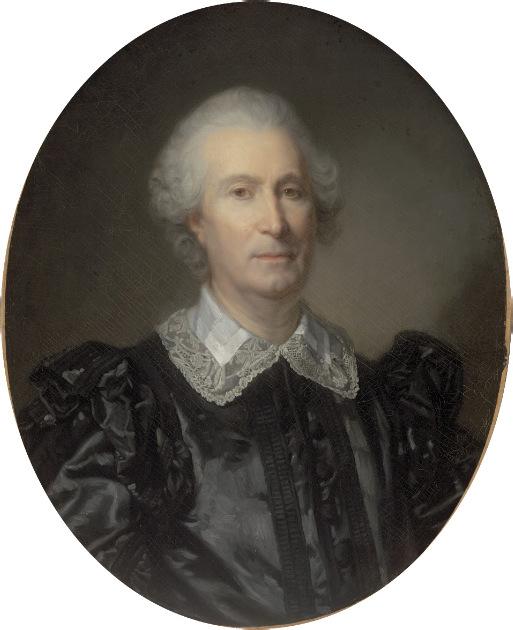
Hamilton Palace, South Lanarkshire, Scotland © Country Life.
Jean-Baptiste Greuze, Portrait of Paul Randon de Boisset, circa 1775 Museum of Fine Arts, Budapest

AN ARCHAISTIC HERM FROM WEST WYCOMBE PARK
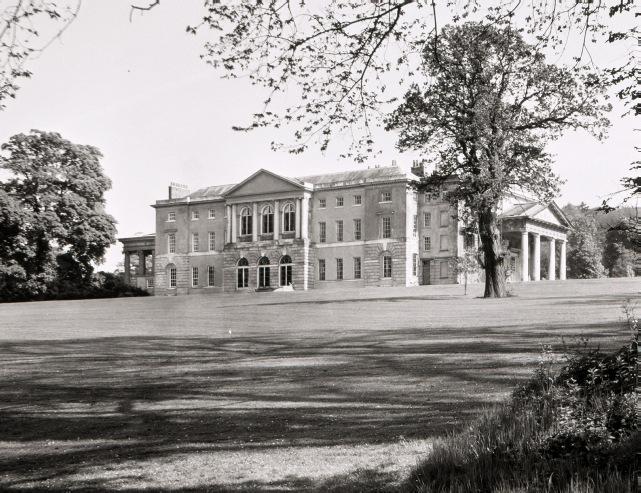

A ROMAN ARCHAISTIC BRONZE HERM HEAD OF HERMES PROPYLAIOS
CIRCA 1ST CENTURY B.C. - 1ST CENTURY A.D.
The god with flowing beard and moustache, hair arranged in three rows of archaic-style tight curls, wearing a fillet, pupils recessed for now-missing inlays.
9 in. (23cm.) high
£80,000-120,000
PROVENANCE:
US$110,000-160,000
€96,000-140,000
Probably acquired by Sir Francis Dashwood, 2nd Baronet (1708-1781), West Wycombe Park, Buckinghamshire, circa 1729 or after.
Thence by descent to Sir Francis Dashwood, 11th Baronet (1925-2000), West Wycombe Park.
The Property of Sir Francis Dashwood, Bt.; Christie's, London, 16 March 1977, lot 232 (when it was mounted on a later yellow marble bust, catalogued as 17th Century A.D.).
Swiss private collection.
Antiquities; Christie's, London, 2 May 2013, lot 114.
LITERATURE:
Country Life, 13th May 1933, illustration of "The Music Saloon" on p. 495.
Sir Francis Dashwood (1708–1781) was an English aristocrat known for his love of classical art, gained during his Grand Tour of Europe. At his estate, West Wycombe Park, he created a striking neoclassical landscape filled with temples and follies, and co-founded the Society of Dilettanti to promote the study of ancient art.
This bronze head of Hermes Propylaios, the Greek god of boundaries and transitions, was once part of the collection at West Wycombe Park. Modeled in the Roman tradition with a blend of Greek archaic and classical features, it also embodies the Neo-Classical fascination with antiquity and the symbolic power of ancient gods.
The Music Saloon ©Country Life/Future Publishing Ltd. 1933 The present lot appears on the mantelpiece mounted on a bust.
The north front of West Wycombe ©Country Life/Future Publishing Ltd. 1974
LEARN MORE
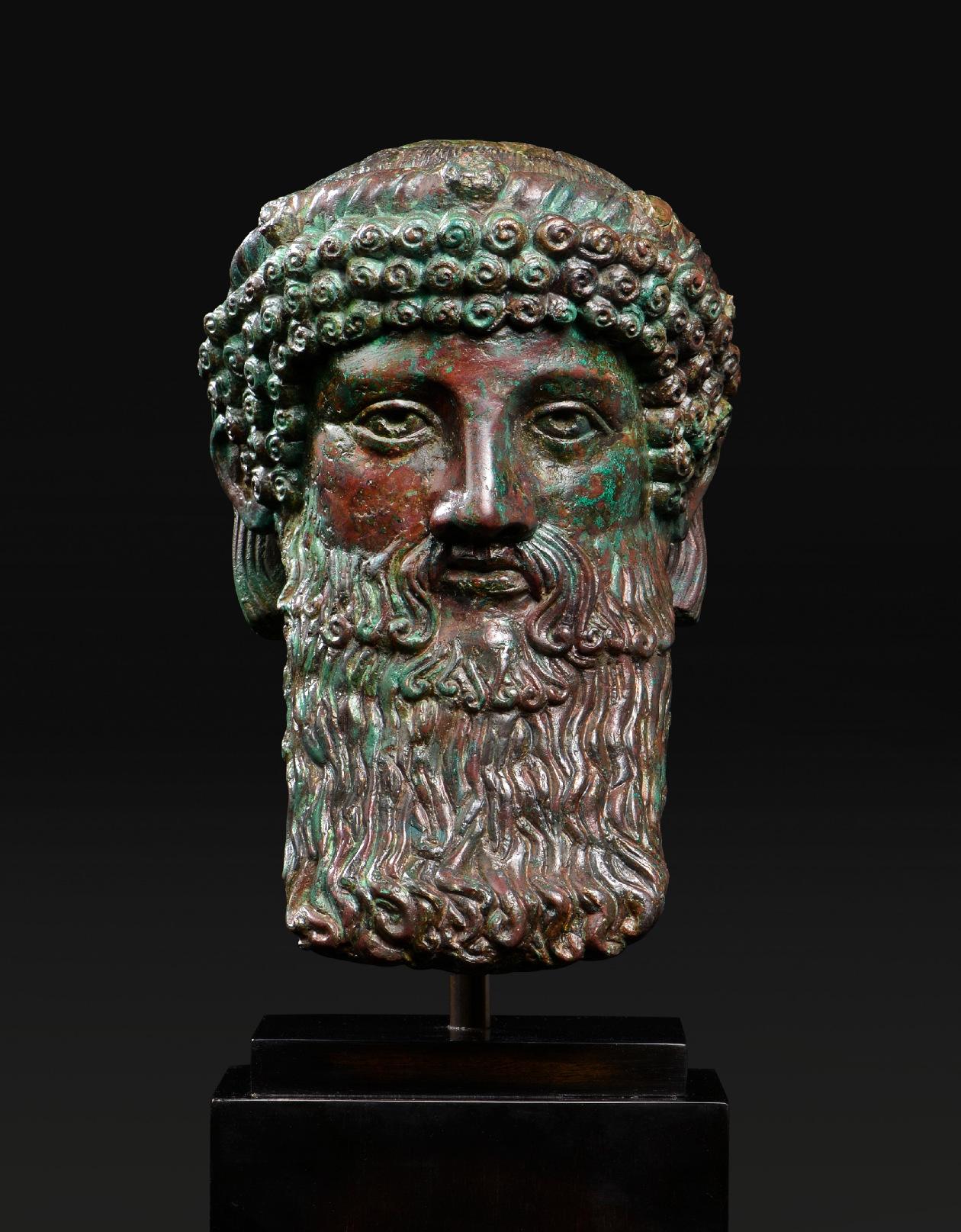
LEDA AND THE SWAN - ORMOLU-MOUNTED MYTHOLOGY
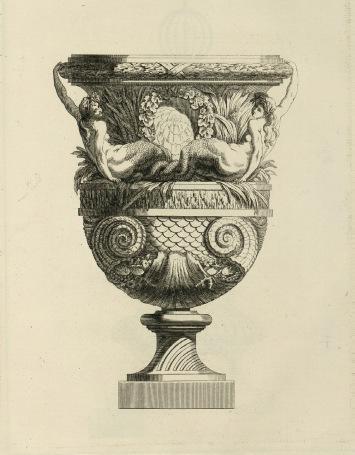
PROPERTY FROM THE COLLECTION OF THE VISCOUNT WIMBORNE (LOTS 8 & 9)
8
A PAIR OF LOUIS XV ORMOLU-MOUNTED BLUE CHINESE PORCELAIN COVERED VASES
THE ORMOLU MOUNTS CIRCA 1765-70, THE PORCELAIN QIANLONG (1736-1795)
Each vase of tapering form, the handles modelled as swans suspending mermaids, the necks hung with festoons of floral swags on a circular plinth base embellished with stiff-leaf motif, the covers possibly associated 16 in. (40.5 cm.) high; 9 in. (23 cm.) wide; 7 in. (18 cm.) deep
£50,000-80,000
PROVENANCE:
US$68,000-110,000
€60,000-95,000
Probably acquired by Henry Agar-Ellis, 3rd Viscount Clifden (1825-1866), 2nd Baron Dover for Dover House, Whitehall; thence by descent to Henry George Agar-Ellis, 4th Viscount Clifden (18631895), until sold by orders of the Executors of the late Viscount Clifden; Robinson & Fisher, London, 21st May 1895, lot 316.
Collection of Ludwig Neumann (1859-1934), 11 Grosvenor Square, London, until sold his sale, Christie's London, 2 July 1919, lot 90, where acquired by Albert Amor.
Acquired by Ivor Churchill Guest, 1st Viscount Wimborne (1873-1939) for Ashby St Ledgers Manor, Northamptonshire, where photographed in the Card Room in 1951, thence by descent to the present owner.
LITERATURE:
'Ashby St Ledgers, Northamptonshire - II', Country Life, 3 August 1951, pp. 348-351, fig. 6.
These Chinese porcelain vases are mounted with ormolu that expressively brings to life the mythological subject of Leda and the Swan. From the late 18th century, the swan motif began to be used in a number of commissions for the most discerning patrons, and the design for the swans as well as the female figures on this vase closely relate to models executed by Pierre Elisabeth de Fontanieu in 1770 for Louis XV. In the 19th century they likely formed part of the collection of Viscount Clifden at Dover House, Whitehall before being acquired by the financier and collector Ludwig Neumann and finally the Viscounts Wimborne.
Design for a vase with related Leda figures from Collection de vases inventés et dessinés par Mr. de Fontanieu, 1770
LEARN MORE
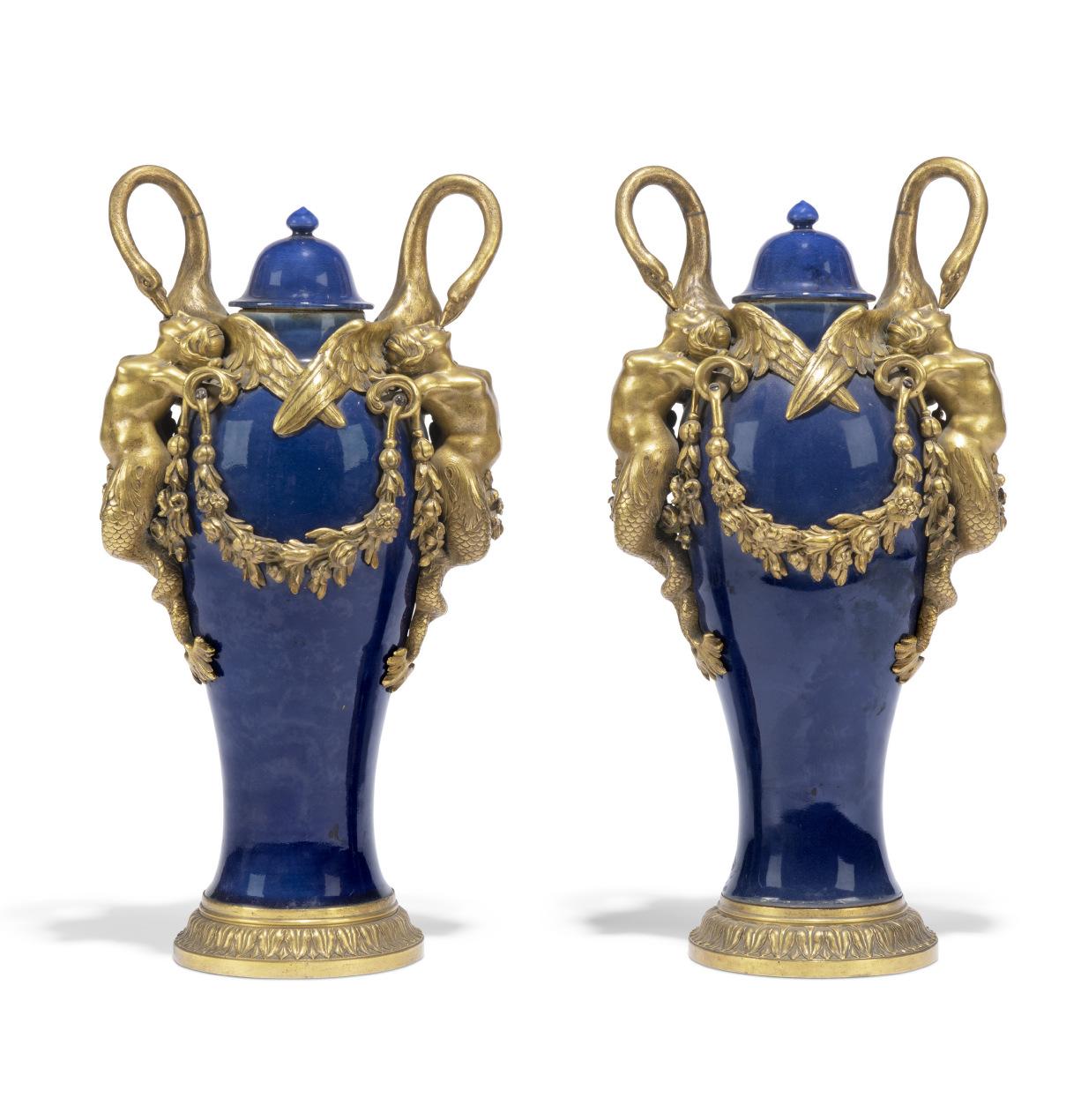
A BUREAU CYLINDRE BY JEAN-HENRI RIESENER – THE ENGLISH TASTE FOR FRENCH FURNITURE

PROPERTY FROM THE COLLECTION OF THE VISCOUNT WIMBORNE (LOTS 8 & 9)
■ψ9
A LOUIS XVI ORMOLU-MOUNTED TULIPWOOD, AMARANTH, HAREWOOD, EBONY AND HOLLY BUREAU A CYLINDRE
BY JEAN-HENRI RIESENER, CIRCA 1775-85
The rectangular top with three-quarter pierced gallery, above three crossbanded and filleted frieze drawers, the central drawer fitted with an easel and gilt-tooled leather-lined writing surface, the tambour cylinder inlaid with herringbone bands and centred by oval panels with uprights mounted with floral and foliate mounts, enclosing a leather-lined slide, pigeonholes and small drawers, the frieze with three drawers, the central drawer mounted with scrolling foliage and flowerheads framed by two panelled drawers, the sides each with a writing slide and an ink drawer and with moulded parquetry panels, the back decorated with lozenge parquetry, on tapering legs headed by ormolu angles cast with acanthus leaves, on paw feet, stamped five times 'J H RIESENER'
48 in. (120 cm.) high; 53 in. (134 cm.) wide; 30 in. (76 cm.) deep
£200,000-400,000
PROVENANCE:
US$280,000-540,000
€240,000-470,000
Acquired by Stephens Lyne Stephens (1801-1860) or his wife Yolande MarieLouise Lyne Stephens, née Duvernay (1812-1894), Lynford Hall, Norfolk, until sold at her estate sale 'Mrs. Lyne Stephens'; Christie's, 9 May 1895, lot 99, where acquired by 'A. W.'.
Collection of Ludwig Neumann (1859-1934), 11 Grosvenor Square, London, until sold his sale, Christie's London, 2 July 1919, lot 90, where acquired by Frank Partridge.
Collection of Henry Lascelles, 6th Earl of Harewood (1882-1947) at Chesterfield House, London, where photographed in the drawing room in 1931, until sold 'By orders of Her Royal Highness The Princess Royal, The Rt. Hon. Earl of Harewood, removed from Harewood House, Leeds'; Christie's London, 28 June 1951, lot 90.
Acquired by Ivor Guest, 2nd Viscount Wimborne (1903-1967), thence by descent.
This bureau à cylindre by Jean-Henri Riesener reflects the extraordinary quality of the celebrated ébéniste's production as well as the role of the garde-meuble de la Couronne in propagating taste among the French Royal Family and their circle. Bearing the hallmarks of his predecessor Jean-François Oeben the bureau is closely related to a model executed for Thierry Ville d'Avray, Intendant du Garde-Meuble in 1784 that was in the comte de Provence's collection. The present example also epitomises the prevailing taste for French furniture in England, forming part of the lavish collections of the magnates Stephens Lyne-Stephens and then Ludwig Neumann before being acquired by the Earl of Harewood for Chesterfield House and finally the Viscount Wimborne.
The Riesener bureau à cylindre in situ Chesterfield House London, 1931
LEARN MORE
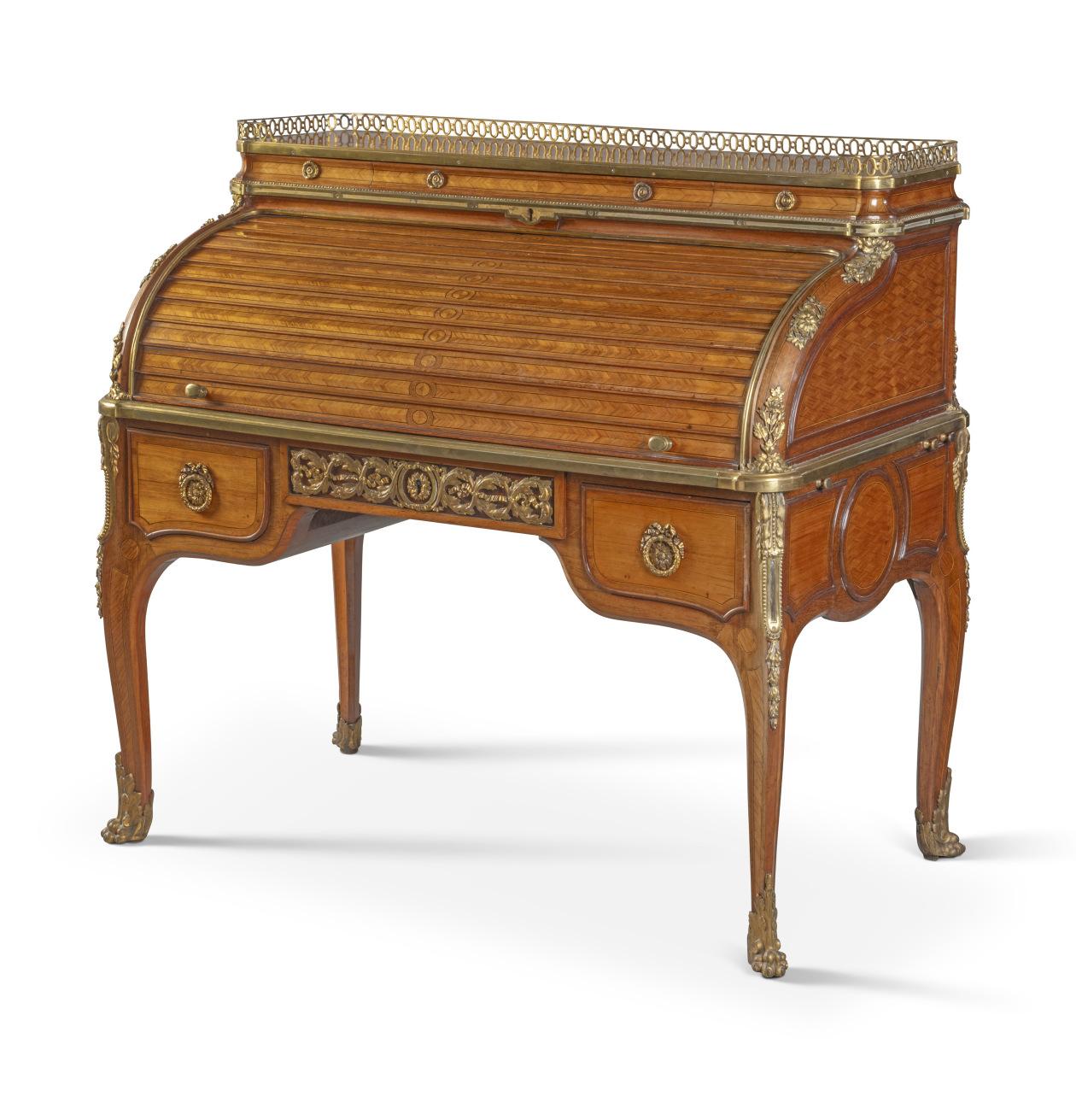
THE BEAUJON BEDFORD ‘BLEU TURQUE’ VASE
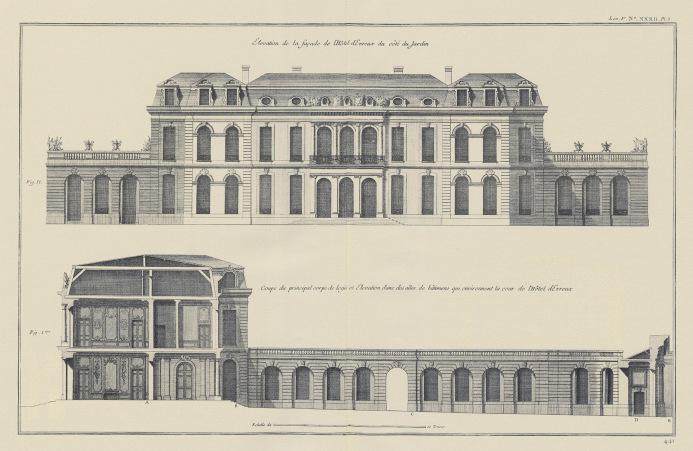
PROPERTY FROM A DISTINGUISHED PRIVATE COLLECTION (LOTS 10 & 33)
*10
A LATE LOUIS XV ORMOLU-MOUNTED 'BLEU TURQUE' CHINESE PORCELAIN VASE AND COVER OF EXCEPTIONALLY LARGE SIZE
CIRCA 1765-1770
The cover with a berried finial, the vase with a reeded crossed-ribbon border above a foliate-cast and arched collar punctuated with roundels, the baluster body with twin eaglehead handles flanked by scrolls and trailing husks and terminating in acanthus leaves, the cabochon-ornamented base with later beaded collar, above a guilloche moulding, over a tooled and panelled frieze with foliate bosses to the centre of each side, raised on leaf and scroll-cast feet 34 in. (86 cm.) high; 20Ω in. (52 cm.) diameter
£500,000-800,000
PROVENANCE:
US$680,000-1,100,000
€600,000-950,000
This majestic vase, distinguished by its impressive scale and quality, is one of the largest known examples of ormolu-mounted Chinese porcelain recorded in the eighteenth century. Retaining its particularly brilliant gilding, this lot was first recorded in the collection of one of the most distinguished collectionneurs amateurs of eighteenth-century France, Nicolas Beaujon. His home, the Hôtel d’Évreux, now the Palais d’Élysée, is probably the most well known hôtel particulier in all of France. Subsequently, the vase entered the collection at Woburn Abbey, the sumptuous residence of the Dukes of Bedford, until it was sold by the family some two hundred years later.
THE BEAUJON PROVENANCE
Nicolas Beaujon, (1718-1786), banker to the French Court.
Purchased by the marchande-mercier Madame Légère 1787 at the Beaujon sale on 25th April 1787, lot 307.
Acquired either by Francis Russell, 5th Duke of Bedford (1765-1802) or John Russell, 6th Duke of Bedford (1766-1839), and thence by descent until sold, Sotheby's London, 8 December 2009, lot 16 where acquired by the present owner (£713,250 including premium).
LITERATURE:
Recorded in the inventory on the death of Nicolas Beaujon, together with two other vases and described as `trois grands vases de porcelaine de la chine fond bleu-turque garnis de bronz doré 450'. (Three large Chinese bleu-turque porcelain vases ornamented with gilt-bronze- 450'), The sale catalogue description of April 1787 describes it as `Une urne couverte, a grosse panse ornée de gorge a baguettes et a fleurons, boutons et rosaces a tetes d`aigle et rinceaux terminée par un pied a quatre consoles et platebande en bronxe doré. Hauteur 30 pouces, diamètre 18 pouces. Le vase et les deux suivant sont d`une forme majestueuse et d`un genre d`ornament male'. ( see illus.)
Nicolas Beaujon (1718-1786) was a prominent French financier and art patron. Born in Bordeaux into two prosperous merchant families, the Beaujons and the Delmestres, he amassed considerable wealth in the commodities trade before relocating to Paris. In 1753, he married Louise Elisabeth Bontemps, granddaughter of Alexandre Bontemps valet de chambre to Louis XIV, thereby reinforcing his social and political connections.
Beaujon played a pivotal role in financing the French state during the reign of Louis XV, most notably through substantial loans during the Seven Years' War, which secured him the influential position of fermier général, and later a seat on the Conseil d'État
In 1773, Beaujon acquired the Hôtel d’Évreux in Paris, today the Élysée Palace, for the vast sum of one million livres. Originally constructed in 1718 by the architect Armand-Claude Mollet for the Comte d’Évreux, the hôtel had previously belonged to Madame de Pompadour. Under Beaujon’s ownership, the residence underwent extensive renovations directed by the visionary architect Etienne-Louis Boullée. After his relocation to the Hôtel d’Évreux, Beaujon began purchasing from public auctions to assemble an extensive collection of paintings, sculptures, and objets d’art
The Hôtel d’Evreux (now the Élysée Palace). The Beaujon Vase is recorded in the salon au cabinet des tableaux on the ground floor—inside the three windows on the right side of the first elevation above—looking onto the flower garden
LEARN MORE

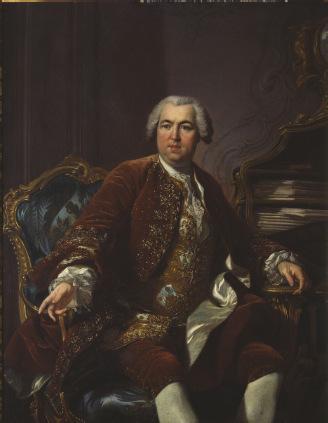
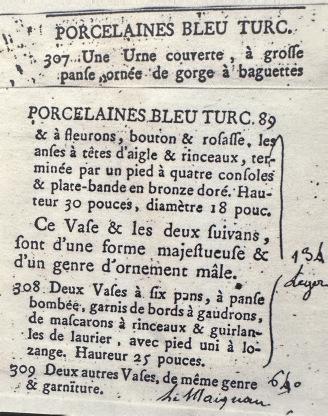
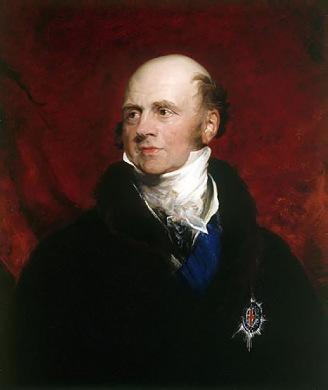
The vase offered here was given pride of place within Beaujon’s collection at the Hôtel d’Évreux: it was displayed on a chimneypiece in the salon au cabinet des tableaux, the principal reception room of Beaujon’s private apartments. Overlooking the formal garden, this room was designed in a blue and white palette to harmonize with a garniture of three Chinese porcelain vases, including the present example. Upon Beaujon’s death in 1786, an inventory of his collection was undertaken. The three vases, including the present lot, were listed under inventory number 704 as trois grands vases de porcelaine de Chine bleu turquin, garnis de bronze doré – 450 [livres]. The group of vases was sold at auction in April 1787, selling to the dealer Légère for 1,340 livres
THE BEDFORD PROVENANCE
While definitive documentation of the vase's subsequent transfer remains elusive, its acquisition by the Russell family is plausible. During renovations at Woburn Abbey, Francis Russell, the 5th Duke of Bedford is known to have acquired French decorative arts, and may have purchased the vase directly from Légère. Although no record of this transaction survives, the 6th Duke, John Russell, is documented as having acquired objects from Dominique Daguerre in 1803. While the vase is not specifically listed among these purchases, the possibility that it entered the collection at this time remains strong.
Woburn Abbey, Bedfordhsire, encompassing Woburn Park and its associated buildings, was originally established in 1145 as a Cistercian monastery. The first major transformation of the site occurred circa 1630 under Francis Russell, 4th Earl of Bedford, who initiated the construction of a new manor house. A second significant phase of rebuilding was undertaken between 1747 and 1761, under the direction of architects Henry Flitcroft and John Sanderson. Further architectural modifications took place between 1787 and 1790 under the supervision of Henry Holland. Woburn Abbey housed the distinguished art collection of the Dukes of Bedford. To this day, the collection includes masterpieces by eminent artists such as Rubens, Van Dyck, Canaletto, and Velázquez. In addition to its paintings, the collection also features exceptional examples of English and French furniture from various periods, as well as an extensive assemblage of porcelain and silverware.
THE PORCELAIN
The French practice of mounting Asian ceramics in European metalwork, recorded as early as the fourteenth century, took on a new life in the eighteenth century, as giltbronze replaced silver as the preferred mounting medium, and mounts themselves took on new and more complex, sculptural forms. Just as the marchand-merciers of Paris were responsible for the supply of Asian porcelain to their networks of clients, so too did they maintain close networks within the guilds of bronze casters and chasers (fondeursciseleurs) and gilders (doreurs), who could produce mounts to enrich their wares. By framing the precious Chinese porcelain in sumptuous ormolu, these craftsmen transformed them into entirely new objects, aligning them with the latest tastes of France’s most elite collectors. The present vase is an outstanding example of a Chinese porcelain vessel imported to France: its glaze is notable for the exceptionally even application and luminous quality, embodying the technical mastery achieved during the Qing dynasty (1644–1911).
Extract from the sale catalogue of April 1787
Nicolas Beaujon (1718-1786), by Louis-Michel van Loo (1707-1771)
John Russell, 6th Duke of Bedford (1766-1839), by Sir George Hayter (1792-1871)
THE MOUNTS
Although the design source and the maker of the gilt-bronze of this lot are as yet unknown, this vase can nonetheless be related to two groups of objects produced in Parisian ateliers during the third quarter of the eighteenth century: a small but distinct group of mounted Chinese porcelain wares, and the overall oeuvre of the celebrated bronzier and sculpteur Jean-Claude Chambellan Duplessis (1699-1774). The exclusive group of mounted Chinese porcelain is distinguished by a number of exceptional characteristics shared by each, including bold à la Grecque mounts, intensely- colored glazes, and impressive heights, over 50 centimeters. Furthermore, they all feature prominent lion-mask figural handles or side mounts.
Vases in this group include:
– a turquoise-glazed Ming Dynasty Chinese garden seat, mounted as a vase with a fluted collar, lion’s mask handles and a leaf-cast socle. This vase was acquired by the dealer Paillet for Louis XVI at the sale of the duc d’Aumont’s collection in 1782, and remains in the collection of the château de Versailles (obj. no. T 423 C).
– a Kangxi-period famille verte porcelain vase, known as the “Sainte-Foy vase,” sold from the Dalva collection, Christie’s, New York, 22 October 2020, lot 158.
– a turquoise-glazed Ming Dynasty Chinese garden seat sold Christie’s, King Street, 13-14 November 1984, lot 671.
– a turquoise-glazed Ming Dynasty Chinese garden seat sold Sotheby’s, Paris, 15 December 2010, lot 93. Intriguingly, the lion masks on this group are remarkably similar to those both on the ‘vases Dulac’, and the iconic goût grec model of clock supplied by the bronzier Robert Osmond to Lalive de Jully, the celebrated early connoisseur of Neoclassicism.
The present vase also displays many of the highly recognizable characteristics of the Duplessis style, evidenced particularly by the bold design of the acanthus, volutes and fluting. The chasing to the bronze is of the highest quality, the foliage is finely cut, and the ornamentation reveals a great sense of detail. On the present vase, the base mount, particularly its acanthus and volute-cast feet, is especially close to Duplessis’ oeuvre, recalling his earlier ormolu mounts designed in the rocaille symétrisée fashion. Here, however, the sinuous Rococo curves are comparatively tamed and the Neoclassical symmetry is further developed. Comparable prototypes in the late Rococo taste for this base model include those found on an ormolu-mounted celadon vase sold from the Rothschild collection, Christie’s, New York, 11 October 2023, lot 42, and on a pair of vases formerly in the collection of the Baron de Besenval, sold Christie’s, London, 8 July 2021, lot 4. In addition, the bases of the Besenval vases are cast with ribbon-tied reeds that feature prominently on the lid of the present vase.
A number of entries in the Livre-journal of the marchand-mercier Lazare Duvaux show that Duplessis was regularly engaged to provide mounts for Chinese porcelain (L. Courajod, Livre-Journal de Lazare Duvaux, Marchand-Bijoutier Ordinaire du Roy, 1748-1758, Paris, 1873, II, nos. 601, 1713 and 1810).
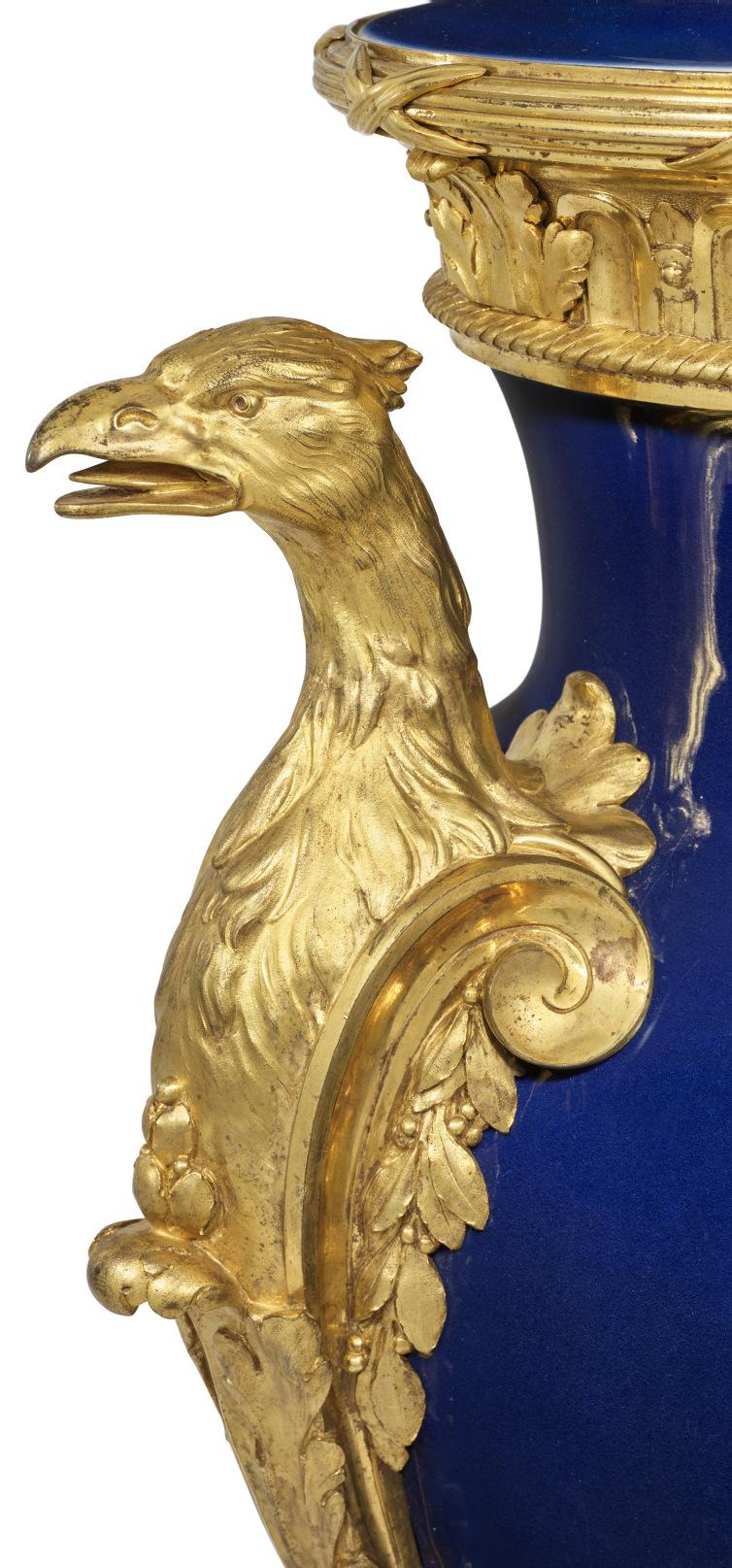
THE SAMUEL MESSER TORCHERES
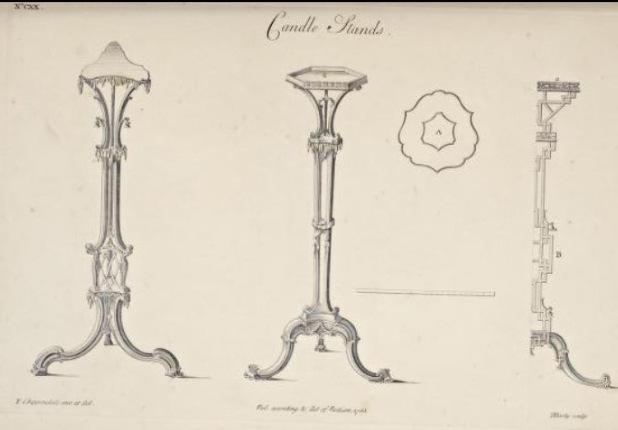
PROPERTY OF A LADY
LEARN MORE
A PAIR OF GEORGE III MAHOGANY TORCHERES
CIRCA 1760-65, POSSIBLY BY THOMAS CHIPPENDALE
The shaped moulded triform top carved with cartouche motif, supported by a tapering stem carved with harebells on a turned base decorated with blind fretwork motif, above a foliate collar and a turned fluted shaft with acanthus leaf base, on three S-shaped legs with scrolling pad feet, one leg replaced 44. 3/4 in. (114 cm.) high; 16 in. (41 cm.) diameter (2)
£30,000-50,000
PROVENANCE:
Bought by Samuel Messer from Hotspur, 30 April 1959 (£880).
US$41,000-68,000
€36,000-59,000
The Messer Collection; Christie's, London, 5 December 1991, lot 94 (sold £49,500 inc. premium), Acquired from the above by the present owner.
COMPARATIVE LITERATURE:
M. Jourdain and F. Rose, English Furniture, The Georgian Period (1750-1830), London, 1953, p. 173, pl. 144.
This finely carved pair of mahogany candle-stands, with high-hipped tripod bases and distinctive flattened scrolled feet, exemplifies Thomas Chippendale’s most refined interpretation of the mid-18th century English tripod table form. Closely related to documented examples supplied by Chippendale for Blair Castle in 1758 and Dumfries House in 1759, they formed part of the Samuel Messer Collection, one of the most significant assemblages of English furniture formed in the 20th century.
Designs for candle stands from The Gentleman and Cabinet-Maker’s Director, 1754, by Thomas Chippendale
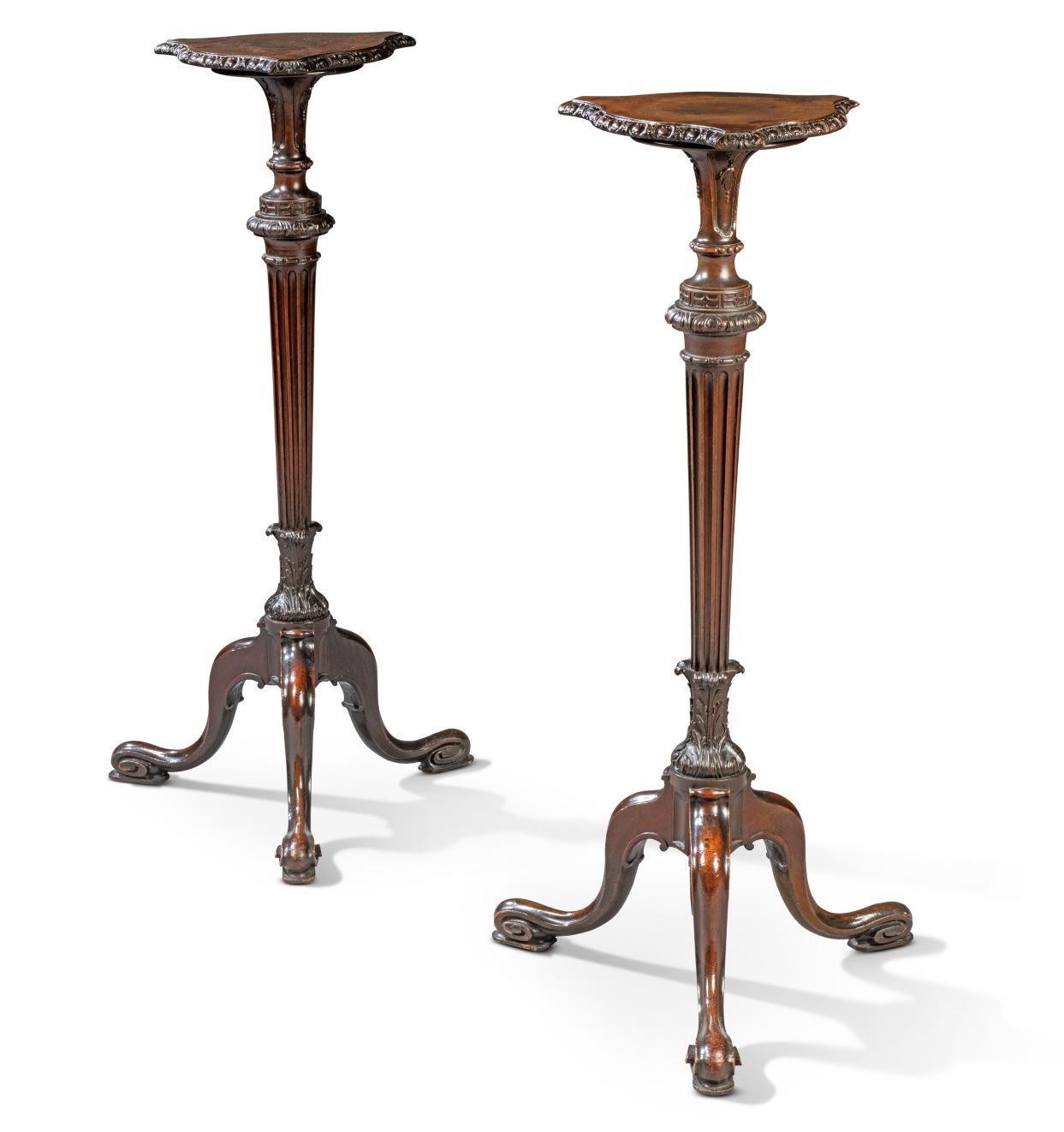
THE MERSHAM-LE-HATCH CHIPPENDALE TABLES
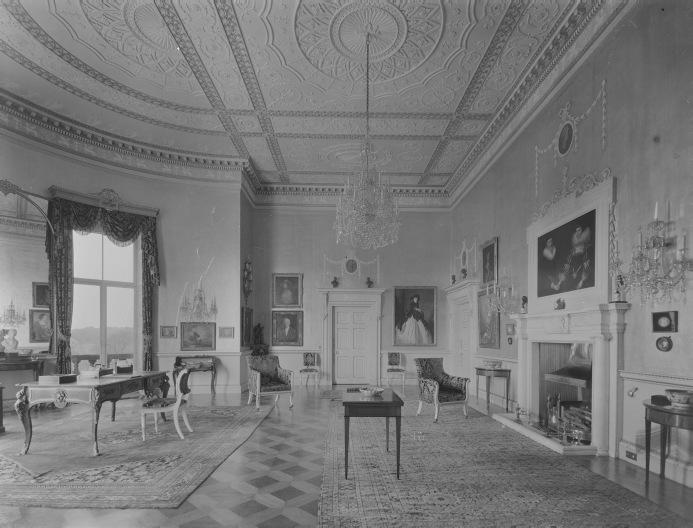
PROPERTY OF A PRIVATE COLLECTOR
■12
A PAIR OF GEORGE III HAREWOOD, SYCAMORE, AMARANTH, MAHOGANY AND MARQUETRY DEMI-LUNE PIER TABLES
ATTRIBUTED TO THOMAS CHIPPENDALE SENIOR OR JUNIOR, CIRCA 1775
Each crossbanded overall, with D-shaped top with a fan-shaped demi-lune within a guilloche border filled with flowerheads, the frieze inlaid with a further flower filled guilloche band, on square tapering legs and shaped block feet engraved with stiff-leaf decoration, with batten-carrying holes
34Ω in. (87.5 cm.) high; 44 in. (112 cm.) wide; 17æ in. (45 cm.) deep
£60,000-100,000
PROVENANCE:
US$81,000-140,000
€71,000-120,000
Almost certainly commissioned by Sir Edward Knatchbull (1704-1789), 7th Bt., Mersham-le-Hatch, Kent. Thence by descent until sold, Property of the Knatchbull family; Christie's, London, 4 July 1991, lot 61, Acquired from the above by the present owner.
LITERATURE:
H. Avray Tipping, 'Mersham-Le-Hatch, Kent, The Property of Capt. the Hon. Michael Knatchbull,' Country Life, 8 August 1925, pp. 226.
These demi-lune tables, with their intricate marquetry and delicate proportions, are part of the grand neoclassical transformation of Mersham-le-Hatch, an estate that exemplifies Georgian refinement. Commissioned by Sir Edward Knatchbull, the collaboration between the renowned designer Robert Adam and cabinet-maker Thomas Chippendale brought to life an elegant fusion of architectural grandeur and finely crafted furniture, seen particularly in the Saloon.
The Bow Drawing Room at Mersham-Le-Hatch, Kent, partially showing one of the tables to the left of the window. © Country Life/ Future Publishing Ltd.
LEARN MORE
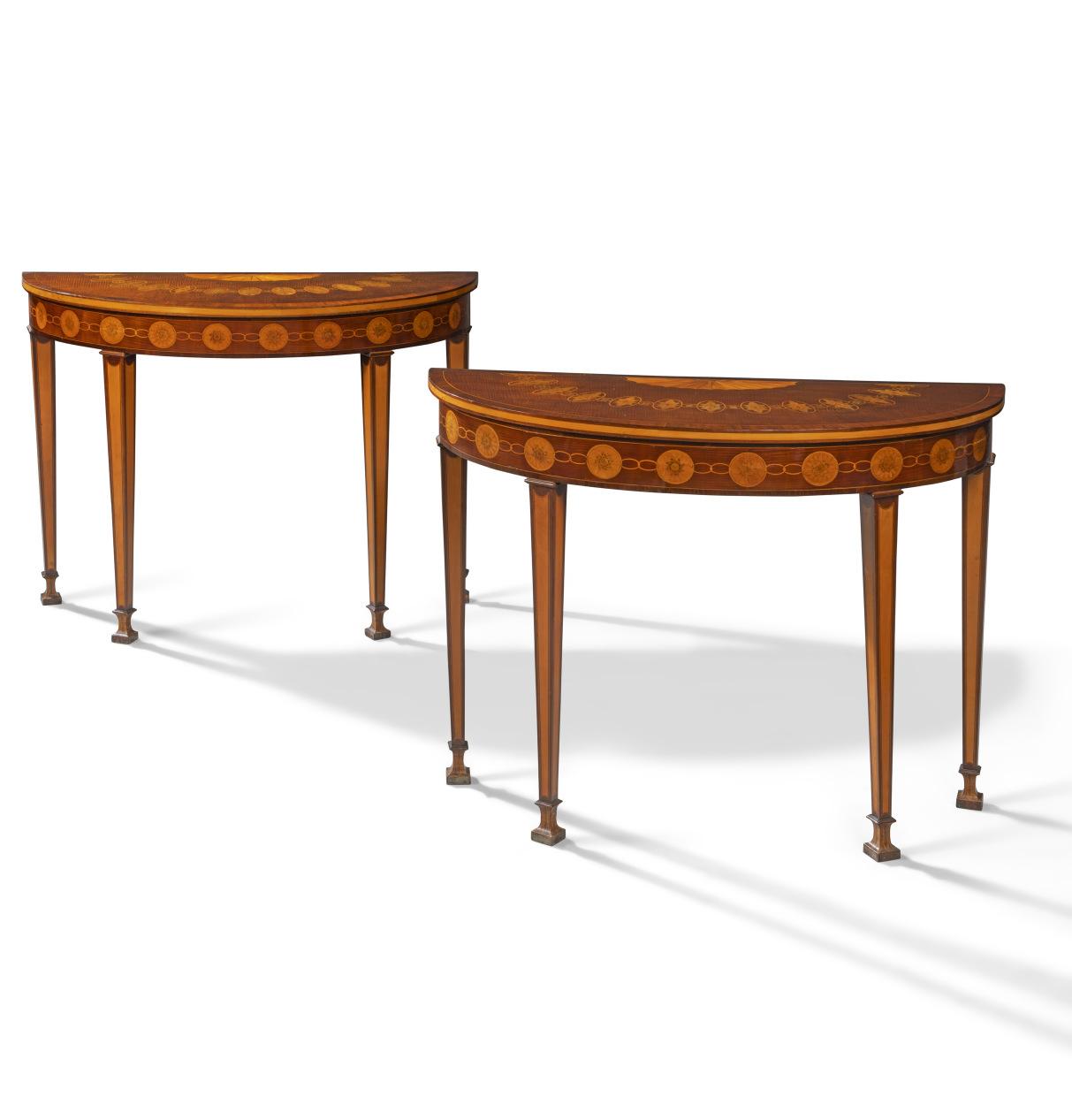
THE CADLAND HOUSE TORCHERES
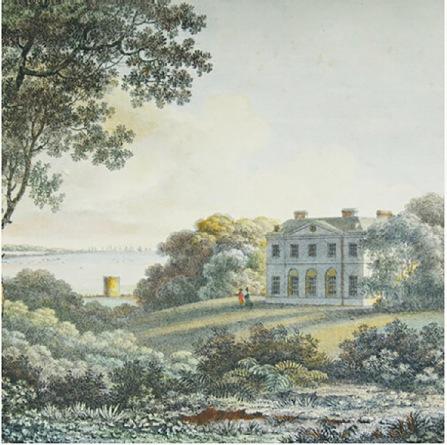
PROPERTY OF A GENTLEMAN
■13
A PAIR OF GEORGE III WHITE-PAINTED CARVED LIMEWOOD AND COMPOSITION ORNAMENT TORCHERES
ATTRIBUTED TO INCE & MAYHEW, CIRCA 1775
Each with circular platform with guilloche edge, on fluted acanthus-carved baluster stem with beaded and paterae collar, the tripartite bases decorated to the front with ram's heads and foliate swags issuing from a fluted frieze and centred with a laurel wreath, the foliate mouldings to base in plaster, traces of original duck egg blue and white decoration, previously but possibly not originally with light fittings to top 68 in. (173 cm.) high; 23 in. (58 cm.) wide; 24Ω in. (62 cm.) deep
£50,000-80,000
PROVENANCE:
US$68,000-110,000
€60,000-95,000
Almost certainly commissioned by The Hon. Robert Drummond (1729-1804) for Cadland Park, Hampshire and removed to Cadland Manor in circa 1950. Thence by descent.
These elegant neoclassical torcheres once formed part of the now lost interiors of Cadland Park, Hampshire. Built in 1775 for the banking scion The Hon. Robert Drummond, the perfectly proportioned villa was an early collaboration between Henry Holland and Capability Brown. Perched within sweeping parkland on the Solent coastline, surviving plans and elevations of the house suggest the torcheres may have occupied two niches in the Hall - being fully decorated to only one side - and pigment testing indicates an original duck egg blue scheme with white highlights. The celebrated 18th-century English cabinet-makers William Ince and John Mayhew worked with Holland on a number of important commissions, including at nearby Broadlands for Henry Temple, 2nd Viscount Palmerston, and the existence of other pieces of furniture in the Drummond collections identifiable with the firm lends further weight to the attribution.
After George Barret RA, Cadland Park, in Hampshire, the seat of R. Drummond Esq., 1 September 1780
LEARN MORE
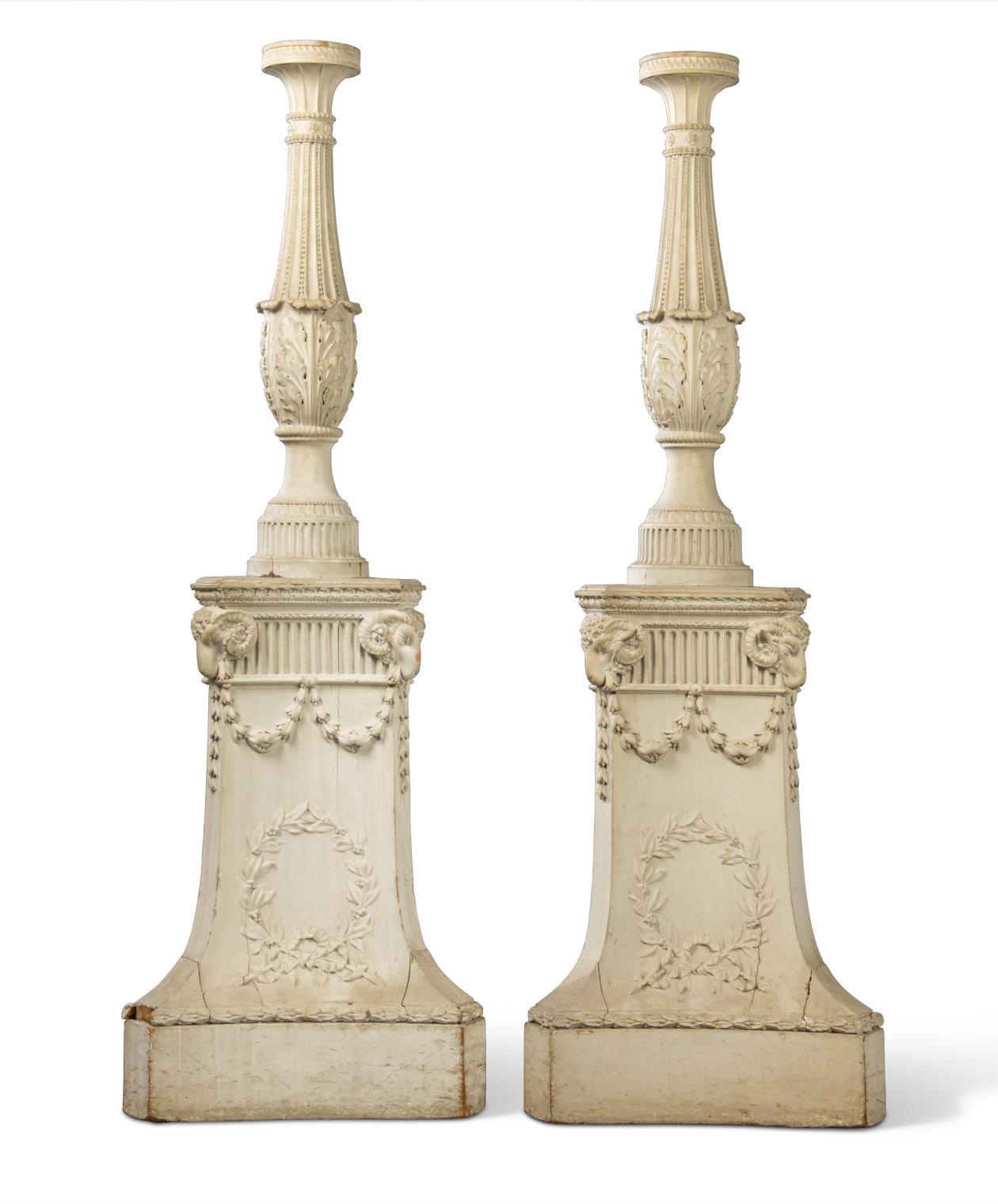
A SYMPHONY IN MARQUETRY - THE DUDLEY HOUSE COMMODES BY LINNELL
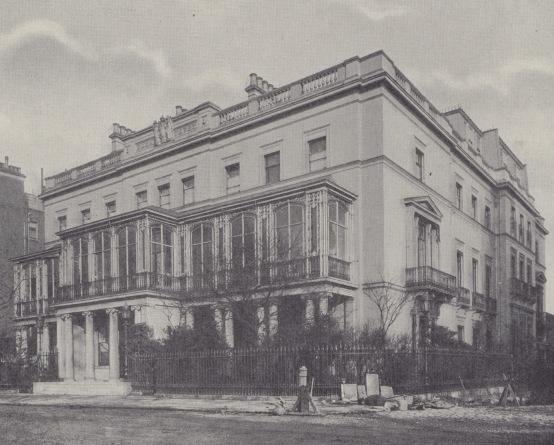
PROPERTY FROM AN ENGLISH PRIVATE COLLECTION
■∝14
A PAIR OF GEORGE III LACQUERED-GILT-BRONZE-MOUNTED KINGWOOD, HAREWOOD, AMARANTH AND MARQUETRY SERPENTINE COMMODES
ATTRIBUTED TO JOHN LINNELL, CIRCA 1765
Each brass-bounded shaped top with a foliate cartouche with ribbon-tied rush border enclosing marquetry musical trophies, with foliate-cast angle mounts and further leaf-tip and ribbon mount to the shaped front and sides enclosing ribbon-tied floral marquetry, with a frieze drawer centred by crossed-palms and flanked by floral sprays with ivory escutcheon above a cupboard door enclosing two short and two graduated long mahogany-lined drawers with foliate-cast handles, terminating in acanthus clasped scroll feet
35 in. (89 cm.) high; 42Ω in. (108 cm.) wide; 19 in. (48 cm.) deep
£300,000-500,000
PROVENANCE:
The collection of Charles T. Jacoby, 80 Knightsbridge, London. Sir John H. Ward K.C.V.O, Dudley House, Park Lane, London and thence by descent.
LITERATURE:
US$410,000-680,000
€360,000-590,000
H. Cescinsky,'The collection of the Hon. Sir John. H Ward, K.C.V.O.', Part IV, Connoisseur, August 1921, p. 196 (No. IV).
C. Crowe, 'Furniture at the Burlington Fine Arts Club', Country Life, 9 January 1926, p. 64 (fig. 7).
L. Wood, The Lady Lever Art Gallery, Catalogue of Commodes, London, 1994, pp. 101-105 (figs. 100-101).
COMPARATIVE LITERATURE:
H. Hayward and P. Kirkham, William and John Linnell, London, 1978, vol. I.
The entrance to Dudley House, on Park Lane, July 1890, from a series of photos taken for the second Earl of Dudley
LEARN MORE
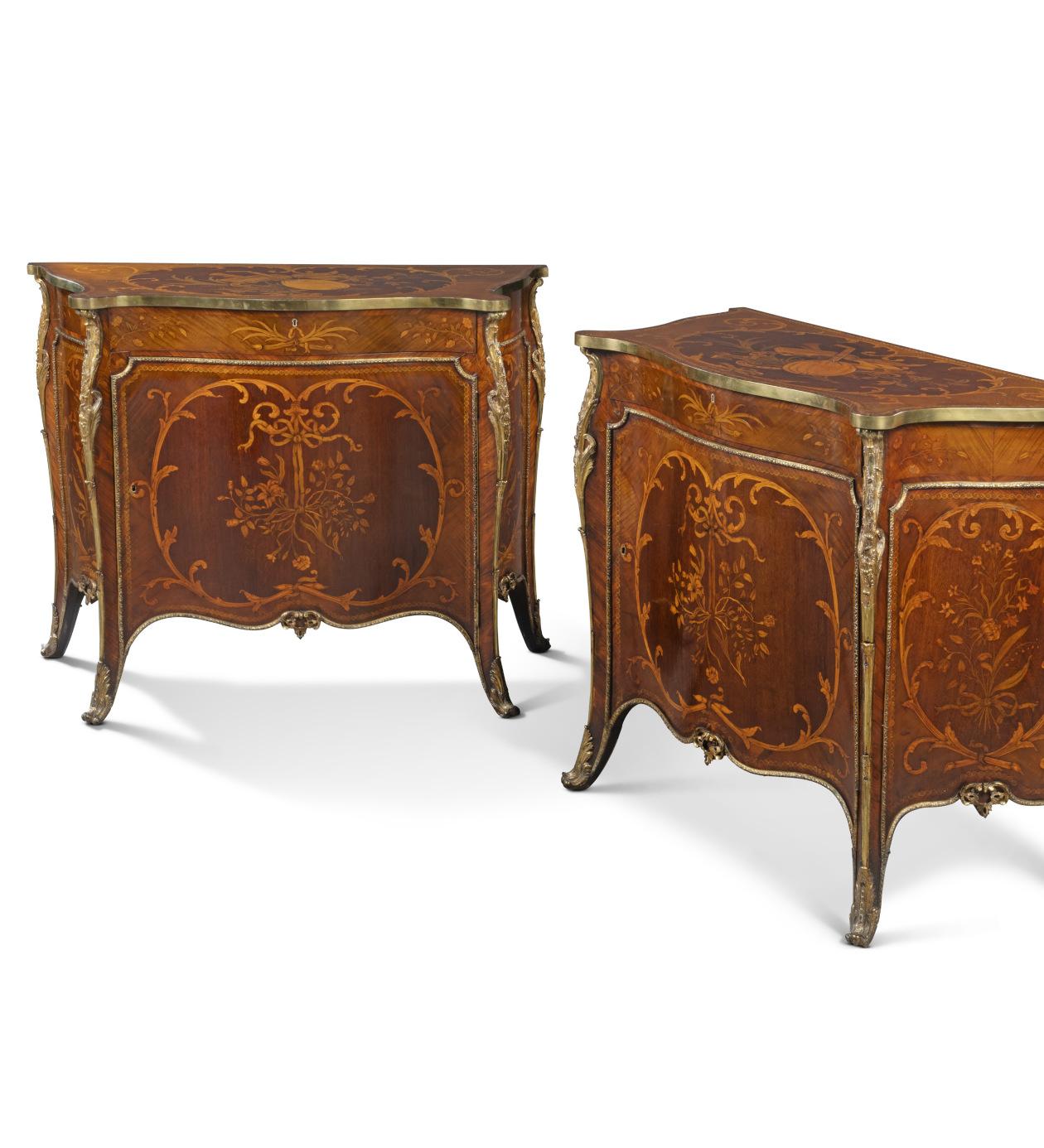
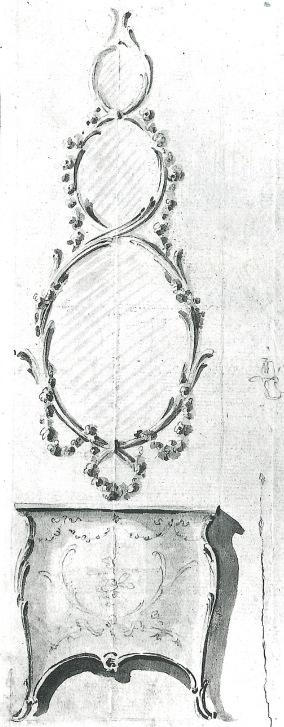
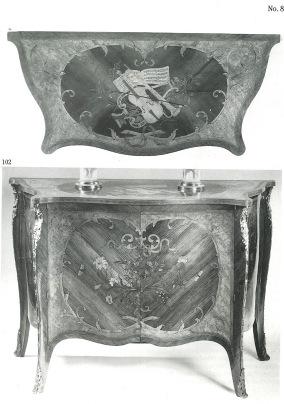
These marquetry commodes epitomise the elegant French style executed in the late 1760s by John Linnell (d. 1796), cabinet-maker and upholsterer of Berkeley Square. They evolved from the Louis XV 'picturesque' style introduced during the 1750s by emigré craftsmen such as Pierre Langlois (d. 1765). However, it was Christopher Fuhrlohg (d. circa 1787) and George Haupt (d. 1784) who, having trained in the Paris workshops of Simon Oeben, are thought to have introduced this particular style to the Linnell workshops in the 1760s. They form part of a distinctive group of marquetry commodes attributed to Linnell and are discussed in depth by Lucy Wood in The Lady Lever Art Gallery, Catalogue of Commodes, 1994, pp. 98-105.
This group includes:
-A pair, accompanied by foliage-framed pier-glasses, almost certainly supplied by Linnell to his principal patron, the banker Robert Child for Osterley Park, Middlesex and was listed in the 1782 inventory of Mrs. Child's Dressing-Room (H. Hayward and P. Kirkham, William and John Linnell, London, 1978, vol. I, fig. 104).
-Two further commodes, almost certainly acquired by Catherine the Great, are recorded in the correspondence of Pierre Falconet, son of the celebrated sculptor, while acting as an agent for John Linnell at the Imperial Court in St. Petersburg. In September 1774 he wrote to James Triquet enquiring about the price of Linnell's marquetry cornercupboards, and again on the 30 December, when he noted that although the Russian court considered two pieces of Linnell's furniture that he had taken for sale to be 'very beautiful', they remained unsold so he was contemplating their return to London. It seems more than likely, however, that these items remained in Russia, as they can be identified with the two commodes, displaying identical beaded borders to the tops, that are now at Tsarskoe Selo and Peterhof, St. Petersburg (Hayward, op. cit., pl. 9).
-A pair from the collection of E.M. Denny, Esq., probably commissioned for Traloe Castle (Castle Moyle), Co. Kerry by Sir Barry Denny, 1st Bt. around the time of his marriage in 1767 to his cousin Jane, heiress of Traloe Castle, was sold in these Rooms on 17 March 1921, lot 116 and again on the 15 April 1982, lot 84 from the collection of Michael Knapp. They appeared on the market again offered from the estate of Wendell Cherry at Sotheby's, New York 11 October 1996, lot 443 (sold for $442,500 inc. premium) where they were acquired by Partridge Fine Arts Ltd.
-A further pair, albeit of a slightly larger scale to the present commodes, but arguably closest in style, was formerly in the collection of Arnold Wills Esq., at Thornby Hall, sold in these rooms 'The Contents of Thornby Hall, Northamptonshire'; Christie's. London, 22-23 October 1984, lot 97. They appeared on the market again at Christie’s from the collection of Edward Sarofim on 16 November 1995, lot 150 and were sold for a third time at Sotheby’s on 8 December 2004, lot 25.
-Lastly, a single commode purchased by Lord Leverhulme from the renowned London firm of Moss Harris on 25 March 1919 for £1,000, now in The Lady Lever Art Gallery (Wood, op. cit., p. 98, no. 8).
Design for a commode and pier glass, by John Linnell (acc. no. E256-1929) Victoria & Albert Museum
One of the pair of related commodes from Thornby Hall © Christie’s images 1984
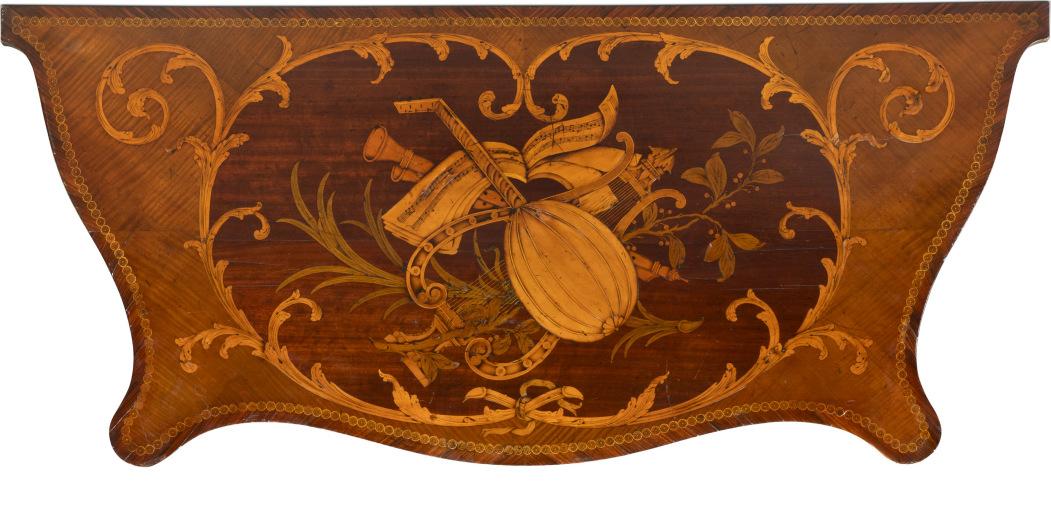
Amongst Linnell's surviving workshop-drawings are two related commode-patterns, supplied en suite with pier-glasses which relate to the present commodes which further support an attribution to Linnell (Victoria & Albert Museum, no. E.256 and E.253-1929, illustrated in L. Wood, op. cit., p. 103, fig. 96). The commodes also include a number of motifs which are idiosyncratic of Linnell’s production such as the crossed palms executed in marquetry to the centre of the frieze drawer. In terms of construction, they also adhere to Linnell’s commitment to symmetry and harmony as the doors to each commode have hinges to the right-hand side allowing them to open identically. This design choice not only reflects aesthetic considerations but also possibly the practical functionality of the room arrangement in which these commodes were likely to be placed.
CHARLES T. JACOBY, 80 KNIGHTSBRIDGE, LONDON
The present pair of commodes was first recorded in the collection of Charles T. Jacoby (1853-1910) a successful lace manufacturer from Nottingham. Together with his two brothers, Charles was a director of the family business M. Jacoby & Co. The brothers were collectors of art and antiques and donated works to the Nottingham Castle Museum. Following his death the pair of commodes was offered for sale at Christie's London, 23 June 1910, lot 134 (Wood, op. cit., figs. 100-101).
SIR JOHN H. WARD, K.C.V.O., DUDLEY HOUSE, LONDON
The commodes subsequently passed into the collection of Sir John Ward K.C.V.O., at Dudley House, Park Lane, London. Dudley House was built in an area of Mayfair known as Upperfielde, part of the Grosvenor Estate that formed the dowry of Mary Davies. Designed by William Atkinson, construction of the house began in 1824 for Viscount Dudley. After his death in 1833 without issue, the house passed through various hands for the next sixty years; one of the most notable being Ismail Pasha ‘The Magnificent’, Khedive of Egypt, who used Dudley House as his residence on a State Visit to England in 1867. Between 1895 and 1912 the house was owned by Sir Joseph Robinson, a South African mining magnate and Randlord (known as ‘the Buccaneer’) after which it was acquired by The Hon. Sir John and Mrs. Ward.
John Ward was one of a select group who formed remarkable collections of mid-Georgian furniture in the early part of the twentieth century. His magnificent collection is discussed in a four-part article by Herbert Cescinsky published in The Connoisseur in January-August 1921. One of the present pair of commodes is illustrated in the fourth instalment of the article p. 196 (No. IV).
THE BACHELOR DUKE OF DEVONSHIRE’S MARINE TUREENS
A PAIR OF GEORGE IV SILVER SOUP TUREENS, COVERS, LINERS AND STANDS FROM THE DUKE OF DEVONSHIRE'S GRAND SERVICE
MARK OF PAUL STORR, LONDON, 1820 AND 1821
The campana-shaped tureens each on spreading base applied with four detachable-cast scaly dolphins, the sculptural cast handles formed as a merman and a mermaid, the lower body cast with shellwork and with gadrooned sea-foam rim, the detachable domed covers with cast crustacea and vegetable handles, each applied twice with detachable cast coat-of-arms with duke's coronet above, with detachable plain liners, the shaped oval stands with boldly cast waved border simulating sea spray, with shaped scroll shell handles, each marked on cover, liner, under stand, under tureen, on finial, on dolphins and the four base fixing nuts, the applied coats-of-arms unmarked the stands 21Ω in. (54.5 cm.) wide 1,047 oz. 4 dwt. (32,573 gr.)
The arms are those of Cavendish quartering Boyle and Clifford for William, 6th Duke of Devonshire (1790-1858), son of William, 5th Duke of Devonshire (1748-1811) and his wife Georgiana (1757-1806), daughter of John, 1st Earl Spencer (1734-1783). The 6th Duke was grandson of William, 4th Duke of Devonshire (1720-1764) and his wife Lady Charlotte Boyle, suo jure Baroness Clifford (1731-1754), an heiress who brought a considerable fortune to the Cavendish family. (2)
£500,000-800,000
US$680,000-1,100,000
€600,000-950,000

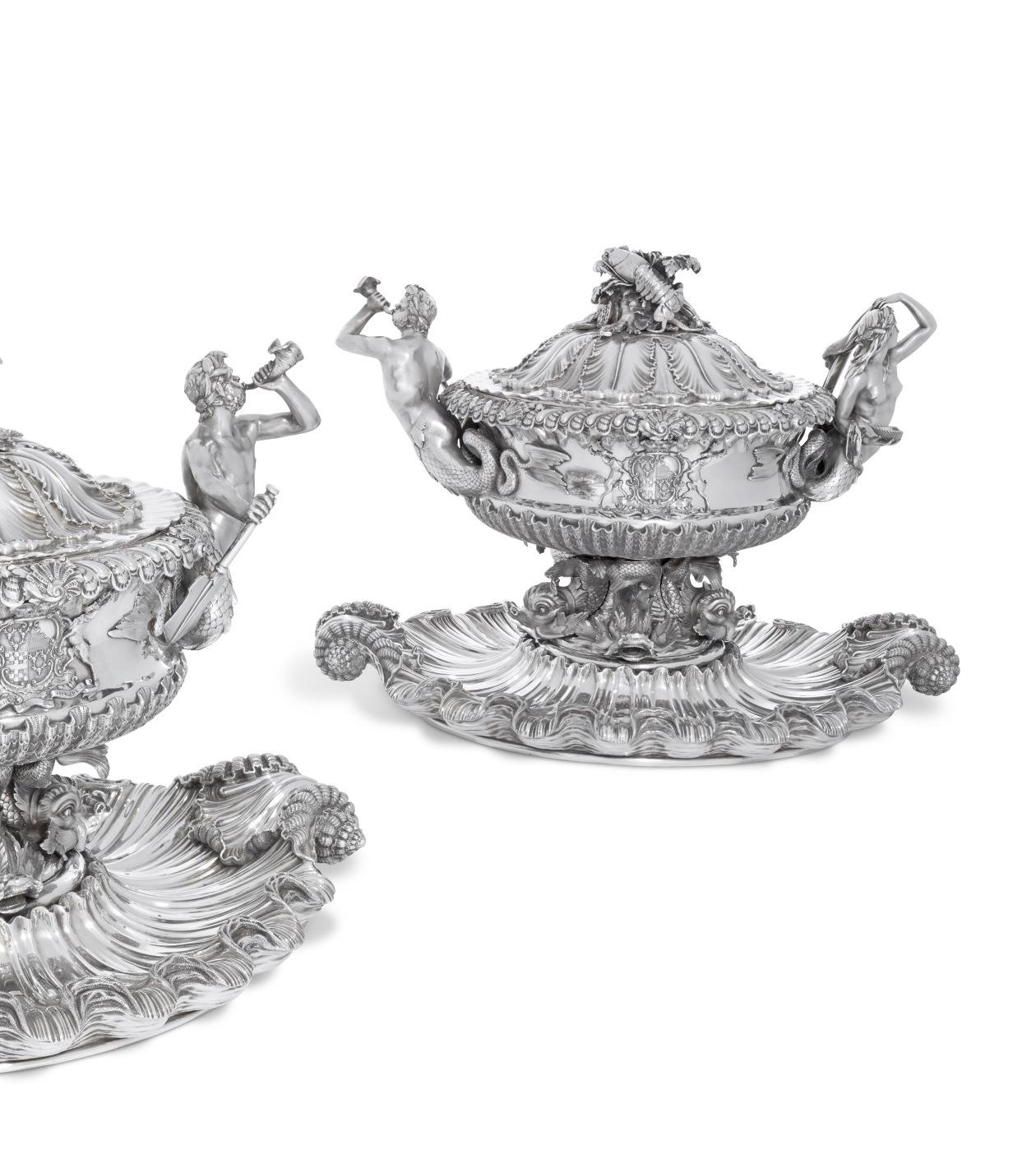
PROVENANCE:
William Cavendish, 6th Duke of Devonshire (1790-1858), by descent to his cousin, William Cavendish, 7th Duke of Devonshire (1808-1891), by descent to his second son, Spencer Cavendish, 8th Duke of Devonshire (1833-1908), by descent to his nephew, Victor Cavendish, 9th Duke of Devonshire (1868-1938), by descent to his son, Edward Cavendish, 10th Duke of Devonshire (1895-1950), by descent to his second son,
Andrew Cavendish, 11th Duke of Devonshire (1920-2004),
Highly Important Old English and French Silver from The Chatsworth Collection; Christie's, London, 25 June 1958, lot 24, when purchased by the owner's father.
LITERATURE:
Mss., Inventory of the Furniture...and Other Effects, at Devonshire House, 1892, folio 229, '2 soup tureens with figure handles'.
F. Davis, 'Historic Silver from Chatsworth', Country Life, 10 July 1958, p. 76, illustrated.
'International Saleroom', The Connoisseur, Sept. 1958, no. 571, p. 39, fig. 11.
M. Clayton, The Collector's Dictionary of Silver and Gold of Great Britain and North American, Woodbridge, 1971, p. 366, fig. 543.
M. A. Clark, Paul Storr Silver in American Collections, Indianapolis, 1972, p. 6.
C. Hartop, Art in Industry, The Silver of Paul Storr, Cambridge, 2015, p. 98.
THE MARINE TUREENS OF PAUL STORR AND ROBERT GARRARD
These magnificently sculptural tureens are masterpieces of the Rococo revival style. The marine theme, so evidently celebrated by the Devonshire tureens, was inspired by the renowned Royal Marine Service commissioned by Frederick, Prince of Wales (17071751) from the goldsmith Nicholas Sprimont between 1741 to 1744. The service, which remains in the Royal Collection, comprises a centerpiece, four sauceboats, and various shell form salt cellars. Its design was influenced by the work of the goldsmith to King Louis XV of France, Juste-Aurèle Meissonnier (1695-1750). Paul Storr will have been aware of the Royal Marine Service through his role at Rundell Bridge and Rundell, the Royal Goldsmiths, who produced marine salt cellars with shell bowls and merman supporters for the Prince Regent in 1810 to designs of Edward Hodges Baily.
The earliest mention of the exuberant marine inspired tureen form can be found in the ledgers of Robert Garrard, as recorded by J. R. Bliss in his catalogue of The Jerome and Rita Gans Collection, 1994, p. 206. An entry dated 12 June 1819, for an order commissioned by Robert Sherard, the 6th Earl of Harborough (1797-1859) included '2 finely chased terrines, stands, with marine figures supported by dolphins'. In the same year Storr severed his connection with Rundells, whose manufacturing silver department he had managed, in order to establish his own workshop.
In 1977 John Culme published his discovery that Robert Garrard had leased Paul Storr’s workshops some time before November 1822, (see J. Culme, Nineteenth Century Silver, p. 80). Such an arrangement established a close connection between the two
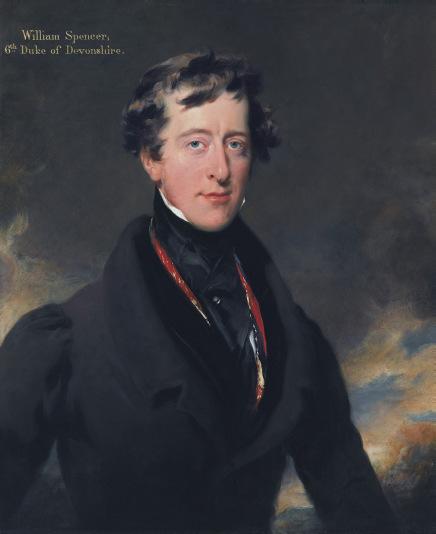

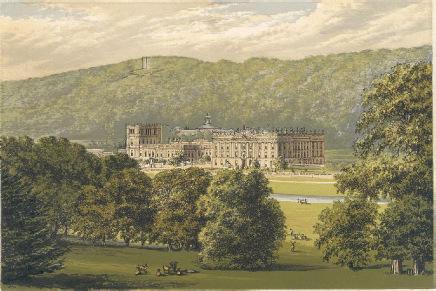
Sir Thomas Lawrence, P.R.A., Portrait of William Spencer Cavendish, 6th Duke of Devonshire (1790–1858), circa 1825, Private Collection
Devonshire House, London
Chatsworth, Derbyshire
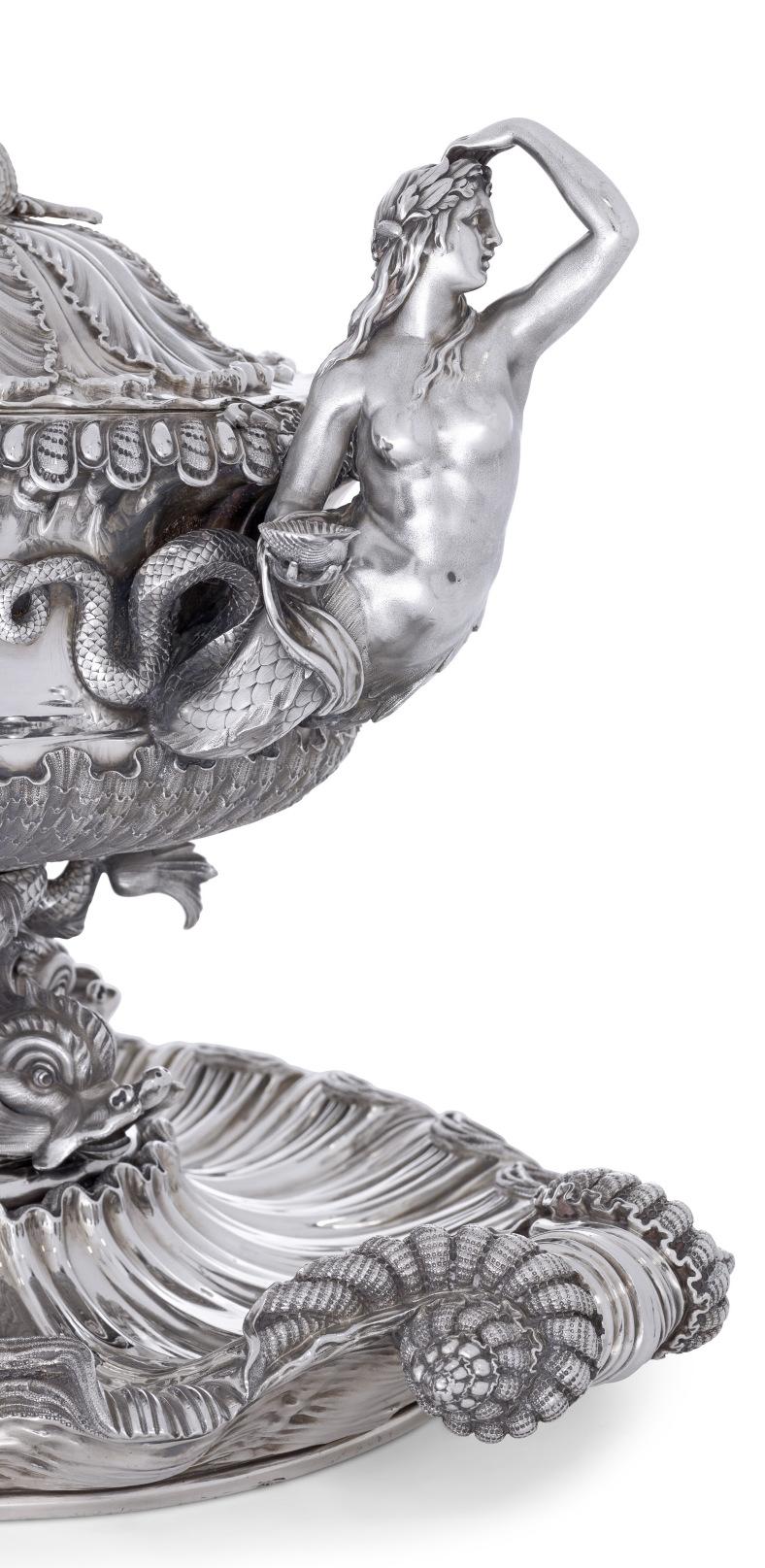
businesses and this may have been why the tureens commissioned from Garrard in 1819 by Lord Harborough and later in 1824 by Fletcher Norton, 3rd Baron Grantley (1796-1878), recently sold from Hotel Lambert, Sotheby's Paris, 14 October 2022, lot 875, were identical to those produced by Storr in 1821 for the Duke of Devonshire, and later in 1822 for the Portuguese nobleman, Henrique Teixeira de Sampaio, (1774-1833), sold from the von Buhlow Collection, Sotheby’s, New York, 28-29 October, 1988, lot 218. A pair of tureens marked for Garrard, dating from 1827-1829, of the same design, were made for Edward Barneby (1802-1871) of Saltmarshe Castle, Hereforshire; now in the collection of the Virginia Museum (Bliss, op. cit., pp. 204-207, no. 70).
It would seem very probable that all were made in Storr's workshop with the Harborough, Grantley and Barneby commissions being retailed through Garrard. It is notable that the 6th Duke of Devonshire patronised both silversmiths and the Great Service he commissioned to adorn the dining room of Devonshire House on Piccadilly and later the Great Dining Room at Chatsworth came from both firms. His diaries record visits to both companies. Perhaps the grandest components of the service were the pair of ten light candelabra, which are applied with Cavendish stags and with Apollo figures stems. They are marked for Storr and dated for 1813. Later in 1819 he turned to Robert Garrard the younger for the magnificent set of ten ice pails with dolphin stems, spirally fluted bodies and shell and seaweed strewn rims. The candelabra and ice pails, and the tureens cited below, were illustrated in The Devonshire Inheritance, Five Centuries of Collecting at Chatsworth, Alexandria, 2003, nos. 189, 190 and 191. When the marine tureens offered here were added to the service in 1820 and 1821, they were accompanied by a pair of equally massive tureens, embellished with eagle handles and feet, also by Storr, which remain in the Devonshire collection.
THE 6TH DUKE OF DEVONSHIRE AND THE GREAT DINING ROOM AT CHATSWORTH
William Spencer Cavendish (1790-1858), succeeded his father in 1811 at the young age of twenty-one. He was the youngest of his parents' three children. His inheritance allowed him to entertain lavishly, collect widely and embellish a number of the Cavendish houses, including Lismore Castle in Ireland, which he remodeled in the Gothic revival style and most notably the main family seat Chatsworth, to which he added the impressive Great North Wing to the designs of Jeffry Wyattville 1766-1840), later knighted for his work for the King at Windsor Castle. The North Wing allowed for the creation of the Great Dining Room, a sculpture gallery and ballroom, and below stairs a vast area of service rooms to enable entertaining on an almost regal scale. The Duke's magnificent commissions from Storr and Garrard were displayed in his Great Dining Room after its completion in 1832. As shown by the 1892 Devonshire House inventory the display plate travelled between Derbyshire and London for the London season.
A ROYAL TELESCOPE

PROPERTY FROM AN IMPORTANT PRIVATE COLLECTION
MORE
A SILVER-GILT TELESCOPE
DOLLOND, CIRCA 1860
The 2Ω-inch refractor with five draw tubes and screw dust cap, the main body embellished with fine raised floral motifs, and badge of the Prince of Wales and a device with the three tuğs of the Sultan above, signed to the eyepiece, signed to the eyepiece with sliding lens cover.
12Ωin. (32 cm.) closed 44in. (114 cm.) extended
£30,000-50,000
PROVENANCE:
US$41,000-68,000
€36,000-59,000
By repute: Royal gift to Abdul Aziz Khan, Sultan of Turkey (1861-1876) by Edward, Prince of Wales, later King Edward VII
By descent to Abdul Hamid II, Sultan of Turkey (1876-1909)
By Royal gift to M. Edward Huguenin, circa 1900.
With Sam Fogg, 2018.
Whence acquired by current owner.
This exceptional instrument remains one of the most impressive presentation telescopes ever crafted by London's leading optician. Remarkably preserved and highly ornate, this scientific instrument represents the collaboration and intersection between ornamentation and science. Presented in silver gilt the highly decorative body conceals a functioning telescope.
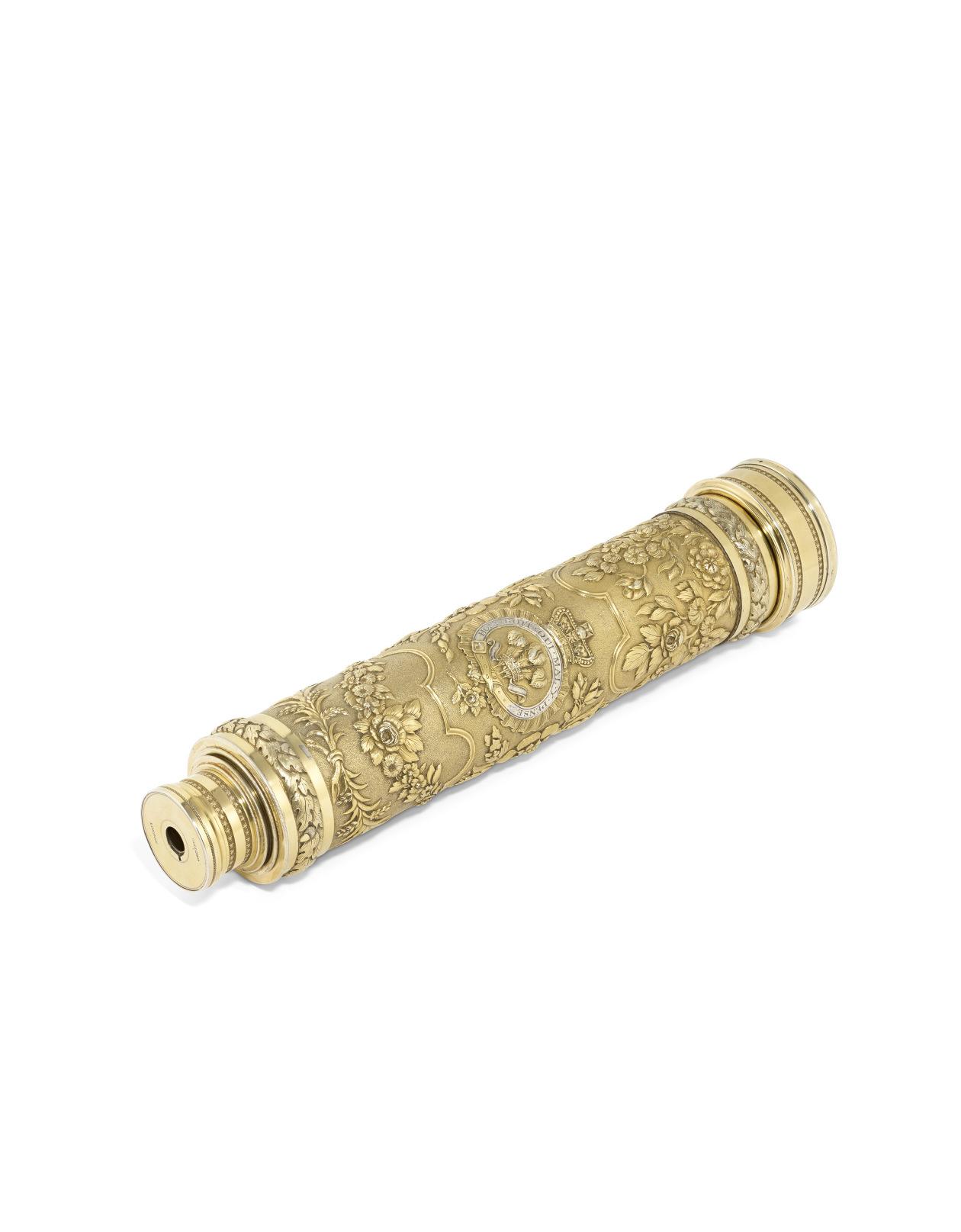
FORM & FUNCTION - A WORK OF ART BY FABERGÉ
A JEWELLED GUILLOCHÉ ENAMEL AND SILVER-GILT DESK CLOCK
BY FABERGÉ, WORKMASTER HENRIK WIGSTRÖM, ST PETERSBURG,
1908-1917, SCRATCHED
INVENTORY NUMBER 23245
Rectangular, the central panel enamelled in translucent scarlet red over a wavy guilloché ground, centring a white enamel dial with Arabic chapters within a seed-pearl bezel, the outer panel enamelled in translucent apple green over a moiré guilloché ground, all within a silver-gilt laurel-chased rim with rosettes at corners, the ribbon crest at the top suspending ribbon-tied laurel swags, the ivorine back with a silver scroll strut, the back-plate with hand-set, marked on rim, back and strut with ‘Fabergé’ in Cyrillic and workmaster’s initials 5√ in. (14.9 cm.) high
£60,000-80,000
PROVENANCE:
Property of a Scandinavian Collector. Anonymous sale; Sotheby’s, London, 8 June 2011, lot 507.
US$81,000-110,000
€72,000-95,000
In addition to Fabergé’s impeccable craftsmanship and wit, his genius also lay in his ability to create works of art that would be used in everyday life. Fabergé’s objects of function included desk clocks, cigarette cases, scent bottles, frames, bell-pushes, cigarette lighters and cane handles – to name but a few. They were designed for convenient use on the writing table or to be carried on the person, and were not intended as museum pieces.
The production of practical objects began in the 1880s. The head workmasters of Fabergé transformed everything from clocks to cane handles into imaginative works of art. It was this trademark ability to enhance everyday objects through the application of sophisticated enamelling techniques, goldsmithing and stone-setting that made Fabergé internationally famous.
Fabergé’s items of function were in huge demand among his contemporaries who wanted to surround themselves with elegant and useful objects. The firm’s craftsmen had to make practical items attractive without being bulky and inconvenient.
The present desk clock is a wonderful testimony to how Fabergé managed to turn the production of utilitarian objects into an art form. His ingenious designs and techniques transform seemingly mundane objects into the most desirable works of art.

SPOILS OF THE CHASE
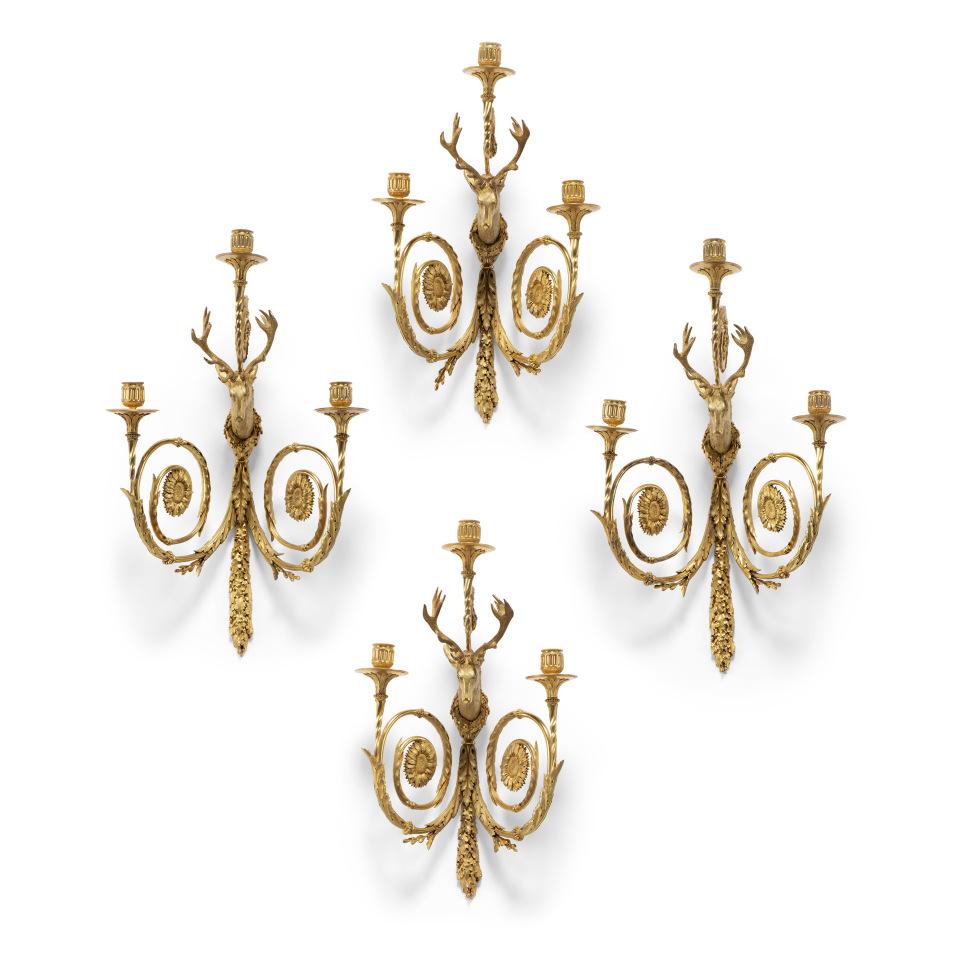
PROPERTY FROM AN IMPORTANT PRIVATE COLLECTION
■18
A SET OF FOUR LOUIS XVI ORMOLU THREE-LIGHT WALL-LIGHTS
LATE 18TH CENTURY
Comprising two pairs, each with a backplate cast with oak foliage surmounted by a stag's head, the antlers with fourteen points, with three scrolling twisted branches with sunflowers and terminating with nozzles, differences in size
21 in. (53.5 cm.) high; 12 ¾ in. (31 cm.) wide
18 ¼ in. (46.5 cm.) high; 10 ¾ in. (28 cm.) wide; the other pair (4)
£60,000-100,000
PROVENANCE:
Anonymous sale; Christie's, London, 23 May 2018, lot 253.
US$81,000-140,000
€71,000-120,000
Reflecting the importance of the hunt in the culture and ritual of the French court, this set of four wall-lights are identical to a pair housed in the château de Versailles, which were previously listed in the château de Fontainebleau from 1806. Although the precise provenance is unknown, this set was likely part of the same commission as the Versailles pair and was possibly ordered for one of the French royal residences frequently used for the pursuit of hunting.
54 In addition to the hammer price, a Buyer’s Premium (plus VAT) is payable. Other taxes and/or an Artist Resale Royalty fee are also payable if the lot has a tax or λ symbol. Check Section D of the Conditions of Sale at the back of this catalogue.
LEARN MORE
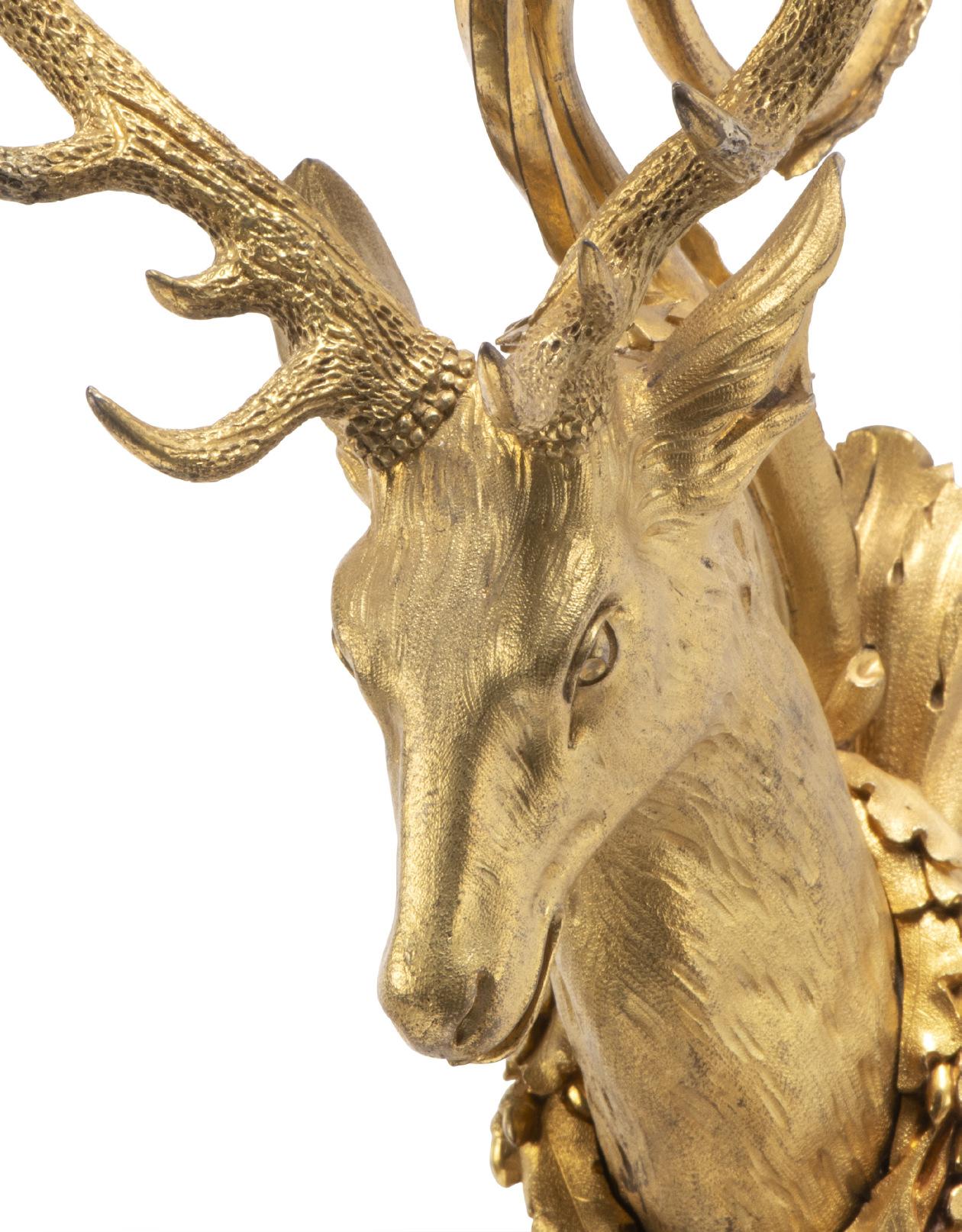
ILLUMINATION FROM BOHEMIA
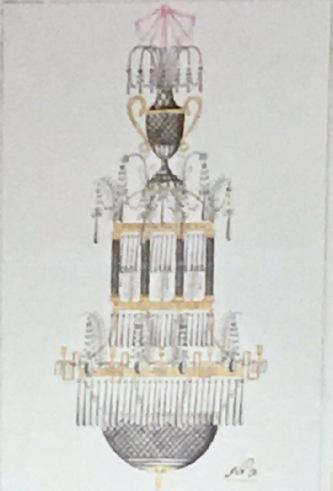
PROPERTY FROM AN IMPORTANT PRIVATE COLLECTION ■19
A NEOCLASSICAL ORMOLU-MOUNTED CRYSTAL AND GLASS EIGHT-BRANCH CHANDELIER
PRAGUE, LATE 18TH CENTURY
The vase coronet issuing branches joined by faceted swags, above a central dish and circlet issuing swags surmounted by diamond-shaped drops and suspending rings of ribbon-tied pendants, supported by four diamond-cut and bevelled columns with ormolu capitals, above a circlet decorated with overlapping arched motif issuing eight square-section branches hung with pendants, the circlet hung with rings of pendants and centred by a lobed dish with acorn boss, fitted for electricity, losses, replacements and restorations
47º in. (120 cm.) high; 36 in. (92 cm.) diameter
£70,000-100,000
PROVENANCE:
US$95,000-140,000
€83,000-120,000
Private collection, from a Parisian apartment decorated by Daniel Pasgrimaud; sold Christie's, Paris, 30 November 2016, lot 31.
This striking chandelier of architectural form and costly Bohemian cut-glass relates closely to a late 18th-century design for a chandelier from a Prague workshop, probably the maker of this example. The highly sophisticated combination of faceted cut-glass and architectural giltmetal elements make this a rare survival of neoclassical production from the Bohemian glass manufactories.
Design for a closely related Bohemian chandelier, Prague
LEARN MORE
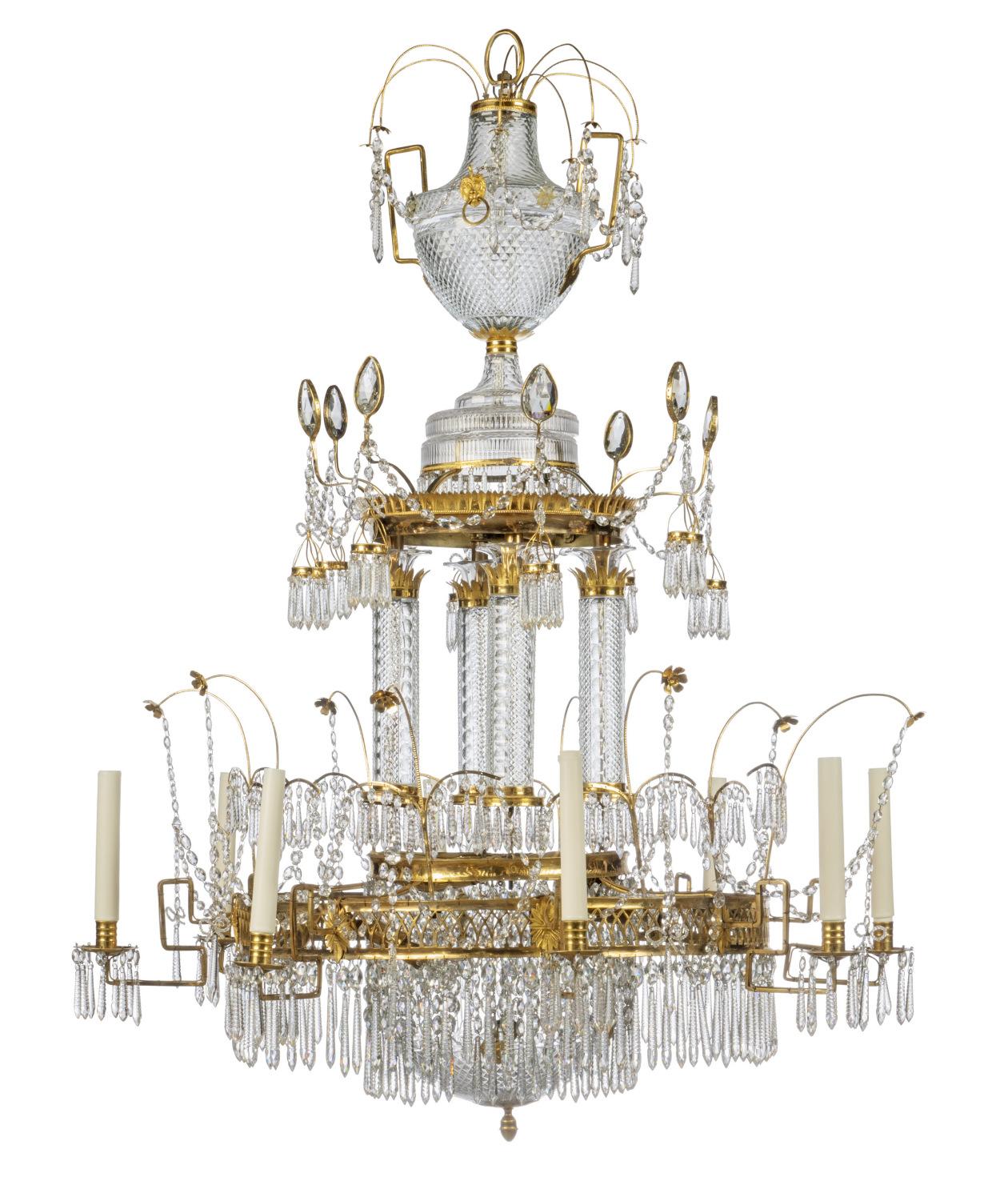
FIT FOR A MAHARAJAH - A MAGNIFICENT SUITE OF GLASS FURNITURE BY OSLER
THE LEGACY OF THE OSLER LINEAGE
The firm of Osler was established in 1807 by Thomas Osler on Broad Street in Birmingham, England and, in its infancy, produced small prisms and ornamentation for chandeliers. When Osler’s entrepreneurial sons Follett (d. 1903) and Clarkson (d. 1876) joined the firm in 1831, re-establishing the firm as F.& C. Osler, they expanded their production to include ambitious candelabra, chandeliers and decorative furnishings, such as this stunning group of from a distinguished private collection.
The firm flourished under the brothers in the mid-1840s and Osler’s highly conceptual and innovative output required ‘equally magnificent patrons’, the most notable of which they engaged in 1847 when Ibrahim Pasha (d. 1848), then ruler of Egypt, visited Birmingham and commissioned a pair of opulent candelabra of monumental scale to place at Mohammed’s tomb in Mecca. This led to subsequent commissions for similar candelabra by the ruler of Nepal and the Prince of Wales. The Prince had a well-known interest in technical innovation and commissioned Osler on 24 May 1848 to produce a pair of candelabra to mark the occasion of the Queen’s birthday, which now reside in the collection of Osborne House on the Isle of Wight.
The commission by the Prince inspired Follett Osler to design an exponentially ambitious and towering central fountain of crystal glass which he proposed to the committee organizing the Crystal Palace Exhibition of 1851 in London. The fountain stood twenty-seven feet in the center of the famed Crystal Palace, miraculously erected in the center of Hyde Park.
In 1878, the Osler firm participated in the Exposition Universelle in Paris where they unveiled their innovative production of glass furniture utilizing thicker, stronger sections of glass. Among the works exhibited was a throne chair, stool and cabinet of equally impressive scale as the present lot, though the piece boasted a neo-Gothic design with pierced balustrade, arched cornices and spires. The official exhibition catalogue notes ‘its exceeding grace and beauty’ and that ‘few objects in the Exhibition attracted more attention or greater admiration’ (The Illustrated Catalogue of the Paris International Exhibition, London, 1878, p. 142). Other French firms like Baccarat similarly unveiled glass furniture at this exhibition, but the scale and artistry of Osler’s works were predominant.

OSLER IN INDIA
Despite exceedingly positive reception at the 1878 Exposition Universelle, Osler’s furnishings were not met with overwhelming favor from British consumers, nor an influx of homebound commissions. Spillman notes that Osler’s furniture failed to receive an award at the fair, nor would the firm exhibit furnishings again internationally after this initial foray. One critic mentioned ‘this cabinet and an arm chair and stool are not likely to find purchasers in England, but are more suited, and I hear are intended, to adorn the palace of some Eastern Potentate. Osler’s shift of focus to India was one born out of the vast amount of opportunity and growing wealth in the colonies, specifically in Calcutta, which at that time was one of the world’s largest ports. India became viewed as ‘a land of fabulously wealthy individuals who were able to buy into every kind of luxury good’ and subsequently it was Osler’s ostentatious output that ‘became more and more associated with a fabulous otherness’.
The firm was one of the first European glass makers to recognize the potential of the burgeoning ‘Eastern’ market. Prior to the 1840’s the firm worked with Hamilton & Co. silversmith and jewelers in Calcutta, India, but by 1843 the company had established their own local presence hiring a full time agent. By 1862, the firm had expanded their export business and their client base included a number of international clientele following successful displays of lighting, trays, hookahs and drink sets at numerous fairs. At first, the firm’s export included mainly colored glass chandeliers and candelabra, significantly more popular in the Eastern market than in Europe. The display of the aforementioned glass furniture at the 1878 Exposition Universelle particularly interested Osler’s Indian clientele, for which glass furniture was quite a practical medium. The coolness of the material and its imperviousness to the hot, humid climate made it particularly suitable. Even further, the geometric patterning of the molded glass was appropriately aligned with Eastern principles that prevented the depictions of figures, so often seen on elaborate European furniture. The opulence of these prismatic works were desirable to the Maharajahs and Indian elite who were embarking on upon a palatial building program. A substantial order from Osler of tables, armchairs, beds and fountains was made for Maharana Sajjan Singh (d. 1884), and although he died before its delivery, his collection is today preserved in the crystal gallery at the Fateh Prakash Palace, Udaipur.
A price list from October 1868 indicates that the firm prepared a list of various colored glass light fixtures ordered by the Maharaja of Patiala, Mohinder Singh. In a letter dated to 8 March 1870, the writer responded to Osler that ‘all the chandeliers are suspended at Puttiala and the candelabrum placed in the receptions room’. The writer, seemingly a personal secretary, specifically mentions that the Maharajah sought to engage Osler almost exclusively for decorations, as ‘the Puttiala Raja has been a minor until recently...now that he has come of age, he is spending prodigiously. Osler produced two large pattern books, each with hand-drawn and colored designs. The drawings are numbered and often dated, though the customers are infrequently named.
Cover of F & C. Osler Calcutta Catalogue, circa 1900
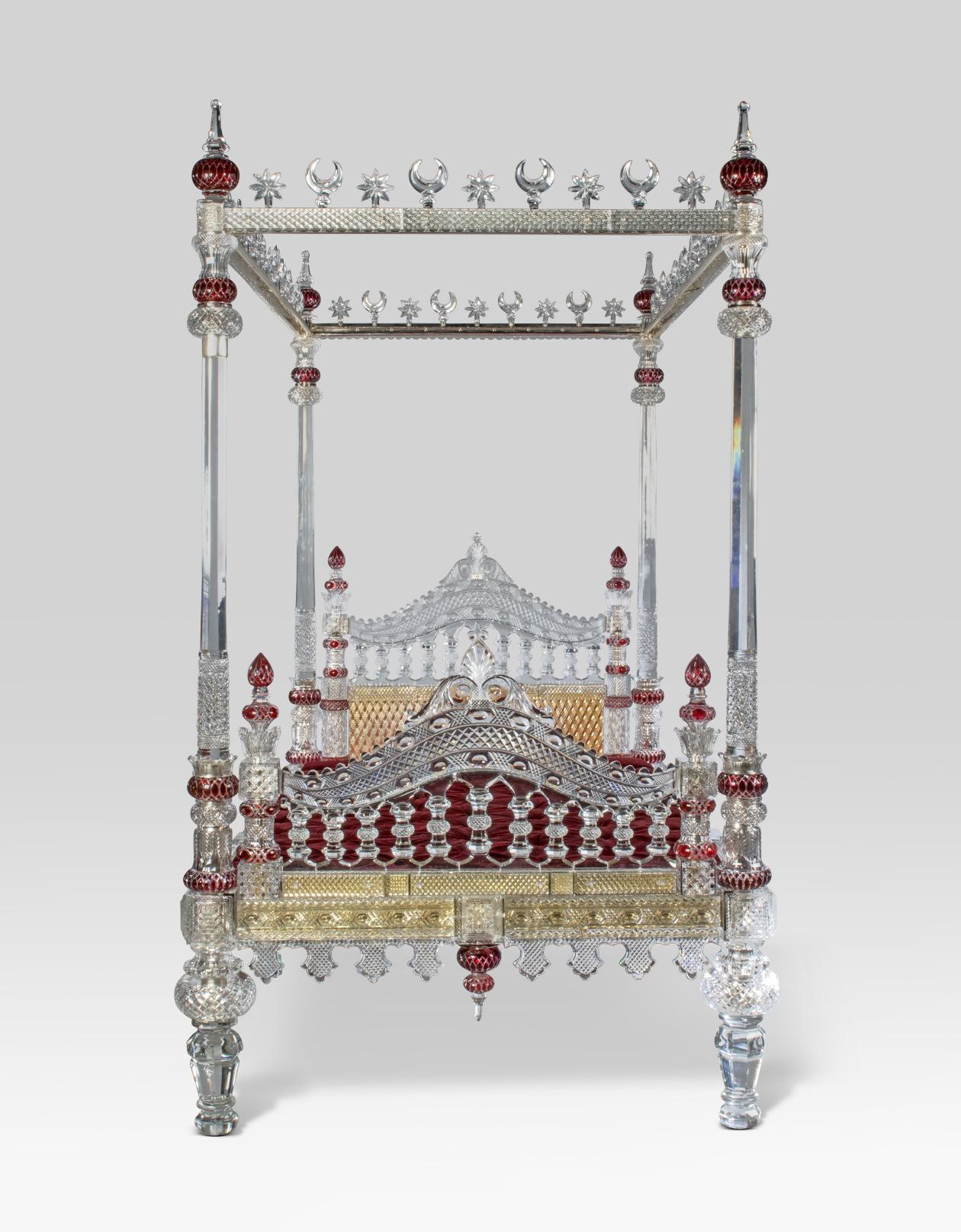
PROPERTY FROM AN IMPORTANT PRIVATE COLLECTION
A VICTORIAN GILT-METAL, CUT-CRYSTAL AND RUBY GLASS FOURPOSTER BED
ATTRIBUTED TO F. & C. OSLER, BIRMINGHAM, CIRCA 1880-1890, AND LATER
Of typical form, with four faceted posts joined by silver-plated and faceted rails supporting alternating crescent moon and stars, with a boss to each corner, the headboard and footboard conformingly decorated with turned columns culminating in a highly decorative pineapple and trefoil finial, the sides with further flanking turned columns, the headboard above a faceted frieze centred by geometric design with a gilt background, similar gilt background to lower portion of the footboard, the sides of the bed with crenellated motifs, punctuated by double-sphere pendants, on four turned tapering legs, with later crimson buttoned velvet coverlet, replacements and restorations 99 in. (251 cm.) high; 55 in. (140 cm.) wide; 95º in. (242 cm.) deep
£100,000-150,000
PROVENANCE:
By tradition commissioned by an Indian Royal Family, circa 1880-90. With Oliver Forge and Brendan Lynch Ltd., 2014.
COMPARATIVE LITERATURE:
US$140,000-200,000
€120,000-180,000
D. Ahlawat, "Empire of Glass: F. & C. Osler in India, 1840-1930", Journal of Design History, vol. 21, Oxford, 2008.
J. Smith, Osler's Crystal for Royalty and Rajahs, London, 1991.
A. Jaffer, Made for Maharajas: A Design Diary of Princely India, London, 2006.
J. Spillman, “F.&C. Osler”, Corning Museum of Glass website, 16 January 2018.
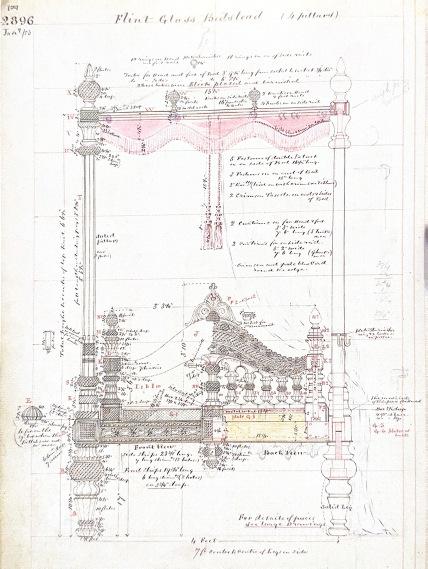
for a Glass Bed, dated January 1883 in Osler’s Pattern Book. Courtesy of the Birmingham Museum and Art Gallery
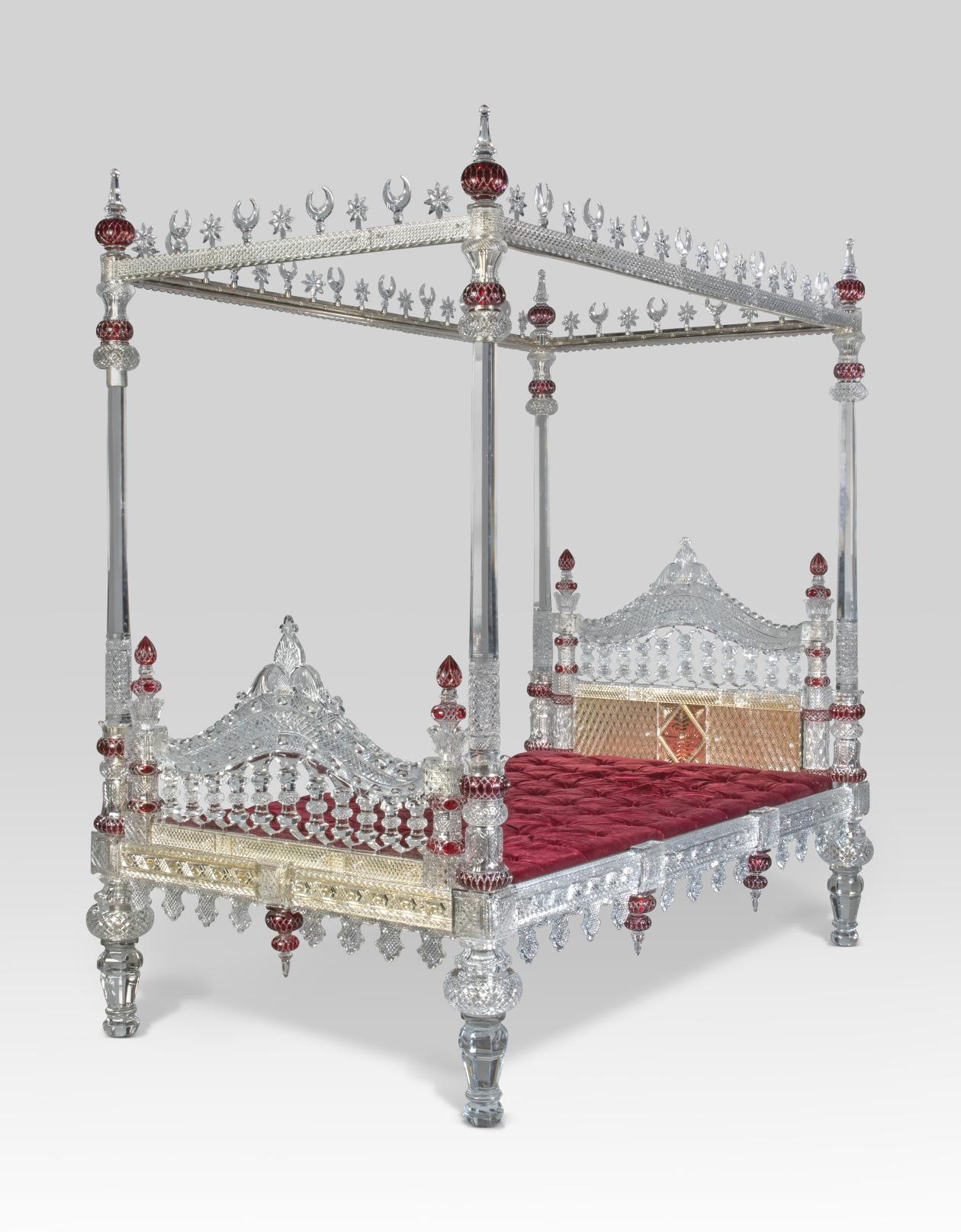
PROPERTY FROM AN IMPORTANT PRIVATE COLLECTION ■21
A PAIR OF VICTORIAN CUT-CRYSTAL, RUBY GLASS AND SILVEREDMETAL OCCASIONAL-TABLES
BY F. & C. OSLER, BIRMINGHAM, CIRCA 1880-90, AND LATER
Each with circular mirrored top with moulded border and faceted frieze hung with pendant lobes on a columnar support with spreading circular base on bun feet, stamped 'F & C. OSLER', replacements and restorations
46æ in. (119 cm.) high; 15 in. (38 cm.) diameter
£15,000-25,000
PROVENANCE:
By tradition commissioned by an Indian Royal Family, circa 1880-90. With Oliver Forge and Brendan Lynch Ltd., 2014.
EXHIBITED:
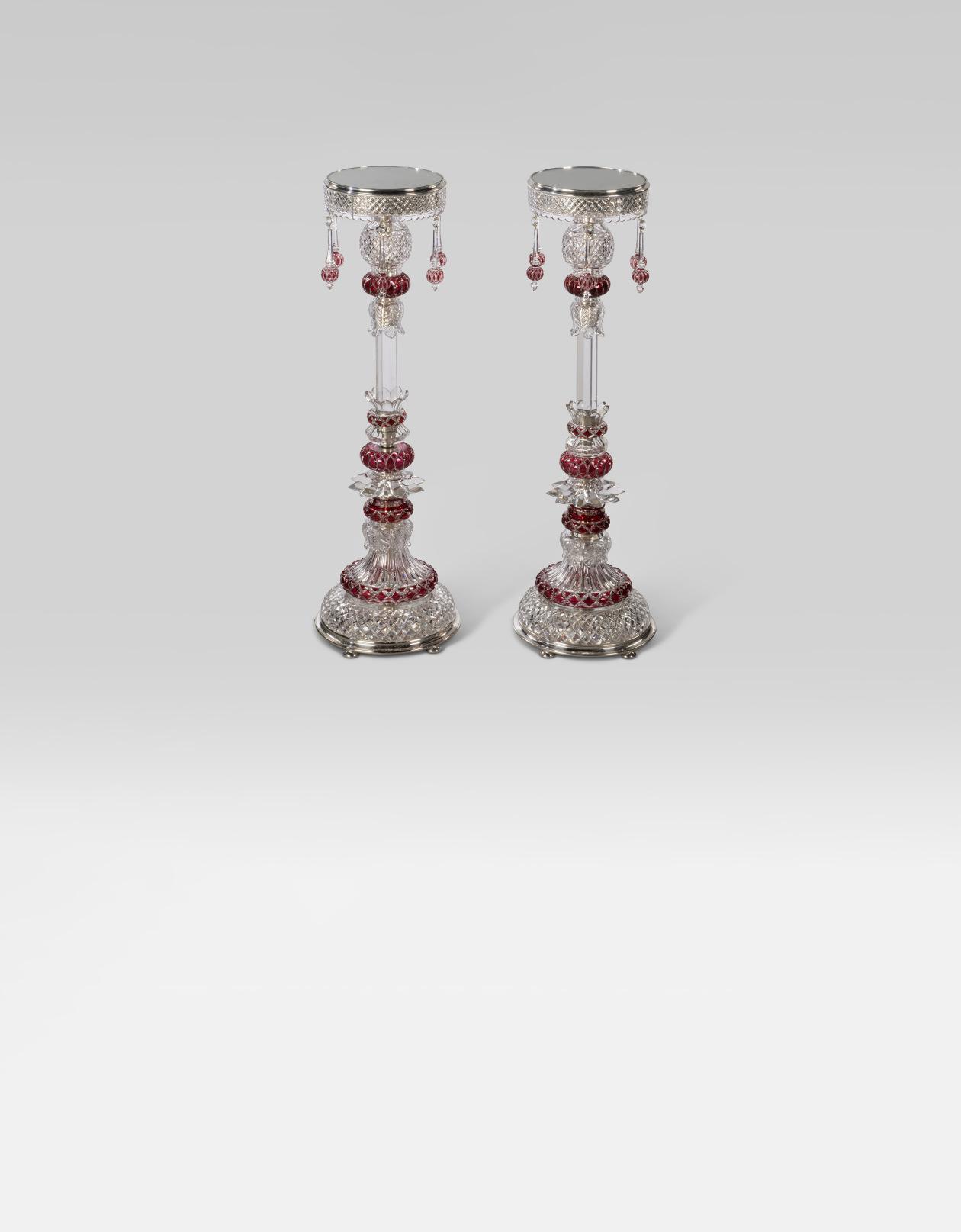
US$21,000-34,000
€18,000-30,000
London, Victoria & Albert Museum, Maharaja: The Splendour of India's Royal Courts, 10 October 2009 to 17 January 2010.
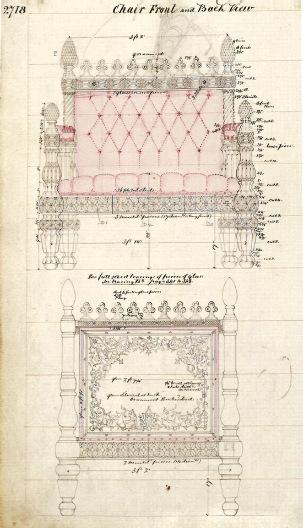
PROPERTY FROM AN IMPORTANT PRIVATE COLLECTION ■22
A VICTORIAN CUT-CRYSTAL THRONE CHAIR
ATTRIBUTED TO F. & C. OSLER, BIRMINGHAM, LAST QUARTER 19TH CENTURY, THE SIDE CHAIR LATER
The rectangular padded back, arms, and seat covered with later buttoned crimson velvet, the cresting with trefoils flanked by faceted finials above spiral stiles, the arms with short columnar supports, on tapering legs with spirally-fluted ball feet, replacements and restorations, together with a cut-crystal side chair
The throne chair: 54 in. (137 cm.) high; 50æ in. (129 cm.) wide; 29Ω in. (75 cm.) deep
The side chair: 50 in. (127 cm.) high; 18æ in. (48 cm.) wide; 18Ω in. (47.5 cm.) deep (2)
£20,000-30,000
PROVENANCE:
The throne chair: By tradition commissioned by an Indian Royal Family, circa 1880-90. With Oliver Forge and Brendan Lynch Ltd., 2014. The side chair: With Essaaef Trading, 2016.
COMPARATIVE LITERATURE:
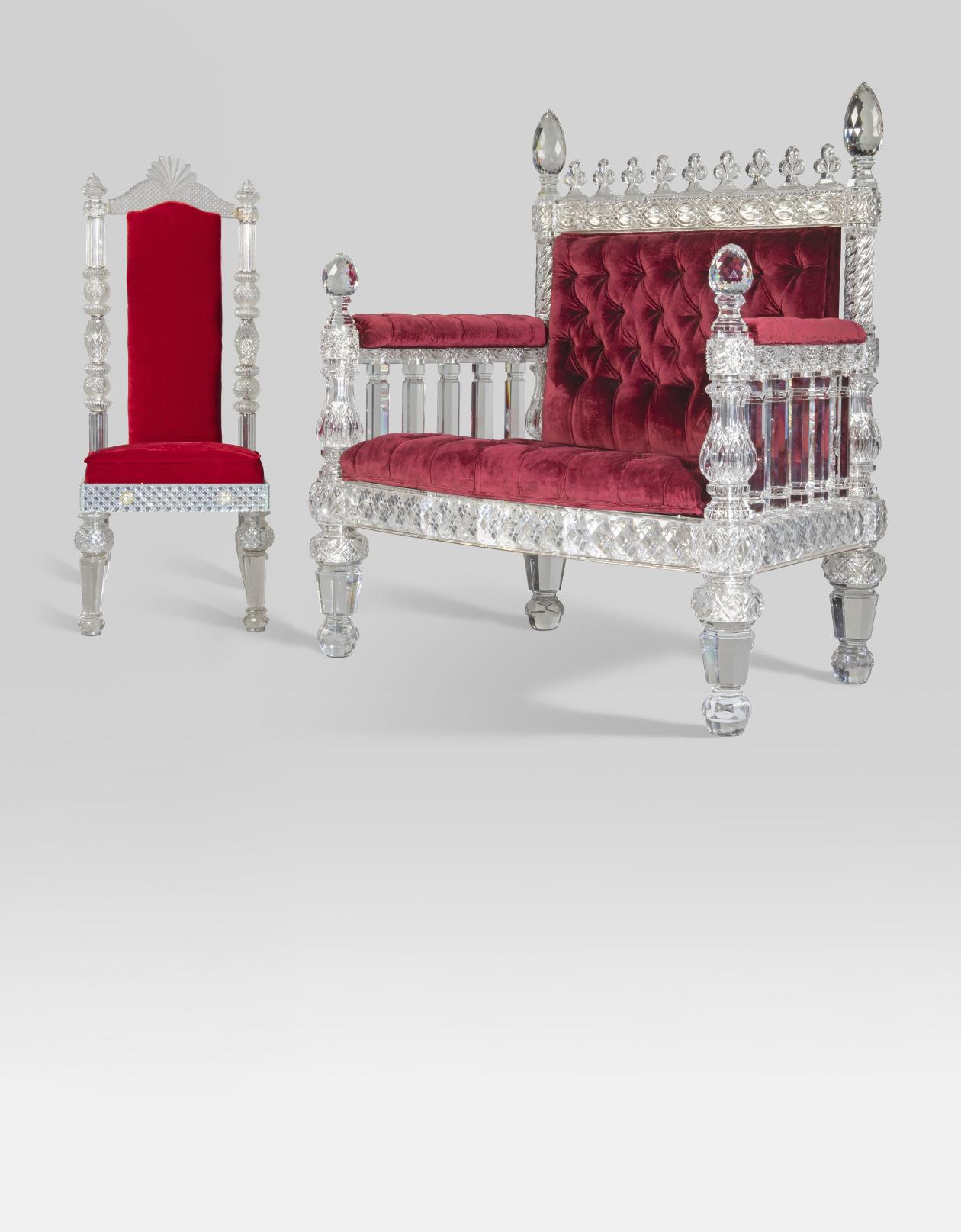
US$27,000-41,000
€24,000-35,000
D. Ahlawat, "Empire of Glass: F. & C. Osler in India, 1840-1930", Journal of Design History, vol. 21, Oxford, 2008.
J. Smith, Osler's Crystal for Royalty and Rajahs, London, 1991.
A. Jaffer, Made for Maharajas: A Design Diary of Princely India, London, 2006.
J. Spillman, “F.&C. Osler”, Corning Museum of Glass website, 16 January 2018.
PROPERTY FROM AN IMPORTANT PRIVATE COLLECTION
A PAIR OF VICTORIAN CUT-CRYSTAL, EBONISED AND PARCEL-GILT CHEVAL MIRRORS
BY F. & C. OSLER, BIRMINGHAM, CIRCA 1880-90, AND LATER
Of typical form, with foliate cresting rail flanked by two spheres, the mirror panel engraved with a trailing foliate border interspersed with rosettes, the verso ebonised and parcel gilt, with two rectangular engraved mirror plates displaying classically arranged flowerheads within a geometric frame, the whole supported by a pair of termed and faceted columnar uprights headed by a flower head with silver swivel mechanism, on cabriole legs joined by stretcher headed by acorn finals, stamped 'F & C. OSLER', restorations and replacements 76º in. (194 cm.) high; 38 in. (96 cm.) wide; 23Ω in. (60 cm.) deep (2)
£50,000-80,000
PROVENANCE:
By tradition commissioned by an Indian Royal Family, circa 1880-90. With Oliver Forge and Brendan Lynch Ltd., 2014.
COMPARATIVE LITERATURE:
US$68,000-110,000
€60,000-95,000
D. Ahlawat, "Empire of Glass: F. & C. Osler in India, 1840-1930", Journal of Design History, vol. 21, Oxford, 2008.
J. Smith, Osler's Crystal for Royalty and Rajahs, London, 1991.
J. Spillman, “F.&C. Osler”, Corning Museum of Glass website, 16 January 2018.
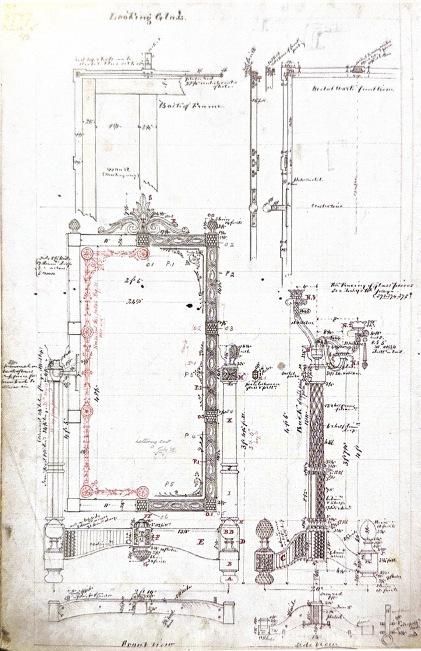
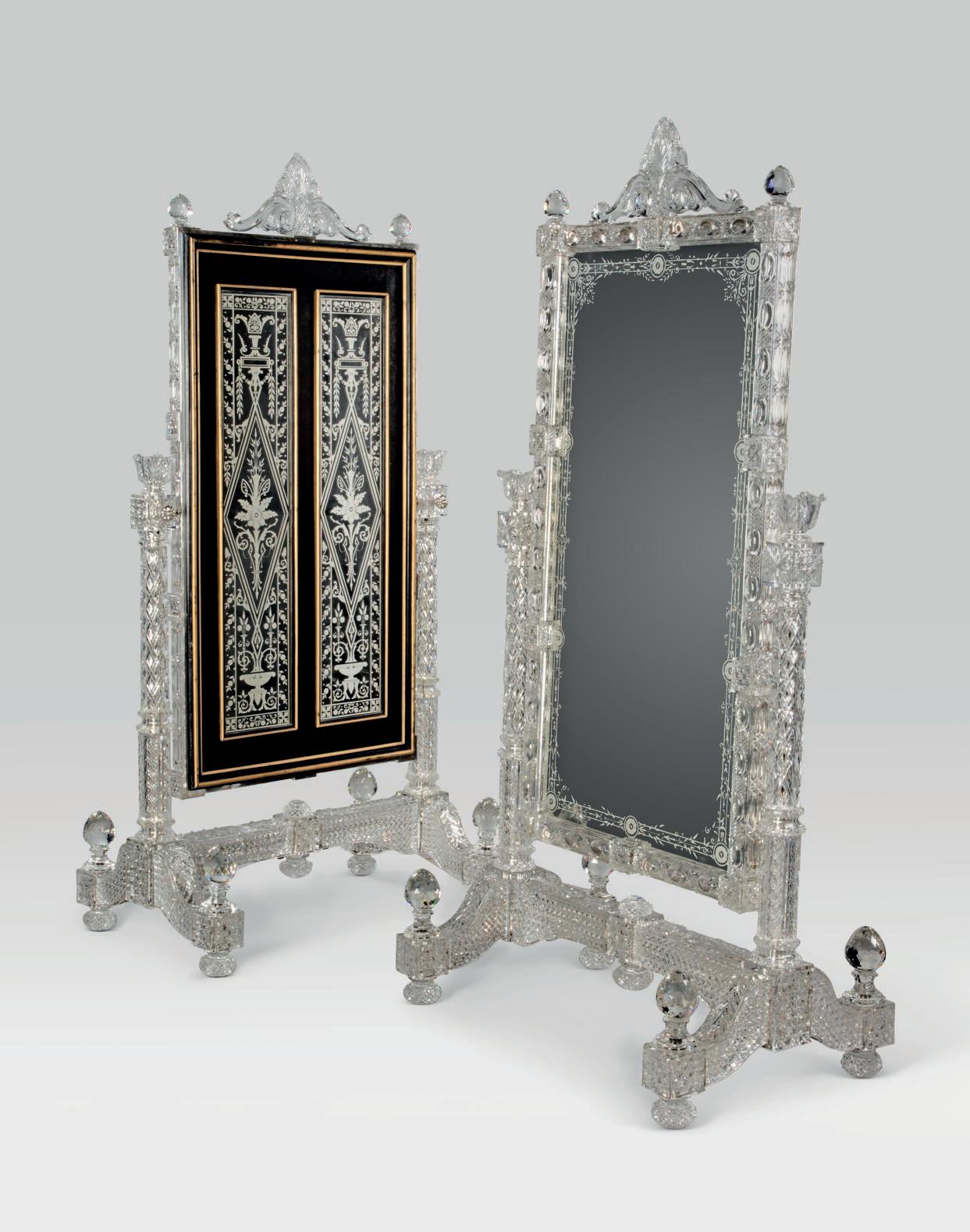
FROM THE BARON DE MERODE TO THE BARON DE ROTHSCHILD
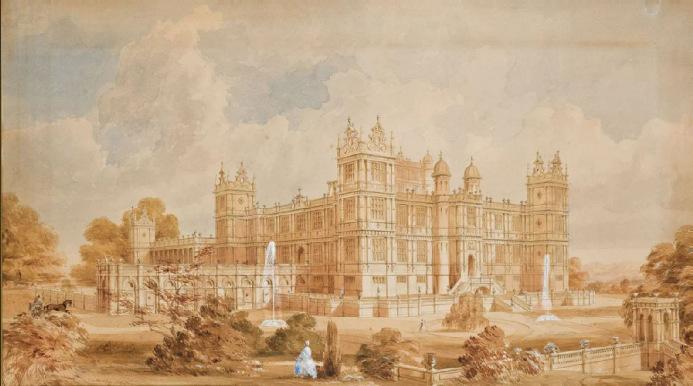
PROPERTY FROM AN IMPORTANT PRIVATE COLLECTION
■*24
A
MONUMENTAL GERMAN ETCHED-GLASS PIER
MIRROR
ATTRIBUTED TO SPIEGELMANUFAKTUR LOHR AM MAIN, CIRCA 1721
Finely and elaborately engraved overall, with a plumed scrolling cresting etched with arabesques, cannons and centered by a mask above the arms of Jean-Philippe-Eugène, Comte de Mérode, above a later rectangular beveled mirror plate within wide mirrored frame etched and cut with spherules and foliage, inset with panels of knights in armor, equestrian battles and allegories of war and peace, the military flags inscribed with the initials C VI for Charles VI, the reverse inscribed in yellow chalk 1201 and an old paper label inscribed 3134, some replacements to plates 132½ in. (336.5 cm.) high, 60½ in. (154 cm.) wide
£50,000-80,000
PROVENANCE:
US$68,000-110,000
€60,000-95,000
Eugène-Philippe de Merode (1674-1732), Baron de Merode, Maréchal de Camp to Holy Roman Emperor Charles VI. Almost certainly acquired by Baron Mayer Amschel de Rothschild (1818-1874) or his daughter Hannah Primrose, Countess of Rosebery (1851-1890), thence by descent until sold, The Earl of Rosebery, Mentmore; Sotheby's, London, 18-20 May 1977, lot 837.
Acquired from Mallett, London, in 1988. 'Property from the Collection of Mona Ackerman', The Exceptional Sale; Christie's, New York, 11 December 2014, lot 42, where acquired by the present owner.
LITERATURE:
L. Synge, Mallett's Great English Furniture, London, 1991, p. 198. Mentmore, Edinburgh [privately printed], 1884, Vol. II, p. 62.
This grand mirror, likely crafted at the Spiegelmanufaktur Lohr am Main, boasts a remarkable provenance. With intricate and finely etched work, the mirror bears the arms of the Comte de Mérode, a Maréchal de Camp to Emperor Charles VI. In the 19th century the mirror formed part of the collection of Mentmore Towers, the great treasure house assembled by Baron Mayer Amschel de Rothschild and was sold at the legendary sale of the collection in 1977.
Mentmore Towers, Buckinghamshire
LEARN MORE
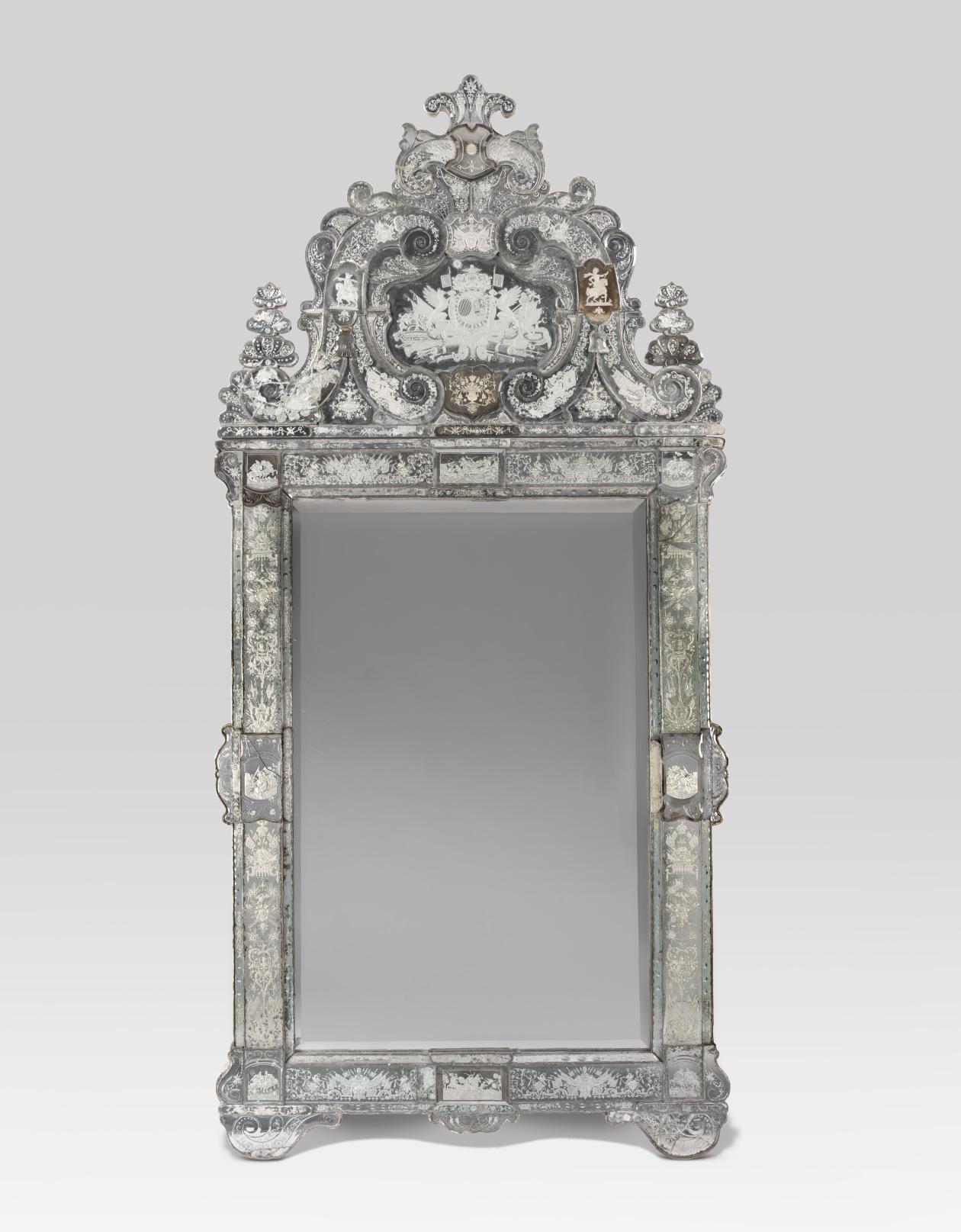
FLOWN AT THE BATTLE OF TRAFALGAR –THE UNION JACK OF HMS SPARTIATE
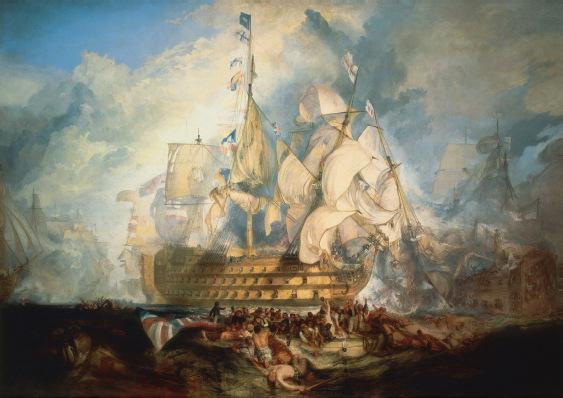
PROPERTY FROM THE ZARICOR FLAG COLLECTION ■*25
A UNION JACK FLOWN FROM HMS SPARTIATE AT THE BATTLE OF TRAFALGAR, 21 OCTOBER 1805
A yard- or shipboard-hand-stitched wool-bunting flag, comprised of thirty-one bunting panels with canvas sleeve and lanyard, on an archival muslin backing 911/3in. (232cm.) x 1381/2in. (352cm.)
£500,000-800,000
PROVENANCE:
US$680,000-1,100,000
€600,000-950,000
Captain James Clephan R.N. (1768-1851), Thence by descent until sold Charles Miller Ltd, London, 21 October 2009, lot 54 (£396,800). Acquired from the above by Benjamin Reed Zaricor (1947-2022) for the Zaricor Flag Collection.
EXHIBITED:
24th International Congress of Vexillology and 45th annual meeting of the North American Vexillological Association. Washington, DC & Alexandria, VA, 31 July - 6 August 2011
The Battle of Trafalgar remains one of the most spectacular and consequential naval victories in history, ending the threat of an invasion of Britain by Napoleon, and setting the scene for a century or more of British dominance of the seas. It was achieved in the face of the numerical superiority of the allied French and Spanish fleets, which had six more ships of the line, carrying 420 more guns and almost double the manpower of the British fleet: the victory was due to the unorthodox tactics of Admiral Horatio Nelson, directing his fleet in two columns to cut the extended Franco-Spanish line at right angles, thus inducing a mêlée in which the superior seamanship, gunnery and morale of the British fleet were decisive. Twenty of the 33 ships in the Franco-Spanish fleet were captured: the British fleet lost none. Nelson's death during the battle is still one of the emblematic moments of British history.
Joseph Mallord William Turner, The Battle of Trafalgar, 21 October 1805, 1822-1824
© Royal Museums Greenwhich
LEARN MORE

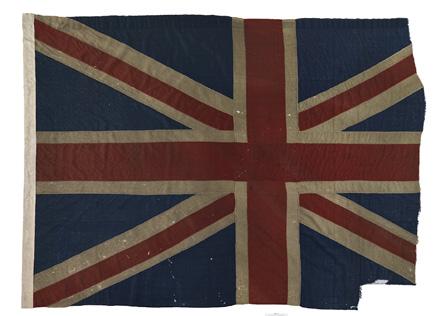
This Union Flag would have been flown prominently by HMS Spartiate, most likely from the foretopgallant stay, as she sailed slowly towards the waiting line of the Franco-Spanish fleet off Cape Trafalgar. Under ordinary circumstances Union Jacks were flown only when in port, from a jack staff on the ship's bowsprit, and their use in battle at Trafalgar was in accordance with a specific order issued by Nelson only 11 days beforehand, on 10 October 1805: 'When in presence of the Enemy, all the ships under my command are to bear White Colours [i.e. the White Ensign] and a Union Jack is to be suspended from the foretopgallant stay'. This was to enable the British ships to recognise each other in the confusion of battle: Nelson insisted on a yellow and black paint scheme for his ships, the 'Nelson Chequer', for the same reason. The Spartiate may possibly have flown more than one Union Jack: a midshipman on the British HMS Neptune, ahead of Spartiate in the windward column, remembered looking back and seeing 'unionjacks and ensigns ... made fast to the fore and fore-topmast-stays, as well as to the mizzen-rigging, besides one at the peak, in order that we might not mistake each other in the smoke' (Roy Adkins. Trafalgar: The Biography of a Battle, 2004, 97).
The 74-gun HMS Spartiate was originally a French ship, and formed part of the fleet defeated by Nelson at the Battle of the Nile on 1 August 1798: supposedly it was from Spartiate that Nelson received the wound to his forehead at the battle. Captured at the Nile, she was commissioned into the British Navy in the following year. At Trafalgar, she was commanded by Captain (later Admiral) Sir Francis Laforey, 2nd Bart, under whom she had taken part in the unsuccessful pursuit of the French fleet across the Atlantic in 1804 and the subsequent blockade of Cadiz. Along with HMS Minotaur, the Spartiate was at the rear of Nelson's northern, windward column at Trafalgar, and the slow rate of sailing of both ships was to prevent them from joining the action until some two hours after Collingwood aboard Royal Sovereign had been the first to breach the Franco-Spanish line. However, shortly after 2.30pm they played a significant role in driving off the four unengaged ships of the French vanguard under Rear-Admiral Dumanoir Le Pelley, firing broadsides into Dumanoir's Formidable. At around 4.30pm, the two ships then engaged the Spanish 84-gun Neptuno, which surrendered after a fight of around an hour. The Spartiate sustained three killed and 20 wounded: according to The Trafalgar Roll she 'had her foretopsail yard shot away, and her masts, yards, and rigging in general were a good deal damaged'. After Trafalgar Spartiate served at Rochefort in 1807-08, and in June 1809 took part in the capture of the islands of Ischia and Procida off Naples: she continued in active service until 1835, before being made a sheer hulk at Plymouth in 1842, where she was broken up in 1857.
It was common practice for warrant officers or junior officers to take ensigns as rewards after a battle: the Spartiate's second lieutenant, James Clephan (1768-1851) preserved the present flag. Born in Fife, Clephan had been apprenticed in the merchant service before being pressganged into the navy in 1794 as an able seaman: he was made
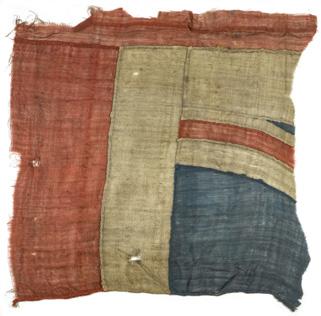
Master's Mate in 1795, and still held that rank aboard the Doris in 1801 when he distinguished himself in the cutting out of the Chevrette near Brest, whereupon he was promoted lieutenant for 'his distinguished gallantry on that memorable occasion, when, although knocked overboard while ascending her side, he was the first to gain the enemy’s deck, and there received several slight wounds' (W.R. O'Byrne.
A Naval Biographical Dictionary): Admiral Cornwallis is reported to have commented of his promotion that 'few officers have earned it so hardly'. Clephan became first lieutenant of Spartiate immediately after Trafalgar, at the special request of Captain Laforey. He was made Commander in 1811, and in the War of 1812 against the United States whilst commanding the sloop Charybdis captured the American privateer Blockade near the Isle of Saba in the Caribbean; he also served in the unsuccessful assault on New Orleans in 1814-15. He went on half-pay on 23 August 1815 and retired with the rank of Captain in 1840, one of only a handful of men to have reached that rank from the lower decks during the Napoleonic period.
Only two other complete British flags are known to survive from Trafalgar, both Union Jacks: the first, from HMS Minotaur (which sailed alongside Spartiate into action) was preserved by Stephen Hilton, Master's Mate, and subsequently presented by his descendants to the church of St Mary’s, Selling, Kent, from whom it was purchased privately by the National Maritime Museum in 2012, together with an Austrian Ensign thought to have been retrieved by Hilton from the Spanish Neptuno. The second, from HMS Royal Sovereign, was kept by Charles Antram, also Master's Mate, and remained in private hands until publicly identified in May 2025. Minotaur's flag is of comparable size to Spartiate's at 226.5 x 311cm, having suffered a loss to its righthand edge, and with an oblong section cut away from the lower edge, perhaps as a souvenir; the Union Jack from Royal Sovereign is smaller, at 152.5 x 274.5cm. Fragments of various sizes survive from one of the Union Jacks of HMS Victory, which was cut up for souvenirs by the honour guard of sailors after Nelson's funeral: a substantial fragment measuring 88 x 94cm sold at Sotheby's, 17 January 2018, lot 94 (£297,000).
The Union Flags flown at Trafalgar are the second (and still current) form of the flag, introduced on 1 January 1801 after the 1800 Act of Union with Ireland: the earlier design lacked the cross of St Patrick (the red saltire), as can be seen in the surviving flag flown by HMS Queen Charlotte at the Glorious First of June, 1794 (sold at Christie's, 8 November 2006, lot 24). As a relatively recent innovation, the red saltire is often incorrectly executed in examples from the early 19th century, reflecting the handmade nature of flags at this period: here the white and red saltires are not counterchanged as they should be. The flag shows signs of battle damage: analysis by the Zaricor Flag Collection revealed shards of metal embedded in the fabric in several places, notably in the half-moon shaped loss to one edge, suggesting that this is the 'footprint' of a cannon ball. Fragments of wood splinters were also found throughout.
Union Jack flown from HMS Minotaur during the Battle of Trafalgar, 226.5cm. x 311cm., National Maritime Museum, London
A fragment of the Union Jack believed to have flown from HMS Victory at the Battle of Trafalgar, sold Sotheby’s London, 17 January 2018, lot 94 © Sotheby’s Picture Library
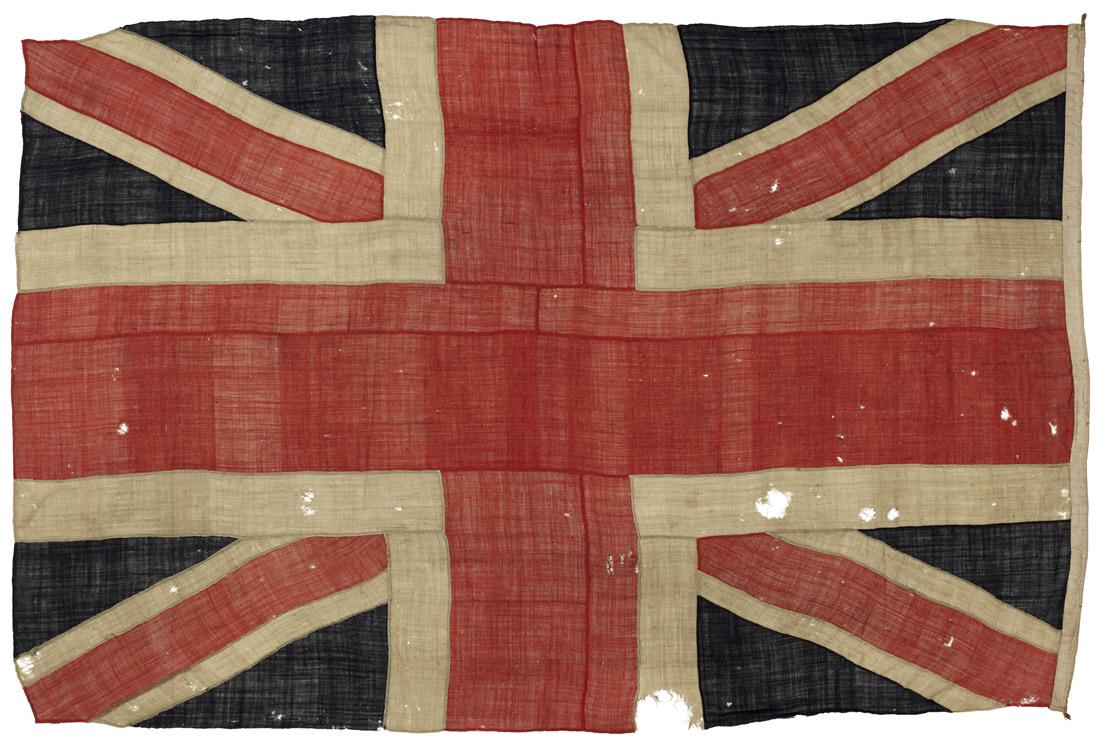
A TOOTH FROM THE LARGEST PREDATOR TO EVER ROAM THE EARTH
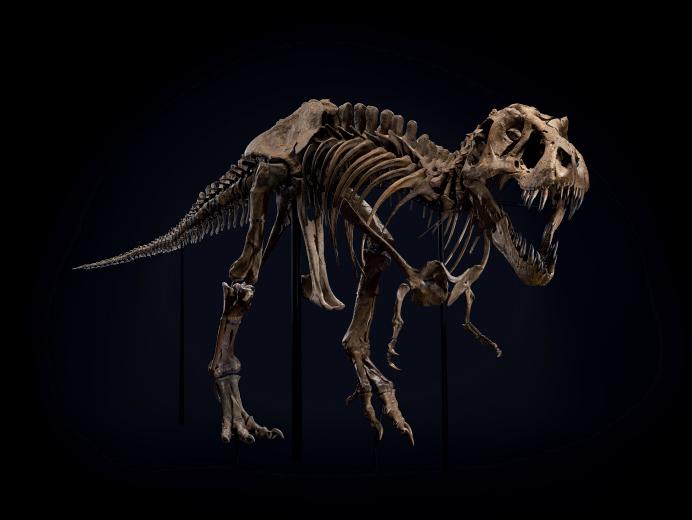
A FINE TYRANNOSAURUS REX TOOTH
SOUTH DAKOTA, USA
From the Hell Creek Formation, Harding County, late Cretaceous (circa 67-66 million years ago) the 4º-inch tooth of a Tyrannosaurus rex in a fine state of preservation, supported on custom fitted stand 4º in. (11 cm.) high; 1æ in. 4.6 cm.) wide; 1 in. (3.1 cm.) deep
£70,000-100,000
PROVENANCE:
Found on private land at the 3 X Ranch, Buffalo, Harding County, South Dakota, Subsequently with Triebold Paleontology, Inc, December 2021, Acquired from the above in January 2022.
US$95,000-130,000
€84,000-120,000
The most famous and iconic of all dinosaur species, the T. rex was first described by Henry Fairfield Osborn in 1905 from a skeleton found in 1902 in the Hell Creek Formation in Montana. Standing over 13ft tall and 40ft long, the T. rex was the top predator of the late Cretaceous, amongst the last dinosaurs to walk the earth before their mass extinction. T. rex possessed spikelike teeth not only larger but also more robust than those of any other theropod dinosaur. This adaptation made T. rex an unparalleled predator, capable of inflicting devastating damage with each powerful strike.
Tryannosaurus rex sold Christie’s New York, 6 October 2020, lot 59 ($31,847,500)
LEARN MORE

THE MOST BEAUTIFUL AMMONITE
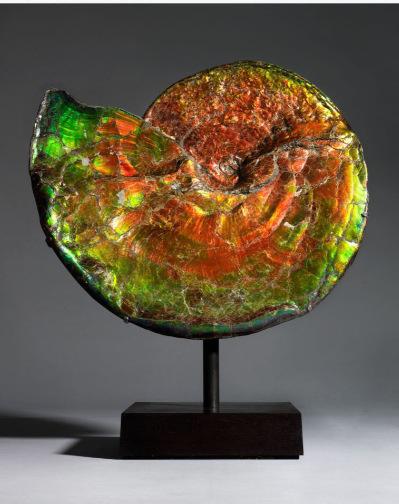
AN EXCEPTIONALLY VIBRANT IRIDESCENT AMMONITE CANADE
From the Upper Cretaceous, Bearpaw formation (75-72 million years ago), the exceptional 18 3/4-inch specimen of a single Placenticeras intercalare displaying a dazzling iridescence of reds and oranges, greens and rich blues, on custom stand
18æ in. (76.4 cm.) high; 15Ω in. (39.4 cm.) wide; 1æ in. (4.4 cm.) deep with stand: 21º in. (54 cm.) high
£100,000-150,000
US$140,000-200,000
€120,000-180,000
A magnificent example of one of the most spectacular fossils. The unique opal-like iridescence found only on ammonites from Alberta, Canada has been termed 'ammolite', and since 1981 has had the status of a gemstone. The shimmering, metallic colours were caused by the combination of millions of years of compression and the mineralization of iron, copper and silica which precipitated from volcanic ash. The opalescent layers of colour are particularly prized, and are rarely seen as vibrantly as on the current example, which unlike many specimens of its size is not composite but is a single shell wonderfully preserved.
A large ammonite sold; Christie’s, London, 28 October 2020, lot 56 (£260,000 hammer)
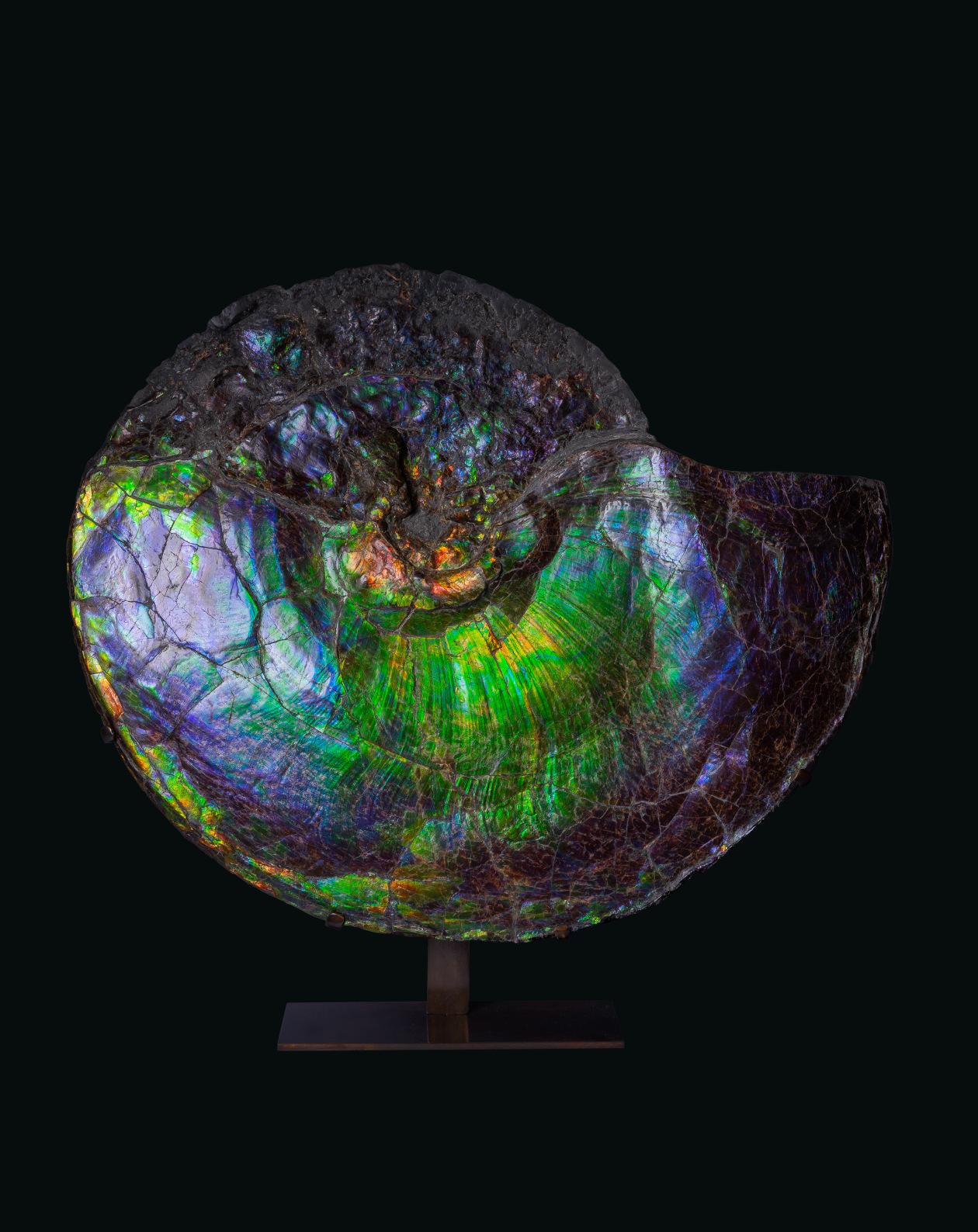
THE PORTUGUESE LANDING AT CALICUT
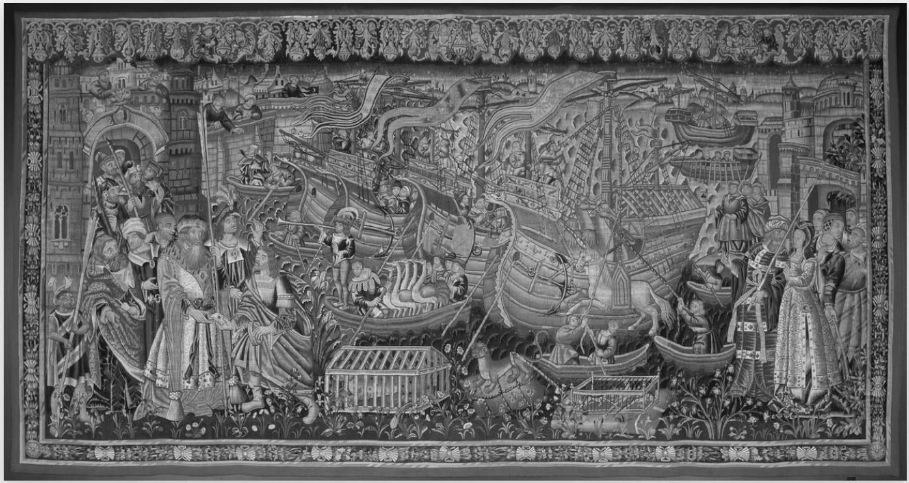
PROPERTY FROM AN IMPORTANT PRIVATE COLLECTION
A FLEMISH EXOTIC TAPESTRY FRAGMENT
CIRCA 1504-1522, PROBABLY TOURNAI
Depicting the Landing at Calicut from the Story of the Portuguese, depicting the disembarkment of a horse with dromedaries in a boat and figures to either side in fantastical buildings and attire, reduced in width and lacking borders on three sides, with later green guard borders, areas of reweaving 11 ft. 8½ in. (357 cm.) high, 8 ft. 6¾ in. (260 cm.)
£80,000-120,000
PROVENANCE: With French & Co.
Anonymous Sale; Christie's, New York, 20 April 2010, lot 100.
US$110,000-160,000
€96,000-140,000
This richly woven tapestry, forming the right section of a larger composition, depicts the dramatic landing at Calicut with royal figures and exotic animals—exemplary of early 16thcentury Europe's fascination with global exploration and the wonders of the New World. Part of a rare and enigmatic series variously known as The Story of Calicut, Portuguese or Indies, or Wild Men and Beasts, the present scene belongs to a celebrated tradition of Tournai weaving commissioned by powerful patrons eager to display their worldly knowledge and status. With only a handful of related examples surviving—such as those at the Museu do Caramulo, the Nationalmuseum in Stockholm, and the Banco Nacional Ultramarino in Lisbon—this work stands as a vivid and opulent relic of a period when tapestry served as both political theatre and decorative triumph.
A related extant tapestry of The Portuguese in India, Collection Caixa Geral de Depósitos, Lisbon.
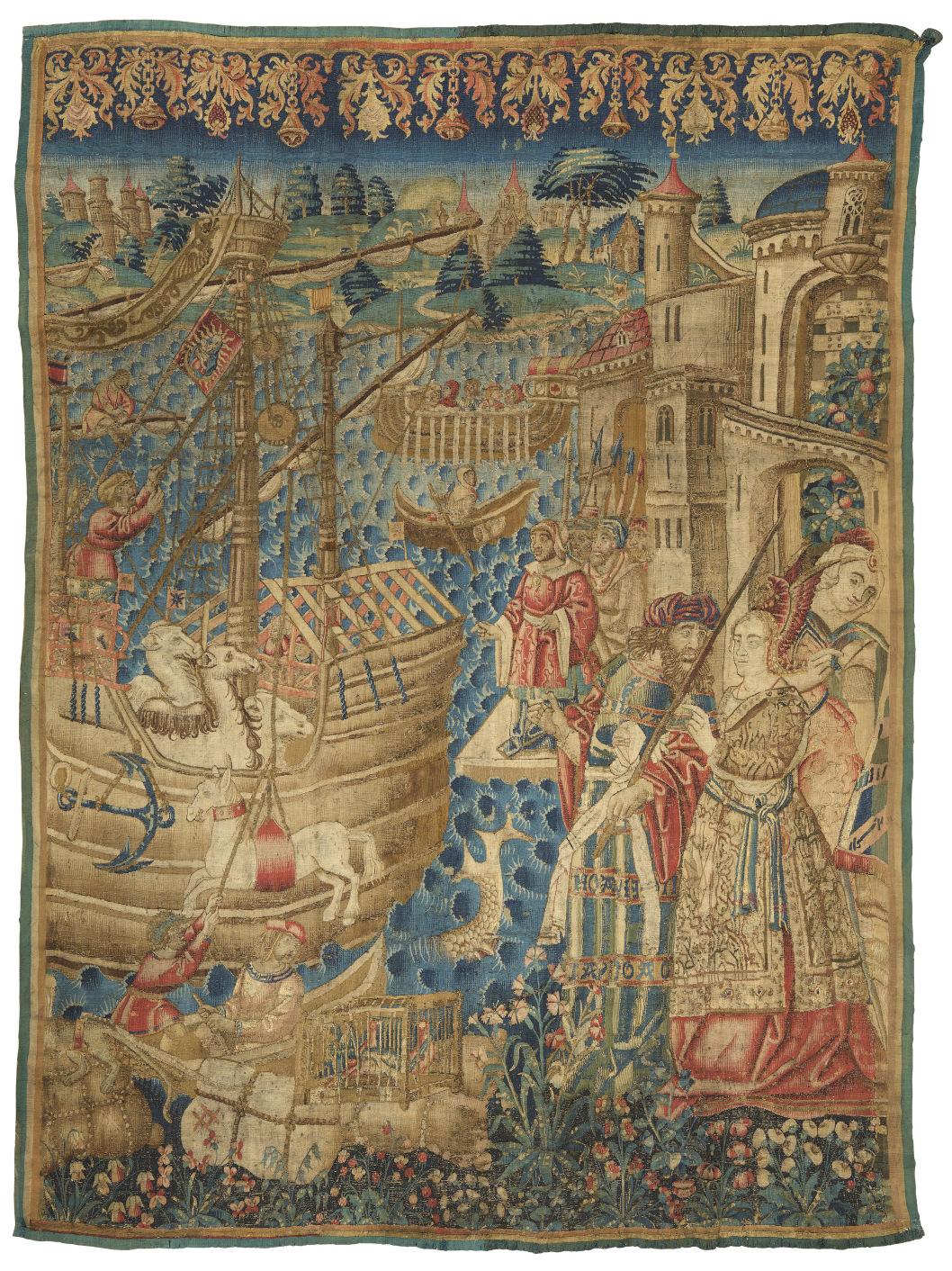
THE VAN WASSENAER WINE COOLER

Arent IX van Wassenaer, his wife Lady Anna Margaretha Bentinck (1683-1763) and their son Jacob Jan Brilanus (1703-1717)) © Kasteel Duivenvoorde
PROPERTY FROM A PRIVATE DUTCH COLLECTION (LOTS 1 & 29)
*29
A DUTCH SILVER WINE CISTERN
MARK OF ADAM LOOFS, THE HAGUE, 1704
Oval on raised gadrooned foot, the body chased on the lower part with fluting and applied in centre on each side with a large cartouche, one cast and chased with coat-of-arms and coronet above and the other engraved with an inscription, with two scroll hinged drop-ring handles cast and applied above with scrolls and shell terminal, the shaped upper rim applied with reeded band, marked on base; with later exhibition labels underneath and later copper lining 16Ω in. (42 cm.) long 162 oz. 5 dwt. (5,048 gr.)
The arms are those of the van Wassenaer for Arent van Wassenaer (1669-1721), Heer [Lord] van Voorschoten en Duvenvoorde and also Baron van Wassenaer. He married Lady Anna Margaretha Bentinck (1683-1763), daughter of Hans Willem Bentinck, 1st Earl of Portland, and Anne Villiers. The inscription in one of the cartouche reads 'Nobillissimo / Jacobo Joanni Brilano / Wassenariae Baroni / Illustris et generosi viri / Arnoldi Baronis de Wassenaer / Woorschotani Toparchae / filio primogenito / hoc honorarium cum infantem / Sacris undis tollerent / ex aere publico donarunt / S.P.Q. Britanus' which translates as "To the most noble Jacob Jan Brilanus, Baron of Wassenaer, eldest son of the illustrious and noble lord Arent, Baron of Wassenaer, Lord of Woorschoten, this customary gift was given from public funds by the Senate and People of Brielle when, as an infant, he was baptised."
£100,000-150,000
US$140,000-200,000
€120,000-180,000
PROVENANCE:
Arent van Wassenaer (1669-1721), Heer [Lord] van Voorschoten en Duvenvoorde and Baron van Wassenaer and his wife Lady Anna Margaretha Bentinck (1683-1763), Baroness van Wassenaer then by descent to, Jacoba Maria van Wassenaer (1709-1771) and her husband Frederik Willem Torck, seigneur de Heerjansdam, (1691-1761), then by descent to, Willem Frederik Torck, Baron van Pallandt (1892-1977), Rozendaal.
W. F. T. Pallandt; Christie's, Amsterdam, 23 October 1979, lot 3371.
A Dutch Private Collection.
EXHIBITED:
London, Victoria & Albert Museum, William & Mary and Their Time, 21 June to 20 August 1950, p. 64, no. 130, pl. XV.a.
The Hague, Haags Historisch Museum, Heren van Stand: 800 jaar Van Wassenaer, 16 November 2000 to 18 February 2001.
LITERATURE:
Oud Holland, H. E. Van Gelder, Werk van Haagse Zilversmeden, 1950, Vol. 65, p. 22, ill. 23.
N. Powell, 'The Age of William and Mary', The Listener, vol. XLIII, no. 1118, 29 June 1950, p. 1106.
J. Pijzel-Dommisse, Haags goud en zilver, Edelsmeedkunst uit de Hofstad, Gemeentemuseum, Den Haag, 2005, p. 40, ill. 31.
De Telegraaf, Amsterdam, 12 October 1979 'De wijnkoeler van de jonge baron'.
This wonderful wine cooler was rediscovered after 275 years when it was last sold at Christie’s Amsterdam in 1979. It had been kept, since it was made, in the van Wassenaer family passing down by descendance. Made for the christening of the son of Arent van Wassenear, a Dutch nobleman and diplomat to William of Orange, it counts as one of Adam Loofs's, silversmith and keeper of the King’s plate and probably one of the most important Anglo-Dutch goldsmiths, masterpieces.
LEARN MORE
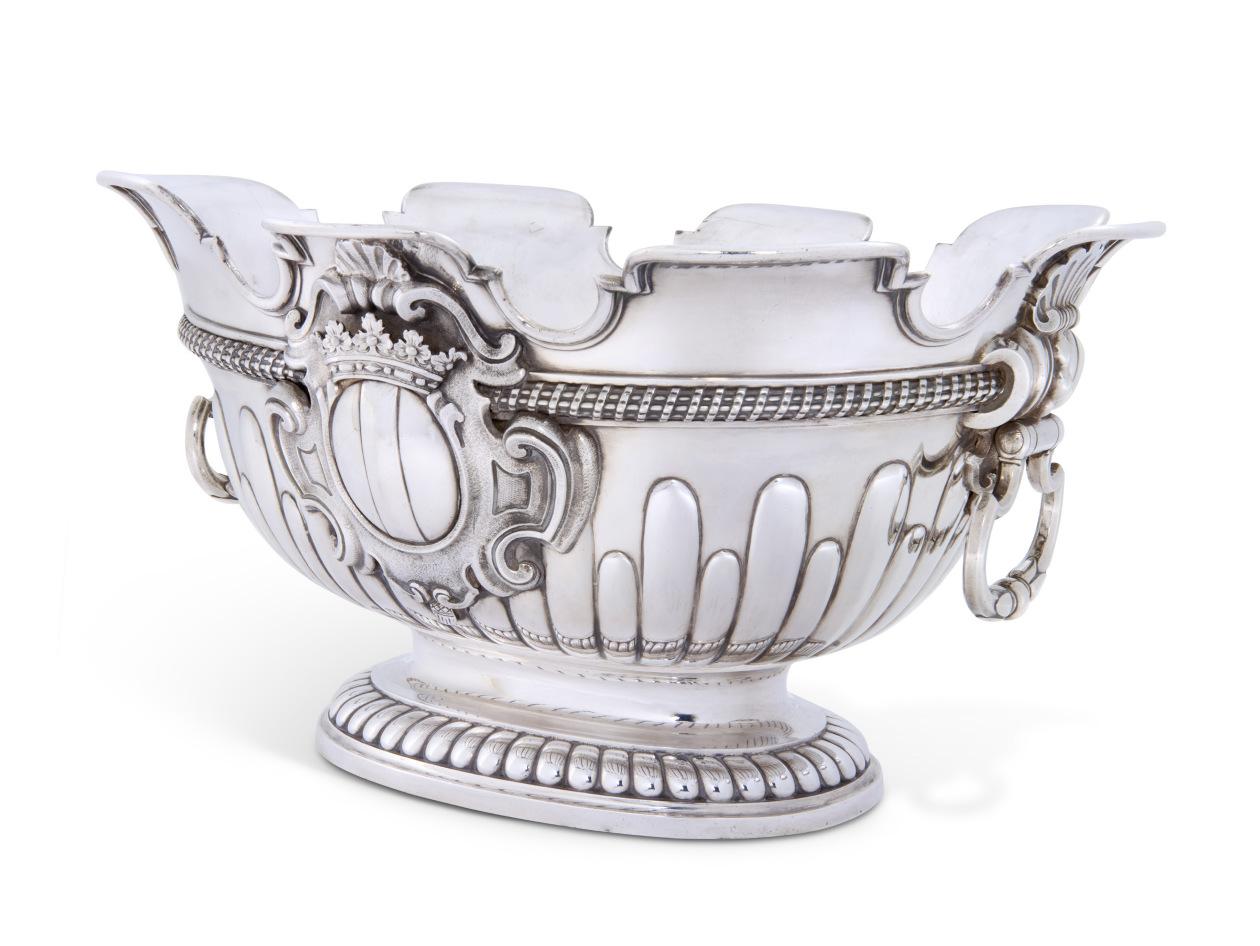
A RARE SURVIVAL OF TECHNICAL PROWESS
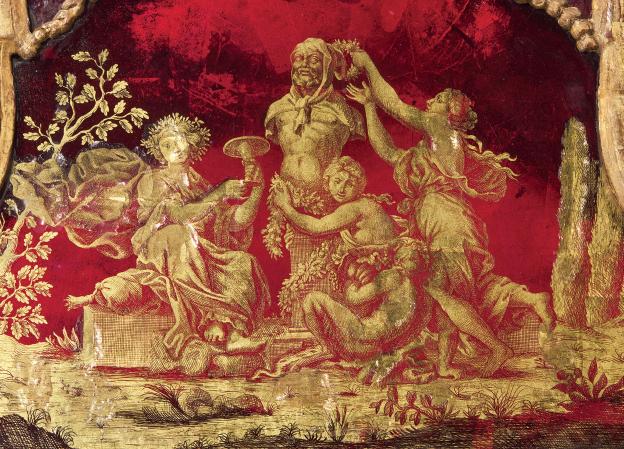
PROPERTY OF A GENTLEMAN
A LOUIS XIV GILTWOOD VERRE EGLOMISE MIRROR EARLY 18TH CENTURY
The moulded frame with sculpted giltwood, decorated with red tinted eglomisé glass, with interlacing patterns, scrolls, and animated scenes in the style of Bérain, the pediment centered by three crowned women and topped with a mask of Apollo, flanked by foliate clasps; the mirror plate with a crack, the frame with associated corner pieces
69Ω in. (176 cm.) high; 38æ in. (8.5 cm.) wide
£300,000-400,000
PROVENANCE:
Acquired from the Jansen firm around 1950, thence by descent until sold,
US$410,000-540,000
€360,000-470,000
The Exceptional Sale; Christie's, Paris, 21 November 2021, lot 210 (€450,000 including premium).
This verre églomisé mirror typifies the refined artistry that defined the technique of reversepainted and gilded glass in early 18th century France. Richly carved and engraved with grotesque and arabesque decorative motifs derived from the oeuvre of the ornémaniste Jean Bérain, the mirror is a rare survivor of a highly technical and costly production.
LEARN MORE
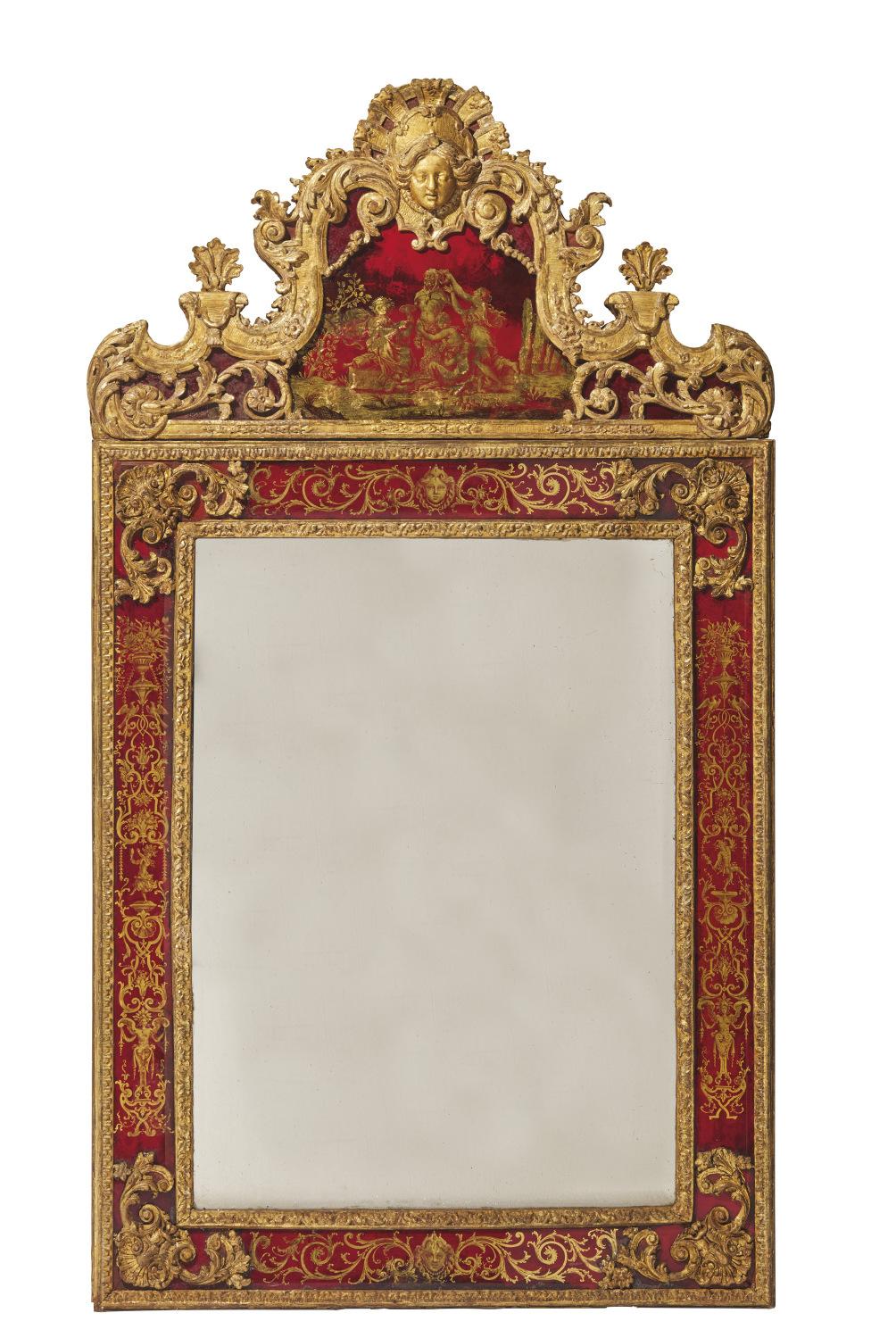
POLYCHROME ARABESQUES
PROPERTY FROM A PRIVATE COLLECTION
A LOUIS XIV ORMOLU-MOUNTED BRASS, TORTOISESHELL, IVORY, MOTHER-OF-PEARL INLAID AND POLYCHROME-DECORATED STAINED HORN MARQUETRY COMMODE
ATTRIBUTED TO NICOLAS SAGEOT, CIRCA 1710, STAMPED I. DUBOIS, PROBABLY RESTORED BY JACQUES OR RENE DUBOIS, THIRD QUARTER 18TH CENTURY
In contre-partie, the rectangular top with rounded front angles, and engraved moulding inlaid with foliate scrolls and centred by a roundel depicting figures hunting rabbits in a landscape flanked by further Bérainesque motifs, scrolls and figures, the angles fitted with floral bouquets, above two short drawers and two long drawers conformingly inlaid with foliate scrolls
33 in. (84 cm.) high; 51Ω in. (131 cm.) wide; 26Ω in. (67.5 cm.) deep
£120,000-180,000
PROVENANCE:
With Partridge Fine Art, London.
Anonymous sale; Sotheby's London, 8 July 2015, lot 14.
US$170,000-240,000
€150,000-210,000
This sumptuous and colourful commode is attributed to the ébéniste Nicolas Sageot, a contemporary of ébéniste-du-Roi, André Charles Boulle. Sageot is celebrated for his excellence in a highly original polychrome variant of the 'Boulle' technique, with coloured and stained horn inlaid in brass and tortoiseshell surfaces. This splendid example also bears the stamp 'I DUBOIS', reflecting the enduring appeal of Boulle marquetry pieces throughout the 18th century; the Dubois workshop specialised in the restoration of Boulle marquetry and his stamp is recorded on a number of Boulle pieces in British collections.
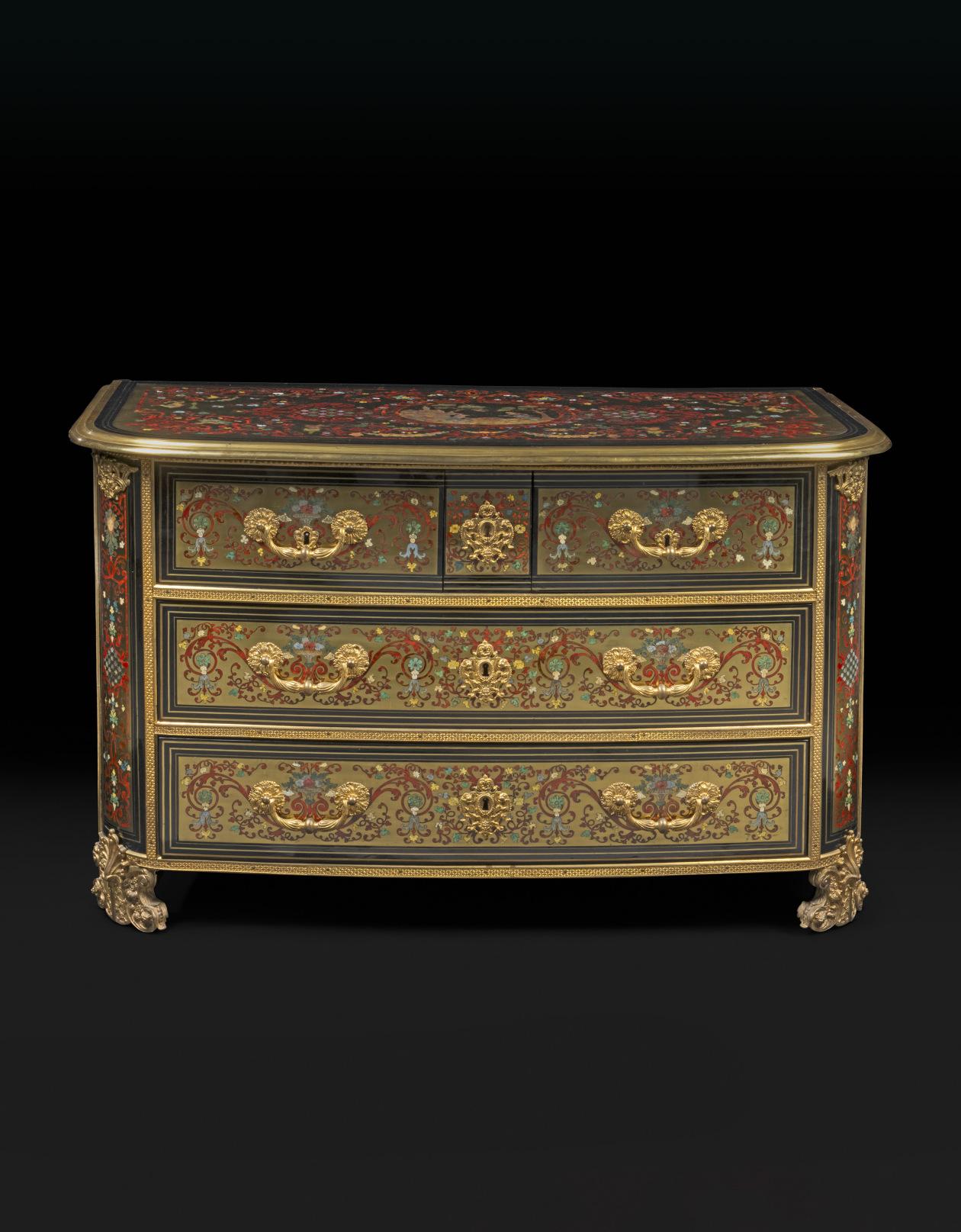
A ROTHSCHILD BOÎTE À MINIATURES
*32
A LOUIS XV TWO-COLOUR GOLD-MOUNTED BOÎTE À MINIATURES
BY PIERRE-FRANCOIS DRAIS, PARIS, 1768
Rectangular with cut corners, the lid, sides and base set with gouache subjects on vellum within gold cagework chased with alternating acanthus and stylised ovolo, marked in cover, base and side with charge and décharge marks of Julien Alaterre, date letter (E) maker's mark; on flange with contremarque for 1774-1780, décharge des ouvrages vieux for 1780-1782, décharge des petits ouvrages d'or et d'argent for 1782-1789, contremarque 1789-1792; and later French control mark; with Rothschild collection label RG 41 / X. 52. in cover
2Ω in. (6.4 cm.) long gross weight 3 oz. 6 dwt. (104 gr.)
£40,000-60,000
PROVENANCE:
US$55,000-81,000
€48,000-71,000
Baron Gustave de Rothschild (1829-1911), Paris, then by descent to Baron Robert de Rothschild (1880-1946), Paris, then by descent to Baron Elie de Rothschild (1917-2007), Paris.
Anonymous sale; Sotheby’s Monte Carlo, 25 June 1976, lot 494. Auction Art Rémy Lefur et Associés, Paris, 2 December 2022, lot 17.
Boîtes à miniatures were one of the Rothschild family's favourite type of boxes as seen at Waddesdon Manor as well as in other public institutions such as the Louvre Museum in Paris. The boîte à miniatures was introduced in Paris around 1740 and proved to be the perfect platform to display views of one’s castle, memorable battles, courtly events or simply fêtes galantes or champêtres. These miniatures were also the perfect support to display a "reproduction" of fashionable paintings such as those of François Boucher or JeanAntoine Watteau. Pierre-Francois Drais, a pupil and proud successor of the well known gold box maker Jean Ducrollay, excelled in the production of these cagework boxes, many of which were made on commission for rich patrons.

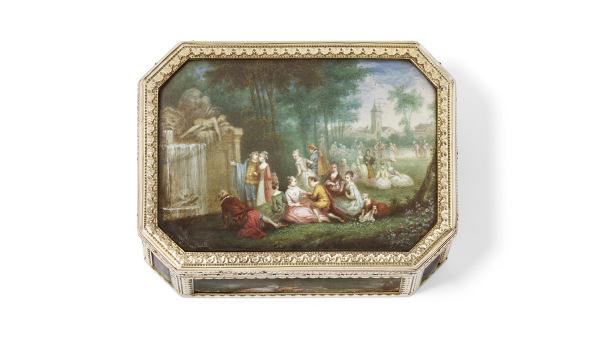

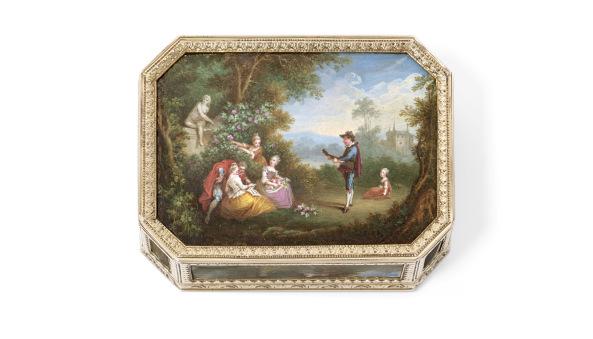

LEARN MORE
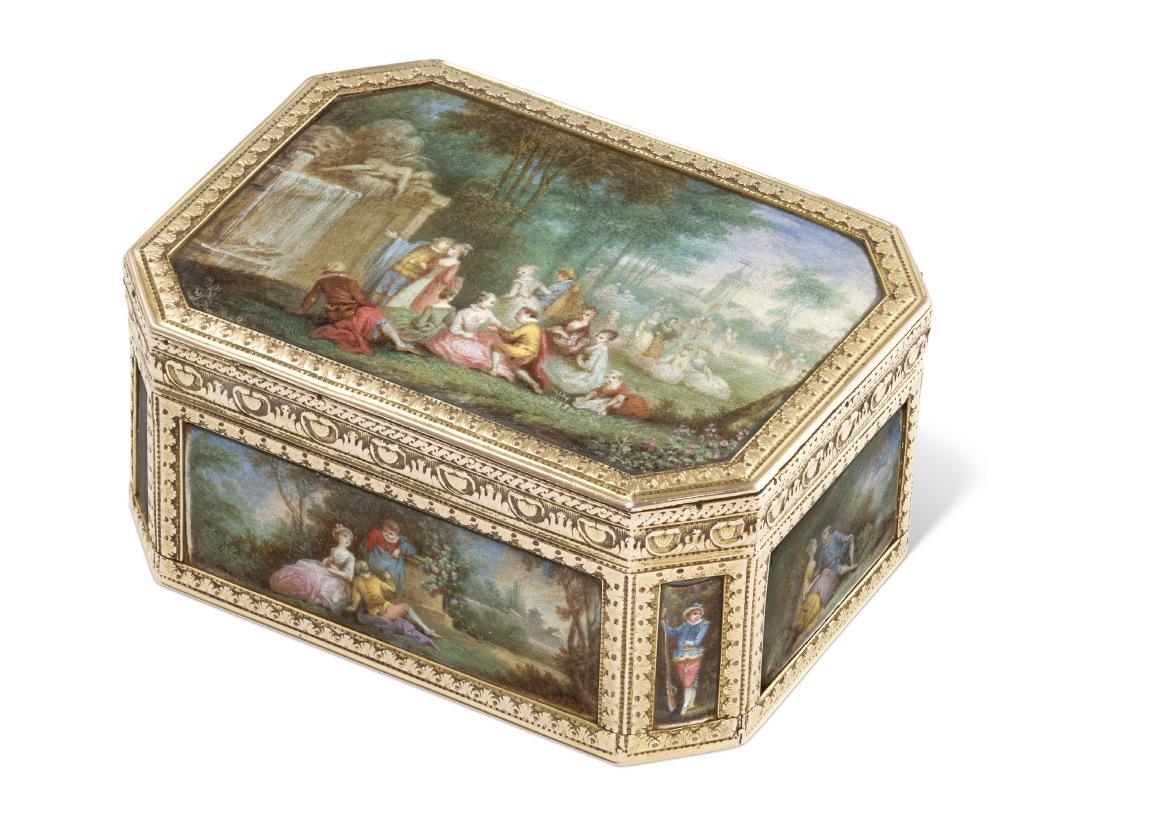
A HOROLOGICAL MASTERPIECE BY ROBERT ROBIN AND JOSEPH COTEAU
PROPERTY FROM A DISTINGUISHED PRIVATE COLLECTION (LOTS 10 & 33)
*33
A LOUIS XVI ORMOLU MONTH-GOING MEAN AND SOLAR TIME MANTEL REGULATOR WITH REMONTOIRE
THE CLOCKMAKER ROBERT ROBIN, PARIS, THE ENAMELLER JOSEPH COTEAU, THE DIAL DATED 1778
The glazed CASE with acanthus leaf and beaded border to the top, laurel leaf and berry mouldings to the borders on side panels and front and rear doors, on block feet, the DIAL with beaded border to the convex glass and drapery swag below, the white enamel with Roman hours and Arabic five minute markers, outer concentric year calendar indicating months and days bordered by the corresponding polychrome zodiac symbols painted in oval gilt-framed ovals linked by floral painted garlands, signed to the centre 'Robin / A PARIS' and to the lower edge 'Coteau ft...', further signed to the reverse 'Coteau / le l. Juillet 1778', pierced and engraved ormolu fleur-de-lis hour hand, pierced and engraved solar minute hand with lyre and sun, blued steel hand for mean time with star counter-balance, pierced blued steel calendar hand and blued steel centre seconds, the concealed dial plate with winding squares, inscribed to the lower edge 'Remontez à gauche / Celui de Droit' and with lever inscribed 'faites passer le quantieme’ to the right hand corner, the MOVEMENT with twin interconnecting going barrels driving re-wind system for weight-driven one minute remontoire mounted on the back plate, Graham-type dead beat escapement with fine beat adjustment to the crutch, pivoted knife edge suspension bracket secured to the rear of the case for the nine rod brass and blued steel gridiron pendulum, pendulum locking wheel to underside of case, the pendulum bob inset with enamel plaque painted after Boucher with a young lady on a swing, signed on reverse 'Coteau ...778', equation of time kidney and calendar work mounted to the front plate under the dial; two brass weights
16º in. (41 cm.) high; 8√ in. (22.5 cm.) wide; 6√ in. (17.5 cm.) deep
£100,000-150,000
PROVENANCE:
Time Museum inventory no. 3463.
US$140,000-200,000
€120,000-180,000
Masterpieces from the Time Museum; Sotheby's, New York, 2 December 1999, lot 63.
Property of a Gentleman; Christie's, London, 8 July 2010, lot 72.
LITERATURE:
David S.Landes, L’Heure qu’il est :Les horloges, la Mesure du temps et la formation du monde moderne, Paris, 1987.
Derek Roberts, Precision Pendulum Clocks, France, Germany, America and Recent Advancements, Pennsylvania 2004, pp. 32-33, figs. 26 A-C.
This masterpiece clock by the French Royal clockmaker Robert Robin (1741-1799) dated 1778, when perhaps at the zenith of his remarkable horological career, also coincides with the approval of two of his inventions by the Académie des Sciences. The movement, with Graham-type escapement, has complications including his constant force remontoire together with a remarkable dial by the preeminent maître-peintre-émailleur Joseph Coteau (1740-1801) featuring equation of time indication and year calendar with accompanying zodiacal symbols to the dial. A possibly unique feature is the pendulum bob, also painted by Coteau, featuring a woman on a swing in the manner of François Boucher (1703-1770).

Detail of Joseph Coteau signature and date
LEARN MORE
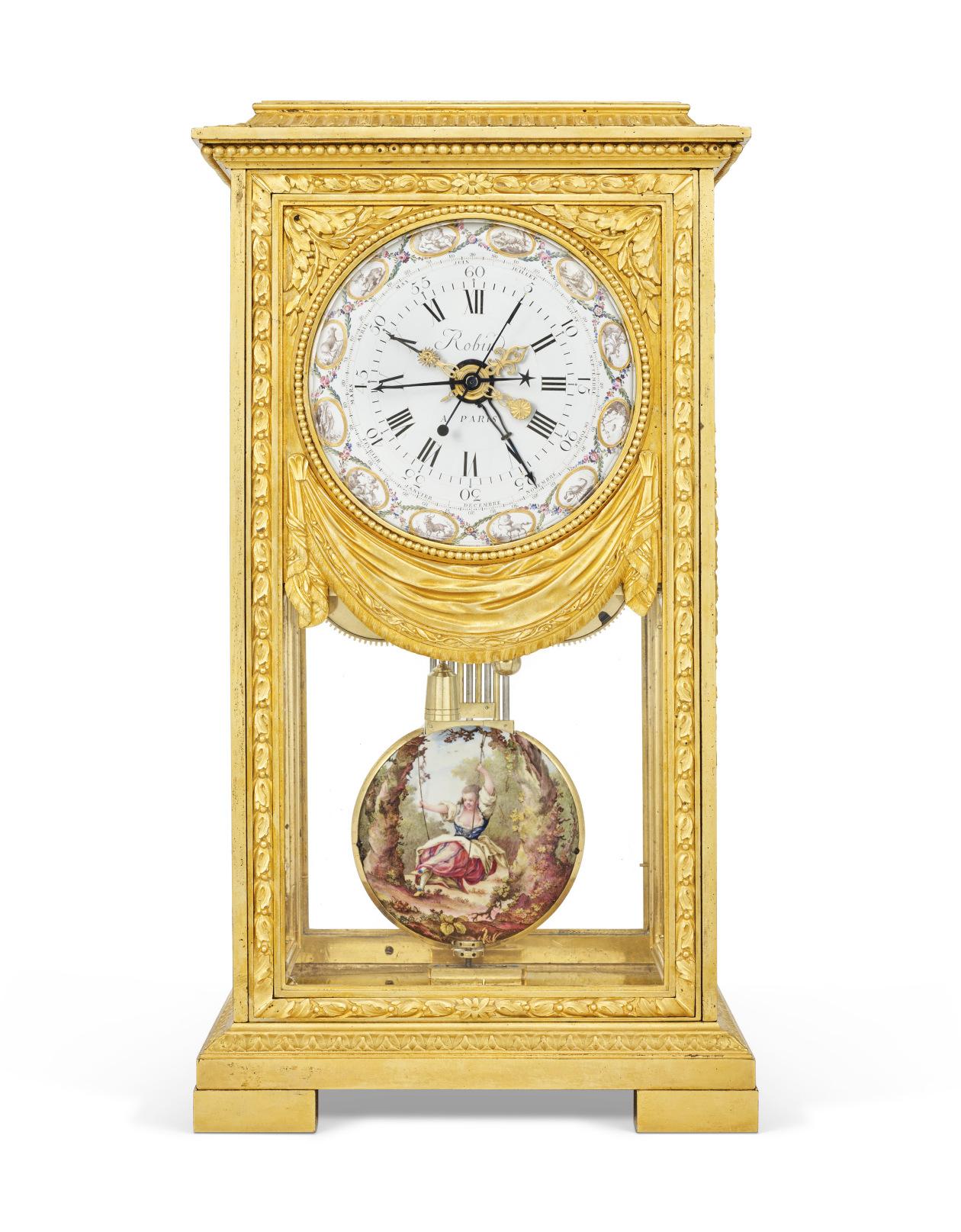
A CENTREPIECE FOR MADAME DE POMPADOUR
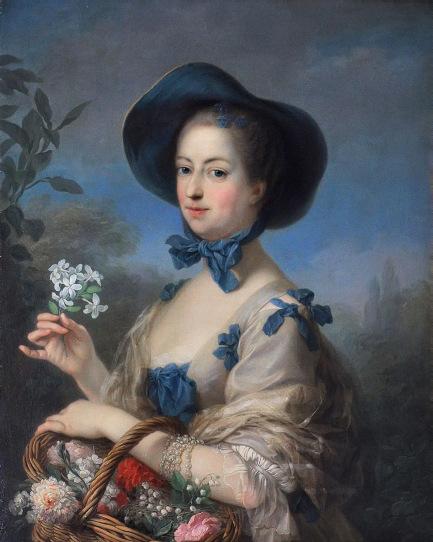
PROPERTY FROM AN IMPORTANT PRIVATE COLLECTION
■34
A LOUIS XV ORMOLU-MOUNTED MEISSEN AND VINCENNES PORCELAIN CENTREPIECE
CIRCA 1745-49, THE PORCELAIN MID-18TH CENTURY
The pierced rockwork and rocaille-moulded ormolu base mounted with seven Meissen putti, emblematic of the Arts and Sciences, below a pierced circular Meissen basket issuing gilt-metal leafy branches mounted with porcelain garden flowers forming an arrangement; the ormolu base struck with the 'C' Couronné Poinçon, a few flowers possibly replaced in the 19th century
21 ¾ in. (52.7 cm.) high, overall
£80,000-120,000
PROVENANCE:
US$110,000-160,000
€95,000-140,000
Almost certainly Jeanne Antoinette Poisson, Marquise de Pompadour (1721-1764) at the Hôtel Pompadour, Paris, where listed in the 1764 inventory in a first-floor cupboard for safe keeping. Italian collection; sold Christie's, London, 23 May 2018, lot 210.
LITERATURE:
J. Cordey, Inventaire des Biens de Madame de Pompadour, Paris, 1939, p. 46, no. 481, where listed: R. Savill, Everyday Rococo: Madame de Pompadour & Sèvres Porcelain, Unicorn Publishing Group, 2021, vol. 1; fig. 6.3.
This extraordinary centrepiece with flowers and figures of Vincennes and Meissen porcelain and a Parisian ormolu base is characteristic of the ingenious creations of the marchands-merciers under the patronage of Madame de Pompadour. Depicting the arts and sciences beneath a basket of naturalistic flowers, recent academic research has discovered that the centrepiece is almost certainly that listed in Madame de Pompadour’s posthumous 1764 inventory of her residence in Paris, the Hôtel Pompadour known today as the Palais de Élysée:
'Une corbeille formant un bouquet, garni des mêmes fleurs [de Vincennes], et entouré de sept enfants, de Saxe, sur une terrasse de bronze d'oré'.
Charles André Van Loo, The Marquise de Pompadour in a garden, circa 1755, Versailles (MV 8616)
LEARN MORE
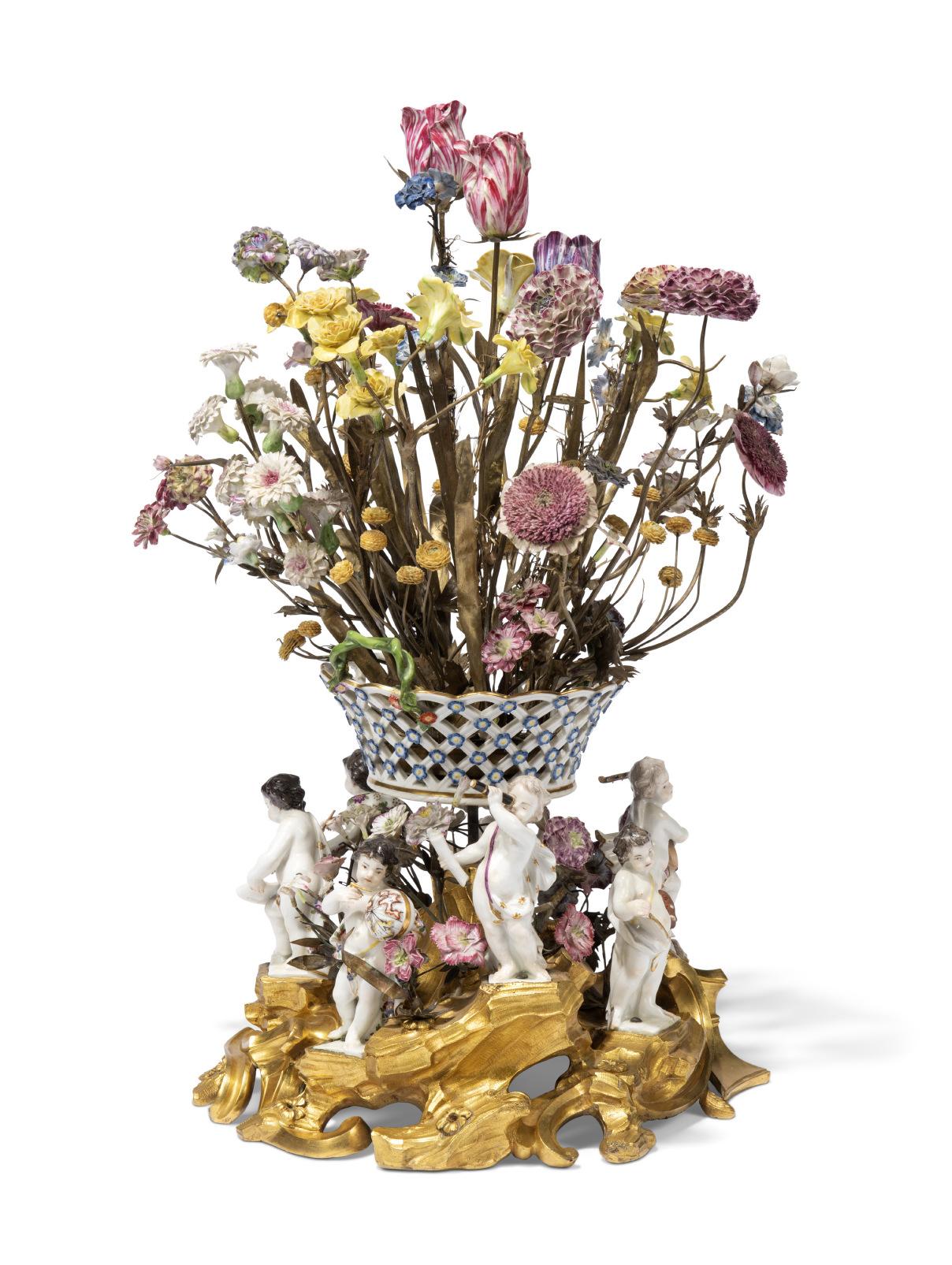
A GOLDEN AGE - JAPANESE LACQUER A LA GRECQUE
THE PROPERTY OF A GENTLEMAN
■*35
A PAIR OF LOUIS XVI ORMOLU-MOUNTED EBONY AND JAPANESE LACQUER SIDE CABINETS
CIRCA 1785, POSSIBLY BY ETIENNE LEVASSEUR
Each with canted rectangular inset red-marble top, the beaded rim with egg-and-dart moulding above two panelled doors each with early 18th Century Japanese lacquer panel decorated in iroe hiramakie and takamakie with a hawk on a perch within a border of stiff leaves, the interior formerly with shelves, between fluted canted angles, the panelled sides each inset with a late 17th/early 18th Century Japanese lacquer panel decorated with a vase of flowers in gold and black hiramakie on a roironuri ground, on canted rectangular plinth cast with stiff leaves, and toupie feet with acanthus scrolled mounts and ball feet, with repair to marbles, one inscribed N°2 42Ω in. (108 cm.) wide; 39æ in. (101 cm.) high; 19æ in. (50c m.) deep, each (2)
£300,000-500,000
PROVENANCE:
US$410,000-680,000
€360,000-590,000
Madame Edward Esmond, née Valentine Deutsch de la Meurthe (1884-1969); Sybil Billotte, née Esmond (1908-1984), by descent from the above; General Pierre Billotte (1906-1992), by descent from the above and from whom acquired by the present owner as payment for services rendered in the late 1980s.
EXHIBITED:
Oliver Impey, Christiaan Jörg, “Japanese Export Lacquer 1580-1850”, 2005, Amsterdam, p. 298, fig. 588.
These cabinets, designed in bold neoclassical style with brass-fluted corners, are distinguished by their rare Japanese lacquer panels depicting hawks tethered to their perches—an evocative reference to the elite sport of takagari, practiced by Japan’s military class from the 14th century. Such imagery underscores the deep cultural symbolism and artistry of Japanese lacquer, here reimagined within the refined tradition of 18th-century French cabinetmaking. Likely the work of leading ébénistes such as Levasseur, and linked to prominent marchands merciers like Claude-François Julliot, these cabinets epitomise the luxurious cross-cultural aesthetic prized by Europe's most discerning collectors.
LEARN MORE
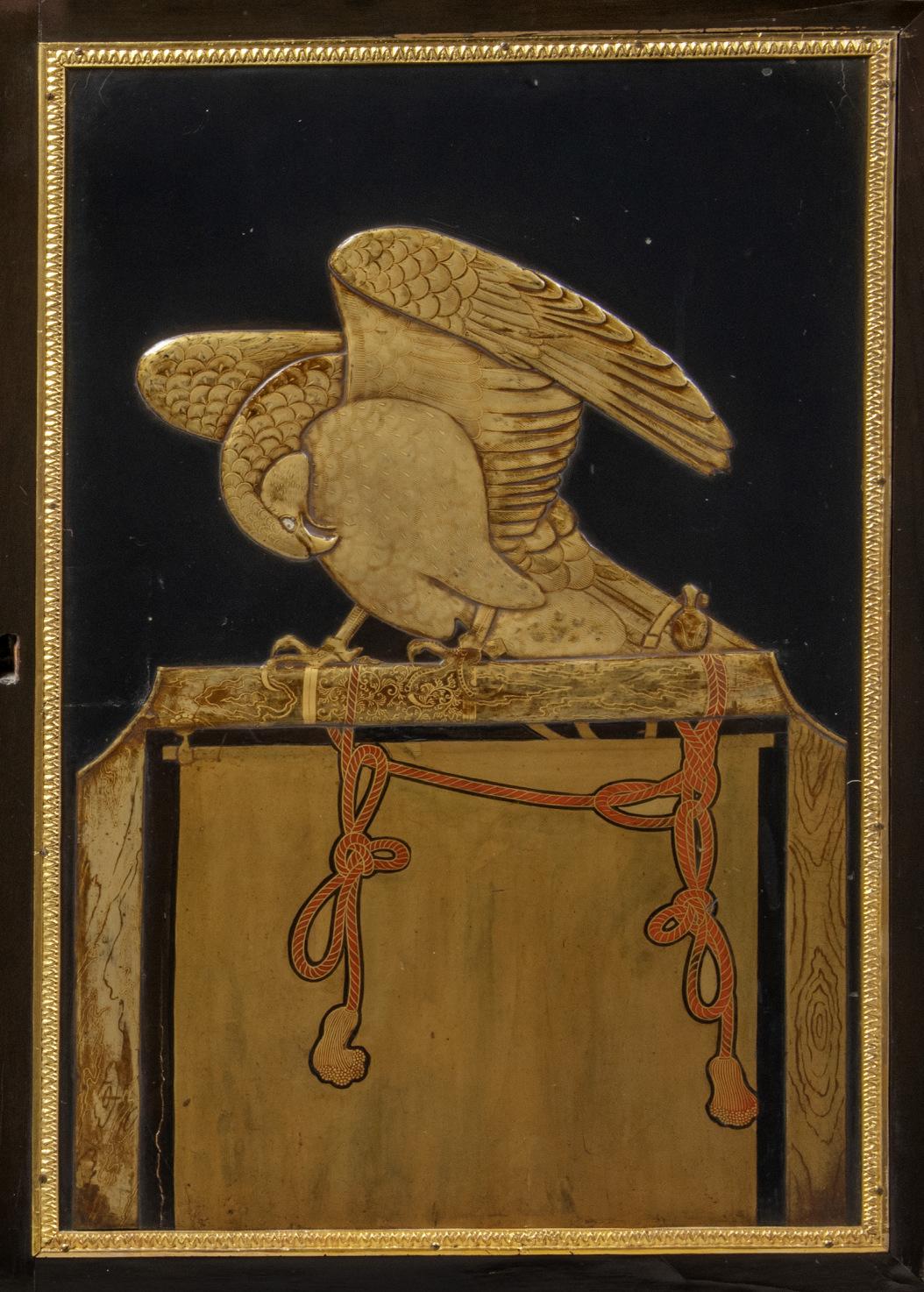

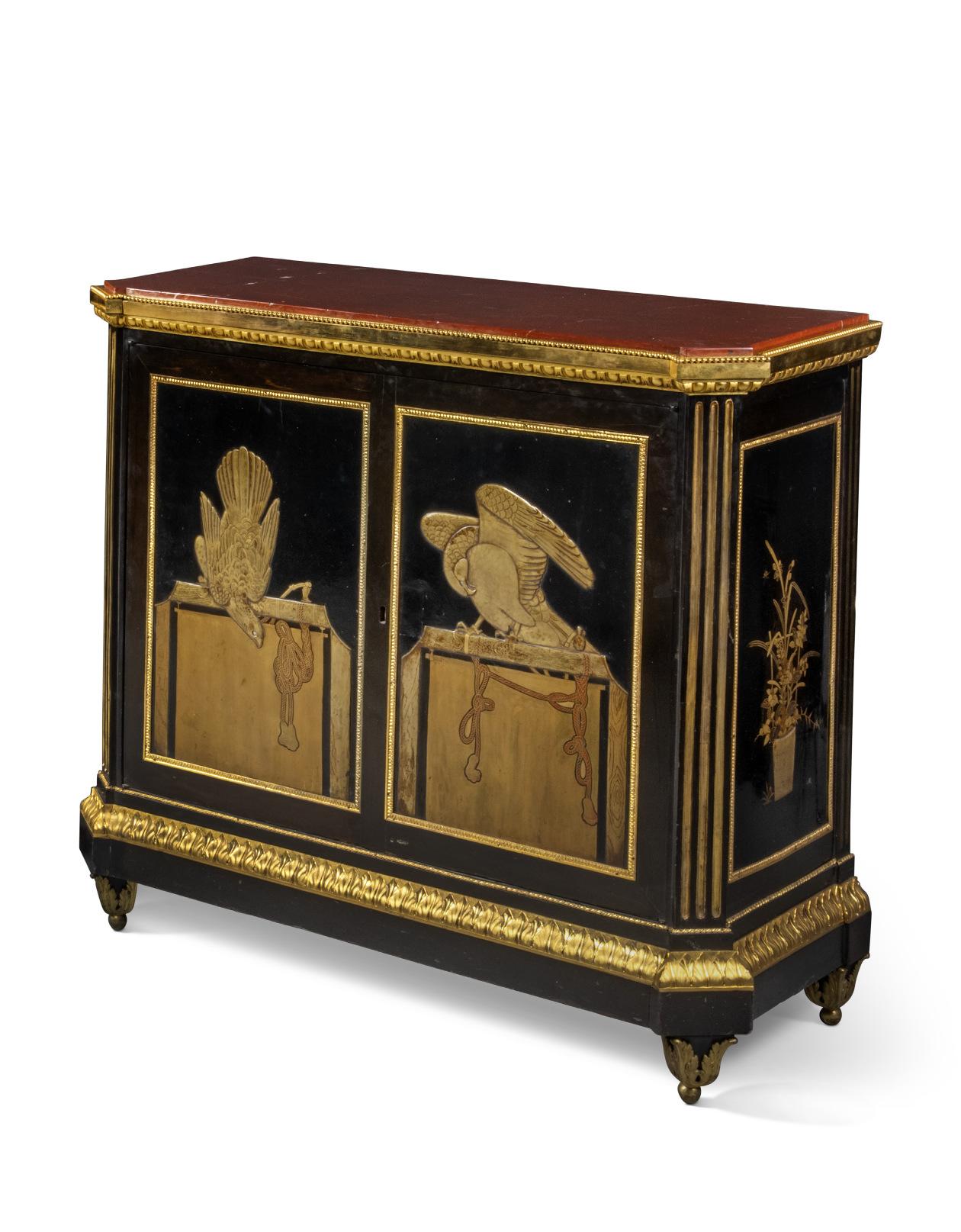
EXOTIC DELIGHTSCHINOISERIE PORCELAIN FROM THE MEISSEN FACTORY

PROPERTY OF A GENTLEMAN 36
LEARN MORE
A GARNITURE OF FIVE MEISSEN PORCELAIN HEXAGONAL VASES AND COVERS
THE PORCELAIN CIRCA 1725-28, THE DECORATION CIRCA 1740, BLUE CADUCEUS MARKS TO THE BALUSTER VASES, BLUE CROSSED SWORDS MARKS TO THE BEAKER VASES, THE COVER OF THE CENTRAL VASE A LATER REPLACEMENT
Comprising: a central baluster vase and a slightly smaller flanking pair, and two flared beaker vases, each painted in the manner of J.G. Höroldt with a continuous scene of chinoiserie figures, animals and beasts at various pursuits, the scenes to the baluster vases on puce scroll supports, the domed covers similarly decorated and with flattened knop finials enriched in gilding, the flared beaker vases with a bulbous section to the lower body painted with further chinoiserie figures in purpurmalerei
The central vase 14¡ in. (37.5 cm.) high
£80,000-120,000
PROVENANCE:
US$110,000-160,000
€95,000-140,000
Anonymous sale; Sotheby's, London, 29 May 1956, lot 153 (the central vase; sold without a cover). Anonymous sale; Christie's, London, 10 February 2022, lot 55, Where acquired by the current owner (£137,500 including premium).
Likely produced in the 1720s and decorated in the 1740s, these vases represent the final phase of the iconic Meissen factory's chinoiserie style, as established by Johann Gregorius Höroldt. The vases, adorned with intricate scenes including a figure riding an elephant, are thought to be inspired by Höroldt's sketches from the Schulz Codex. Comparable garnitures are found in prominent collections, including the J. Paul Getty Museum and the National Museum of American History.
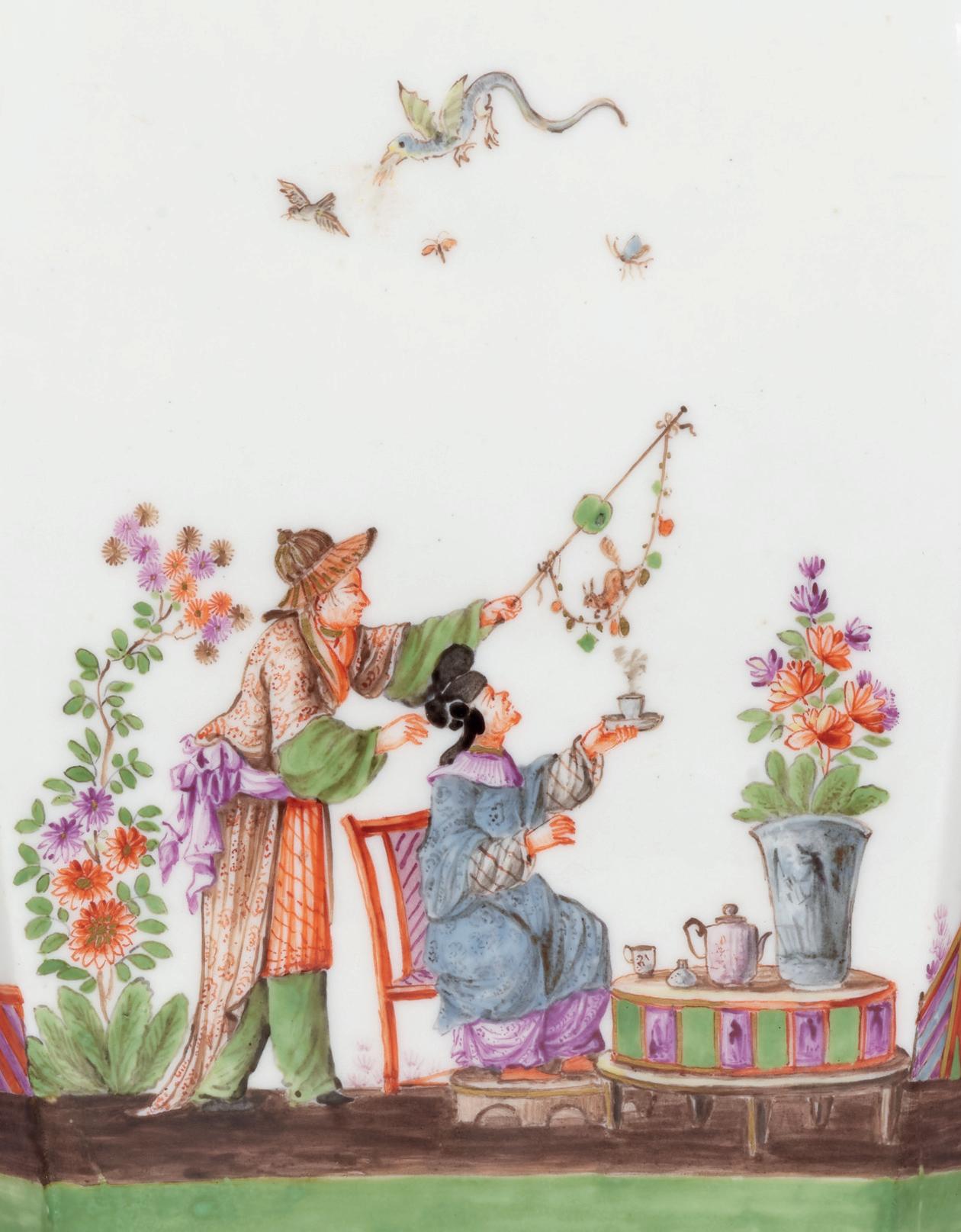
EDO STANDING IN FRANCE
PROPERY FROM A DUTCH COLLECTION
■37
A PAIR OF REGENCE GILT-METAL-MOUNTED BLACK AND GILT JAPANESE LACQUER CABINET-ON-STANDS
CIRCA 1720,
THE LACQUER LATE 17TH CENTURY, EDO PERIOD
Each with chased and gilt clasps, hinges and escutcheons, the cupboard doors decorated with scenes of villages and pagodas, opening to reveal ten drawers with decorated with landscapes, the sides with flower bouquet motifs, the edges in aventurine, on a moulded base, the pierced frieze centered by a shell and flowering branches and foliage, the uprights applied with large shells and twisted motifs ending in large acanthus leaves and hooves joined by an X-shaped stretcher centered by a sunflower and scrolls, one bearing a printed label numbered ‘74216’, a small one ‘Box 30’ label, another ‘1731’ and a label inscribed in pencil ‘Lot A / Von Goldschmidt’, the second one with a printed label numbered ‘74217’, two ‘Box 30’ labels and a label inscribed in pencil ‘Lot A / Von Goldschmidt’ Cabinets: 26Ω in. (67 cm.) high; 30 in. (76 cm.) wide; 20 in. (51 cm.) deeHeight with base: 55æ in. (141.5 cm.) high; 33Ω in. (85 cm.) wide; 23Ω in. (60 cm.) deep (2)
£200,000-300,000
PROVENANCE:
Von Goldschmidt (according to label).
Galerie de Lacques at the Paris Biennale, 1988, Paris, where acquired by Mrs Sabine M.C.M. Dreesmann (1952-2005), Wassenaar, thence by descent.
US$280,000-410,000
€240,000-350,000
This pair of Japanese lacquer cabinets-on-stand exemplify the luxury goods imported into Europe during the 17th century by the Dutch East India Company. Coveted for its refined decoration and polished surfaces, lacquer works of art were prized by monarchs and cultural elites across Europe who often paired them with contemporary stands executed in the latest taste. Importing a pair of pendant lacquer cabinets indicates a commission of some significance and with their original stands reflecting the advent of the rococo style and beautifully preserved lacquer panels, this pair of cabinets is a rare survival.
LEARN MORE

AT THE ALTAR OF HEPHAESTUSAN AGATE CHIMNEYPIECE
A GEORGE III STATUARY AND SIENA MARBLE AND AGATE CHIMNEYPIECE
CIRCA 1760-1770
The rectangular moulded shelf above a tablet carved with sheep before a farm flanked by tablets of agate, above a rectangular aperture veneered in agate, the sides with tapering uprights inlaid with simulated Siena flutes, on a plinth base, the rear of the shelf cut for an overmantel mirror, minor restorations and replacements, together with a George III-style polished steel and cast-iron fire grate 63Ω in. (161.5 cm.) high; 75Ω in. (191.5 cm.) wide; 8Ω in. (21.5 cm.) deep
Aperture: 46æ in. (119 cm.) high; 48 in. (122 cm.) wide (2)
£70,000-100,000
PROVENANCE:
Anonymous sale; Christie's, London, 7 June 2007, lot 160 (£412,000 with premium), Acquired from the above by the present owner.
US$95,000-140,000
€83,000-120,000
This striking chimneypiece, with its cloudy tablets and striated bands of fiery agate, relates to the work of the Hyde Park sculptor Henry Cheere (d. 1781), who boasted in 1752 of a 'Sienna and Statuary' chimneypiece as being 'extremely fine'. This tablet's quality of sculpting 'à jour' typifies the naturalistic pastoral scenes of 'Shepherd and Shepherdesses seated on bank surrounded by their flocks' that were exhibited at the Society of Arts from 1760 by the sculptor William Collins, who was still remembered in the 1820s as having been 'the most famous modeller of chimney tablets of his day'. One of Collins' related tablets, mounted onto a giallo marble ground, can be found in the collections of the Victoria & Albert Museum, London (AN 1152-1882).
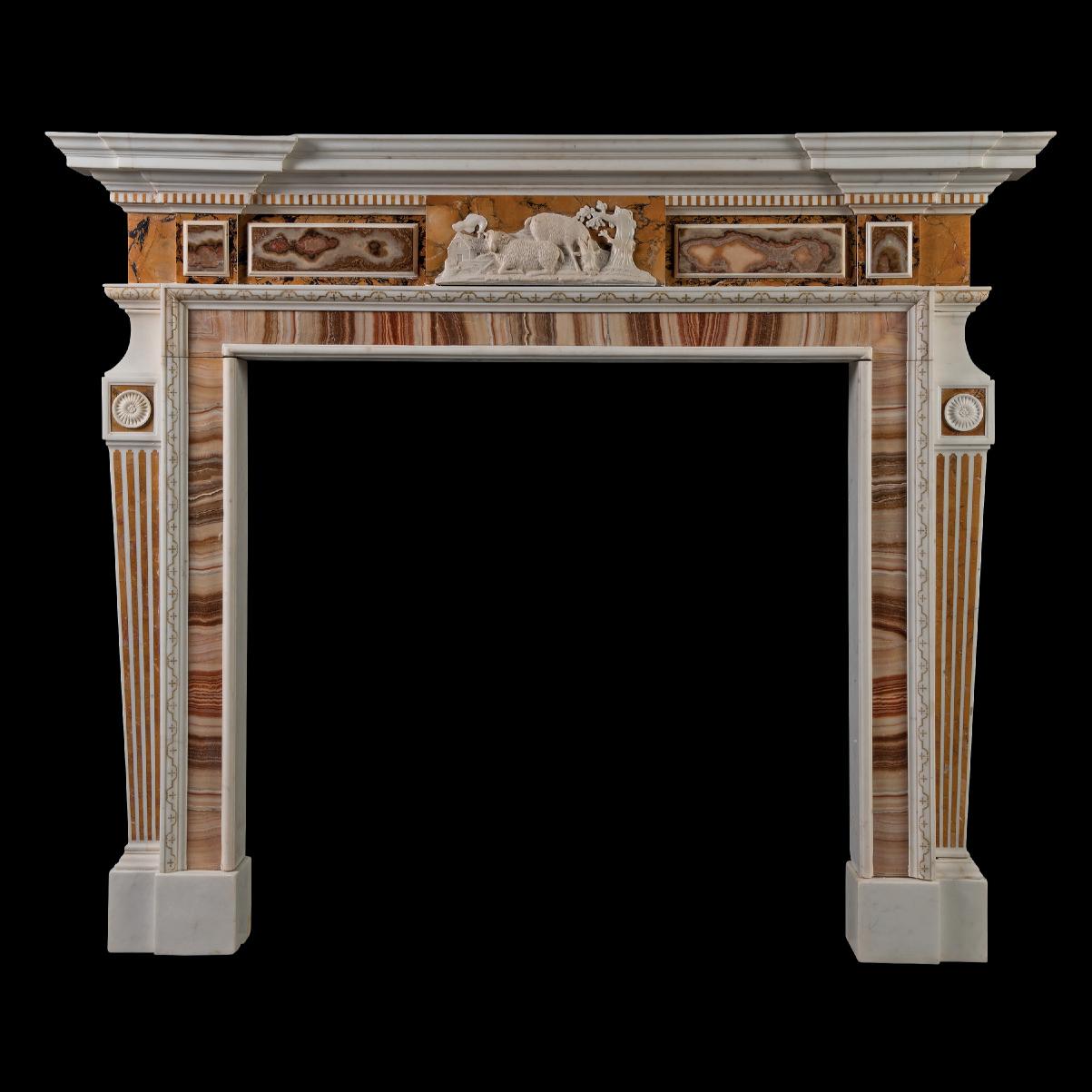
THE
ADVENT OF HISTORICISM - A CABINET BY LOUIS-ALEXANDRE BELLANGE
A RESTAURATION ORMOLU-MOUNTED, BRASS-INLAID, EBONY AND JAPANESE LACQUER MEUBLE D'APPUI BY LOUIS-ALEXANDRE BELLANGÉ, CIRCA 1835-40
With marble top, above a leaf and strapwork frieze and two cupboard doors inset with panels of Japanese lacquer within nashiji borders, the uprights with chimera and dolphin mounts, the sides with female masks on plinth base, with one interior shelf, the interior doors lined in amaranth, the lock inscribed 'BELLANGE EBENISTE DU ROI'
47½ in. (121 cm.) high, 63 in. (160 cm.) wide, 24¼ in. (61.5 cm.) deep
£80,000-120,000
PROVENANCE:
With Galerie Fabius Frères. With Galerie Steinitz, Paris. Sold Christie's, New York, 21 June 2012, lot 567.
US$110,000-160,000
€95,000-140,000
This cabinet by Louis-Alexandre Bellangé, one of the most innovative ébénistes of the Restauration and Louis-Philippe periods, showcases his mastery in blending historicist elements with new designs. Combining sumptuous ebony and Japanese lacquer, reminiscent of the works of Weisweiler and Carlin, alongside distinctive female mask mounts derived from the oeuvre of André-Charles Boulle, the cabinet also features neo-Renaissance grotesques affirming Bellangé’s flair for executing boldly original designs in materials of the highest quality.

FLAMING ‘BLEU LAPIS’ FROM THE SEVRES KILNS

■*40
A PAIR OF LATE EMPIRE ORMOLU-MOUNTED SEVRES PORCELAIN
'BLEU LAPIS' SEVEN-LIGHT CANDELABRA
CIRCA 1815, INCISED J B FOR JOSEPH BODSON, AFTER A DESIGN BY JOSEPH BODSON
Each with a blue porcelain baluster column decorated on the upper part with leaves and palmette friezes supporting flower-shaped bobeches and the central torch topped by a flame, the three-sided base with corners adorned with a ram's head resting on seated winged lions on a tripartite plinth, the underside of one candelabra incised 'J B'
35Ω in. (90 cm.) high; 13º in. (33.5 cm.) wide; 11æ in. (30 cm.) deep
£70,000-100,000
US$95,000-140,000
€83,000-120,000
These mesmerising 'bleu lapis' candelabra decorated with palmettes, sphinxes and rams heads demonstrate the innovative designs of the Sèvres manufactory in the late Empire and early Restauration period. Bearing the initials 'J B', they follow designs dated 1814 in the collection of the Archives de la manufacture de Sèvres for candélabres Bodson by the painter and decorator Joseph Bodson, who worked at the manufactory from 1813-1819. The candelabra present the same form, ornament and white and gilt decoration as the designs, varying only in the striking 'bleu lapis' ground simulating precious lapis lazuli. They appear to be a rare and unique realisation of Bodson's composition.
The design for candélabres Bodson in the Archives de la manufacture de Sèvres
LEARN MORE
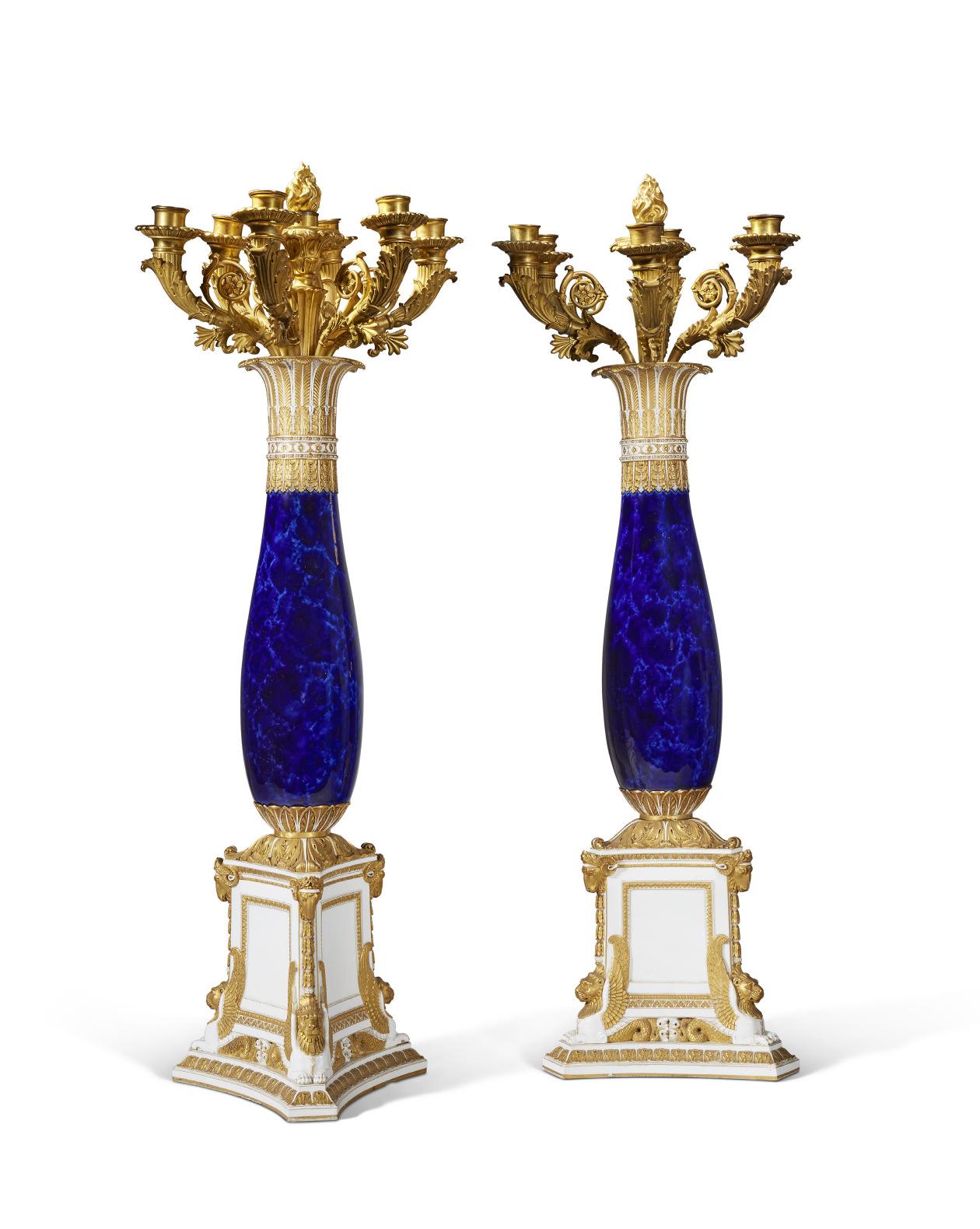
A GIFT FROM THE LAST EMPEROR OF THE FRENCH
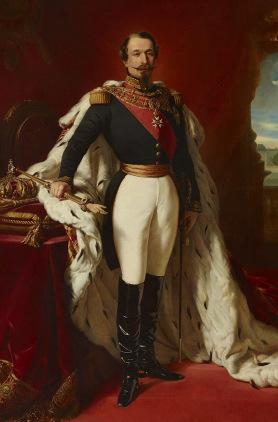
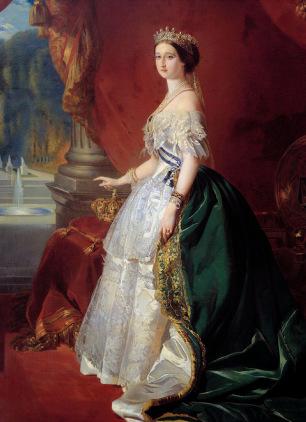
■*41
AN IMPERIAL NAPOLEON III ORMOLU, SILVERED AND MARBLE GUERIDON
THIRD QUARTER 19TH CENTURY
The circular calacatta viola marble top inset with a silvered roundel incised with the French imperial arms and inscribed 'DERNIER SOUVENIR/ DE/ SA MAJESTE EMPEREUR NAPOLEON III/ A MONSIEUR
N.W.J. STRODE./ CAMDEN PLACE/ CHISLEHUST./JANVIER 1873.', with a tooled edge, supported by acanthus-wrapped scrolling supports and a central stiff-leaf cast shaft with foliate boss, terminating in a foliate base, flanked by four winged putti with scrolling foliate bodies, interspersed with draped lambrequins surmounted by the Imperial crown and decorated with the Imperial eagle and the 'E' cypher of Empress Eugenie alternatively, on a shaped quadripartite plinth with gadrooned edge, on castors
33Ω in. (85 cm.) high; 36º in. (92 cm.) diameter
£40,000-60,000
PROVENANCE:
Almost certainly commissioned by Empress Eugenie, removed in 1871 to Camden Place, Chislehurst by Napoleon III and Empress Eugenie, given to Nathaniel Strode on the death of Napoleon III in January 1873.
US$54,000-81,000
€48,000-71,000
Bearing the cypher of the Empress Eugenie and decorated with the Imperial regalia, this gueridon is a fascinating gift from an Emperor and Empress in exile. Typifying the lavish Napoleon III style, the gueridon was brought to England at the fall of the Second French Empire and, as detailed on the plaque at the centre of the table, was given at Napoleon III's death to Nathaniel Strode, owner of Camden Place in Chislehurst, a country house in the French style where the Imperial couple made their home in England.
Portraits of Emperor Napoleon III and Empress Eugenie by Franz Xaver Winterhalter, 1853.
LEARN MORE
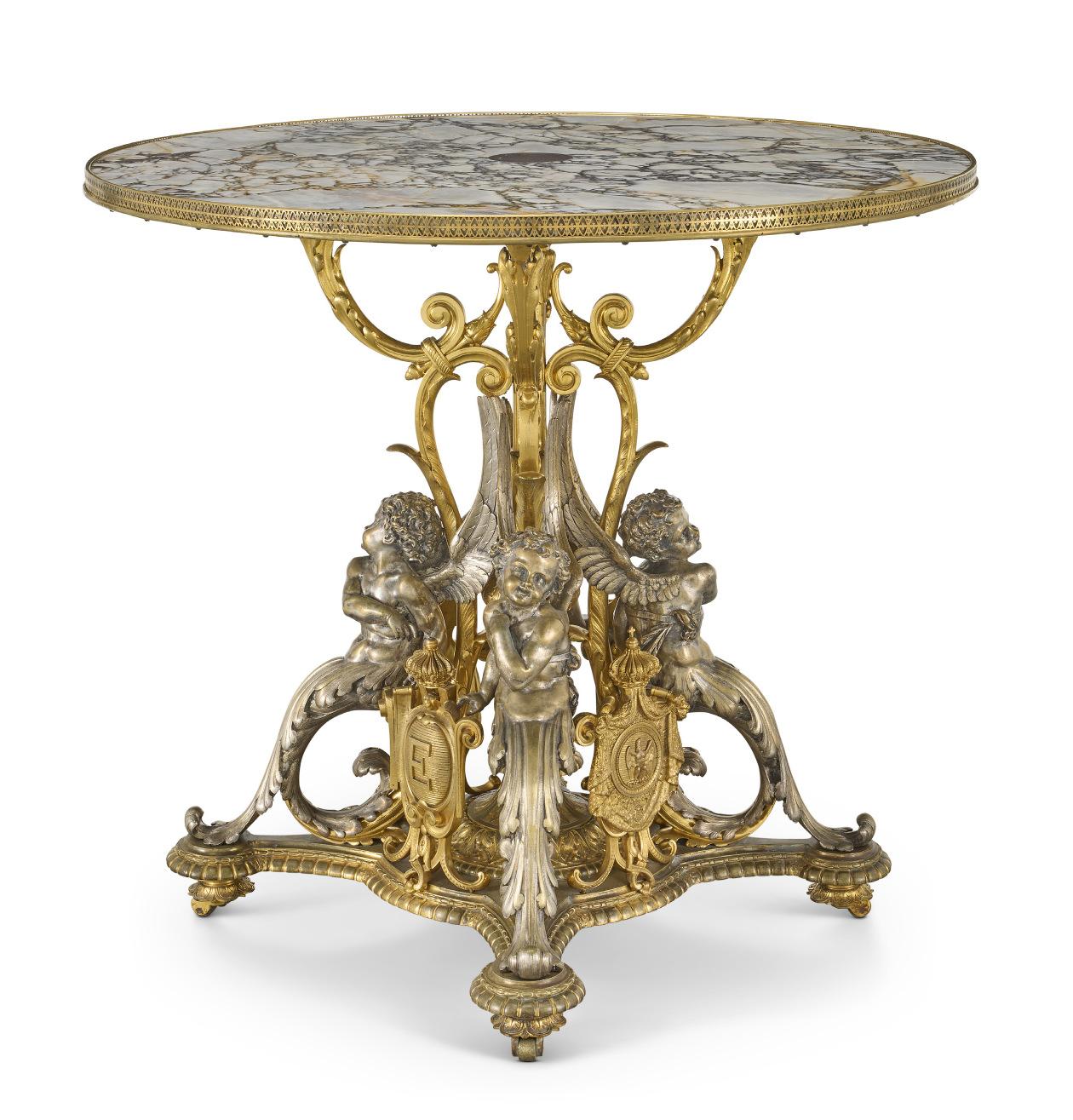
EUROPEAN TASTE FOR THE ANTIQUE
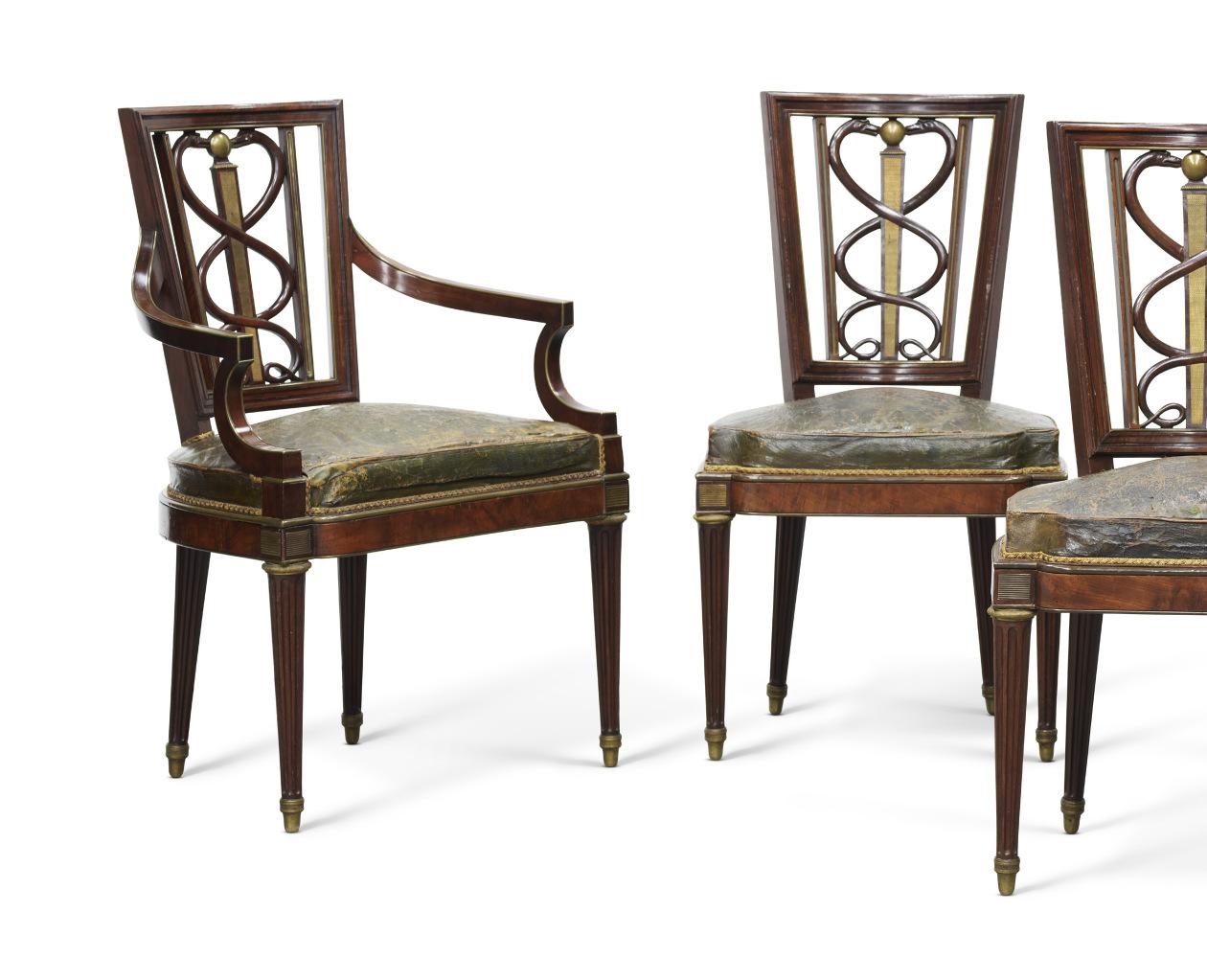
A SUITE OF LATE LOUIS XVI ORMOLU-MOUNTED MAHOGANY SEAT FURNITURE
ATTRIBUTED TO JOHANN GOTTLIEB FROST, THE ORMOLU MOUNTS ATTRIBUTED TO FRANCOIS REMOND, CIRCA 1785-1790
Comprising a pair of fauteuils and three side chairs, the pierced back modelled as a caduceus with twinsnakes flanking a tooled splat surmounted by a sphere, the bowed seat above fluted tapering legs headed by capitals with mille-raies fluting, terminating in sabots, the seats upholstered in green leather
The armchairs: 35Ω in. (90 cm.) high; 23æ in. (60 cm.) wide; 22 in. (56 cm.) deep
The side chairs: 35Ω in. (90 cm.) high; 20Ω in. (52 cm.) wide; 19æ in. (50 cm.) deep
£60,000-80,000
PROVENANCE:
US$81,000-110,000
€71,000-95,000
By repute from the collection of Chrétien Guillaume de Lamoignon de Malesherbes (1721-1794), premier président de la Cour des aides in 1750, directeur général de la Librairie, and chef de la censure, ministre et secrétaire d'État de la Maison du Roi, lawyer of Louis XVI at his trial in 1793. Collection of the Comtesse Jacqueline de Beaumont (1924-2021), née Gérard; until sold in 2021.
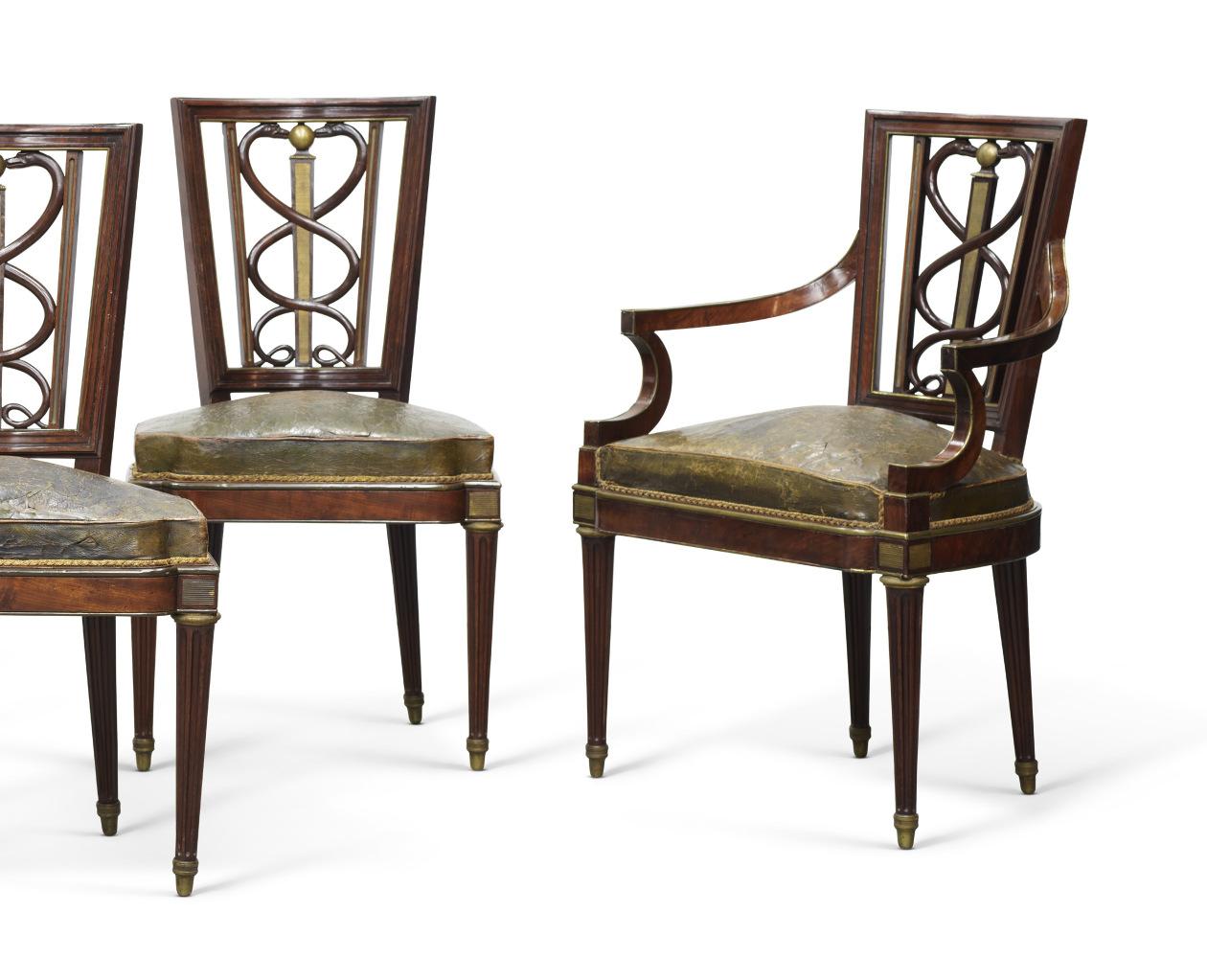
With backs modelled as the caduceus and sober yet elegant mounts these mahogany chairs are a bold statement of late 18th century neoclassical taste and exemplify the pre-revolutionary menuiserie production inspired by models from the courts of central and eastern Europe. They can be firmly attributed to Johann Gottlieb Frost, active in Paris in the late 1780s and closely relate to models by David Roentgen, in whose workshop Frost received his training and for whom he would later work as an agent in Paris. Interestingly, it is documented that Frost, like Roentgen, purchased mounts for furniture from the bronzier François Rémond. They were in the collection of comtesse Jacqueline de Beaumont (1924-2021) and were by family repute formerly in the collection of Chrétien Guillaume de Lamoignon de Malesherbes (1721-1794), lawyer of King Louis XVI at his trial.
A MASTERFUL EXAMPLE OF NEOCLASSICISM
LEARN MORE
A WHITE MARBLE FIGURE OF THE SANDAL BINDER (SANDALBINDERIN)
BY
RUDOLF (RIDOLFO) SCHADOW (1786-1822), ROME, 1819
Signed and dated 'RUDOLPH SCHADOW / FEC : ROMAE 1819'; on a grey marble base
120 cm. (47º in.) high
£100,000-150,000
PROVENANCE:
Private collection, Italy.
EXHIBITED:
US$140,000-200,000
€120,000-180,000
Almost certainly the example presented at the ‘Nazarene’ exhibition of German artists residing in Rome, organized in April 1819 by Baron Barthold Georg Niebuhr (1776–1831) at the Palazzo Caffarelli on the Capitoline Hill, on the occasion of the visit of Emperor Francis I of Austria and his wife.
COMPARATIVE LITERATURE:
D.C. Johnson, ‘Rudolf Schadows Sandalbinderin in Rom und Amerika,’ Forschungen und Berichte, Staatliche Museen zu Berlin, 1983, XXIII, pp. 113-122.
G. Eckardt, Ridolfo Schadow: Ein Bildhauer in Rom zwischen Klassizismus und Romantik, Cologne, 2000, pp. 30-31 and 82-86.
The Sandal Binder is a brilliantly carved marble that captures both emotional restraint and intimate sensitivity. The sculpture portrays a young girl fastening her sandal with remarkable anatomical precision and classical elegance. Schadow’s work was deeply informed by his artistic upbringing and extensive study of Greco-Roman sculpture. This composition is widely celebrated for its cool yet tender portrayal, exemplifying the neoclassical ideals of clarity, form, and refined emotion. A striking testament to Schadow’s originality and skill, the piece remains one of the artist's most iconic compositions.

THE MARQUIS OF ALIGRE’S MONUMENTAL VASE
■*44
A MONUMENTAL BRONZE VASE
BY EMMANUEL FRÉMIET (PARIS 1824 - 1910 PARIS), 1866
Decorated with scenes of deer; signed and dated 'FREMIET, 1866.'
66Ω in. (174 cm.) high; 43º in. (110 cm.) wide
£80,000-120,000
PROVENANCE:
US$110,000-160,000
€95,000-140,000
Étienne Marie Charles de Pomereu, Marquis d'Aligre (1813 - 1889) and his wife née Marie Amélie Louise Charlotte de Préaulx (1854-1926),
Thence by descent until the sale with Me Thierry de Maigret, Hôtel Drouot, Paris, 6 June 2012, lot 253.
COMPARATIVE LITERATURE:
F.-G. Dumas (dir.), Catalogue illustré du Salon de 1880, Société des artistes français, Paris, 1880, pp. 185-186. E. de Biez, E. Frémiet, Paris, 1910.
S. Lami, Dictionnaire des sculpteurs de l’École française au dix-neuvième siècle, Paris, vol. II, 1919, pp. 405-419.
C. Chevillot, ‘Les marques de fonderie’, in L’Estampille, March 1986, no. 190, p. 56.
C. Chevillot, Emmanuel Frémiet ‘La main et le multiple’, exh. cat. Dijon and Grenoble, 1988.
This impressive monumental vase, signed and dated 1866, exemplifies Frémiet’s rare venture into large-scale decorative bronze casting. Probably commissioned by the Marquis d’Aligre for the Château des Vaux in Eure-et-Loir, a prominent estate renowned for its grand hunting traditions, the vase skillfully combines Louis XIV classical motifs inspired by Versailles with the anatomical precision characteristic of 19th-century animal sculpture.
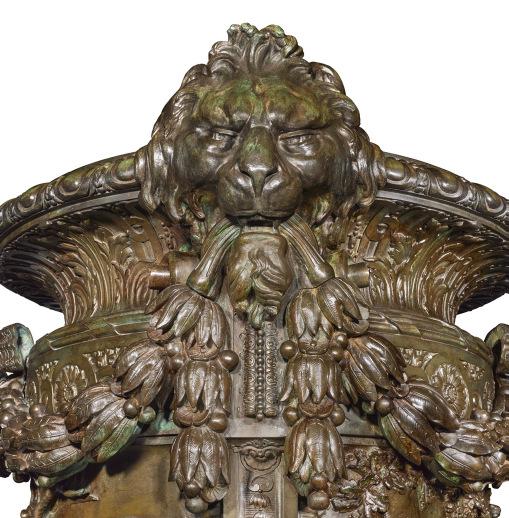
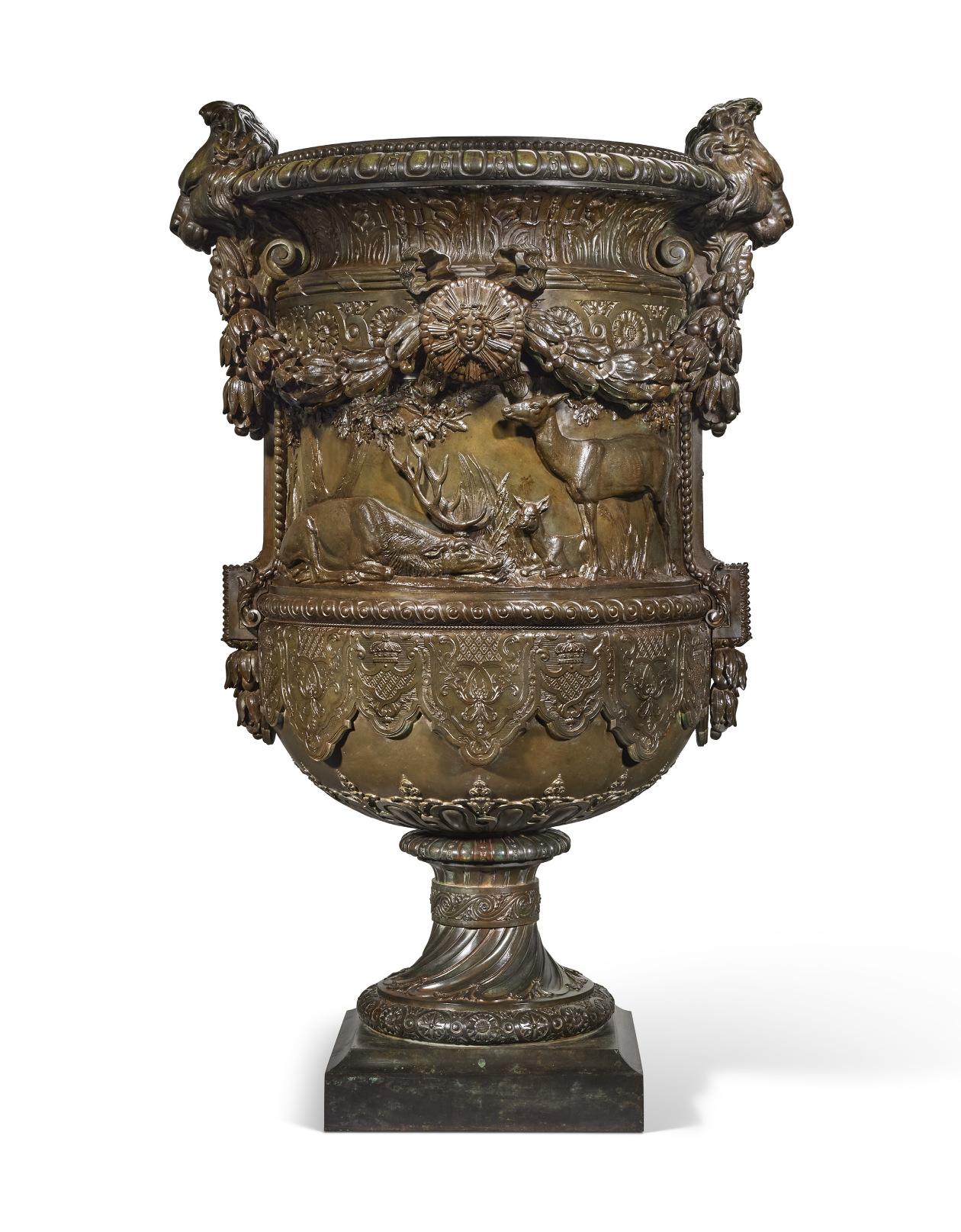
CONDITIONS OF SALE • BUYING AT CHRISTIE’S
CONDITIONS OF SALE
These Conditions of Sale and the Important Notices and Explanation of Cataloguing Practice set out the terms on which we offer the lots listed in this catalogue for sale. By registering to bid and/or by bidding at auction you agree to these terms, so you should read them carefully before doing so. You will find a glossary at the end explaining the meaning of the words and expressions coloured in bold. As well as these Conditions of Sale, lots in which we offer Non-Fungible Tokens for sale are governed by the Additional Conditions of Sale – Non-Fungible Tokens, which can be found at Appendix A to these Conditions of Sale. For the sale of Non-Fungible Tokens, to the extent there is a conflict between the “London Conditions of Sale Buying at Christie’s” and “Additional Conditions of Sale – Non-Fungible Tokens”, the latter controls.
Unless we own a lot ( symbol), Christie’s acts as agent for the seller. This means that we are providing services to the seller to help them sell their lot and that Christie’s is concluding the contract for the sale of the lot on behalf of the seller. When Christie’s is the agent of the seller, the contract of sale which is created by any successful bid by you for a lot will be directly between you and the seller, and not between you and Christie’s.
• BEFORE THE SALE
A
1
• DESCRIPTION OF LOTS
(a) Certain words used in the catalogue description have special meanings. You can find details of these on the page headed ‘Important Notices and Explanation of Cataloguing Practice’ which forms part of these terms. You can find a key to the Symbols found next to certain catalogue entries under the section of the catalogue called ‘Symbols Used in this Catalogue’.
(b) Our description of any lot in the catalogue, any condition report and any other statement made by us (whether orally or in writing) about any lot, including about its nature or condition, artist, period, materials, approximate dimensions or provenance are our opinion and not to be relied upon as a statement of fact. We do not carry out in-depth research of the sort carried out by professional historians and scholars. All dimensions and weights are approximate only.
2
• OUR RESPONSIBILITY FOR OUR DESCRIPTION OF LOTS
We do not provide any guarantee in relation to the nature of a lot apart from our authenticity warranty contained in paragraph E2 and to the extent provided in paragraph I below.
• CONDITION
3
(a) The condition of lots sold in our auctions can vary widely due to factors such as age, previous damage, restoration, repair and wear and tear. Their nature means that they will rarely be in perfect condition Lots are sold ‘as is’, in the condition they are in at the time of the sale, without any representation or warranty or assumption of liability of any kind as to condition by Christie’s or by the seller.
(b) Any reference to condition in a catalogue entry or in a condition report will not amount to a full description of condition, and images may not show a lot clearly. Colours and shades may look different in print or on screen to how they look on physical inspection. Condition reports may be available to help you evaluate the condition of a lot Condition reports are provided free of charge as a convenience to our buyers and are for guidance only. They offer our opinion but they may not refer to all faults, inherent defects, restoration, alteration or adaptation because our staff are not professional restorers or conservators. For that reason they are not an alternative to examining a lot in person or taking your own professional advice. It is your responsibility to ensure that you have requested, received and considered any condition report.
• VIEWING LOTS PRE-AUCTION
4
(a) If you are planning to bid on a lot, you should inspect it personally or through a knowledgeable representative before you make a bid to make sure that you accept the description and its condition We recommend you get your own advice from a restorer or other professional adviser.
(b) Pre-auction viewings are open to the public free of charge. Our specialists may be available to answer questions at pre-auction viewings or by appointment.
5
• ESTIMATES
Estimates are based on the condition, rarity, quality and provenance of the lots and on prices recently paid at auction for similar property. Estimates can change. Neither you, nor anyone else, may rely on any estimates as a prediction or guarantee of the actual selling price of a lot or its value for any other purpose. Estimates do not include the buyer’s premium or any applicable taxes.
• WITHDRAWAL
6
Christie’s may, at its option, withdraw any lot at any time prior to or during the sale of the lot. Christie’s has no liability to you for any decision to withdraw.
• JEWELLERY
7
(a) Coloured gemstones (such as rubies, sapphires and emeralds) may have been treated to improve their look, through methods such as heating and oiling. These methods are accepted by the international jewellery trade but may make the gemstone less strong and/or require special care over time.
(b) It will not be apparent to us whether a diamond is naturally or synthetically formed unless it has been tested by a gemmological laboratory. Where the diamond has been tested, a gemmological report will be available.
(c) All types of gemstones may have been improved by some method. You may request a gemmological report for any item which does not have a report if the request is made to us at least three weeks before the date of the auction and you pay the fee for the report.
(d) Certain weights in the catalogue description are provided for guidance purposes only as they have been estimated through measurement and, as such, should not be relied upon as exact.
(e) We do not obtain a gemmological report for every gemstone sold in our auctions. Where we do get gemmological reports from internationally accepted gemmological laboratories, such reports will
be described in the catalogue. Reports from American gemmological laboratories will describe any improvement or treatment to the gemstone. Reports from European gemmological laboratories will describe any improvement or treatment only if we request that they do so, but will confirm when no improvement or treatment has been made. Because of differences in approach and technology, laboratories may not agree whether a particular gemstone has been treated, the amount of treatment or whether treatment is permanent. The gemmological laboratories will only report on the improvements or treatments known to the laboratories at the date of the report. We do not guarantee nor are we responsible for any report or certificate from a gemmological laboratory that may accompany a lot
(f) For jewellery sales, estimates are based on the information in any gemmological report or, if no report is available, assume that the gemstones may have been treated or enhanced.
8 • WATCHES & CLOCKS
(a) Almost all clocks and watches are repaired in their lifetime and may include parts which are not original. We do not give a warranty that any individual component part of any watch or clock is authentic Watchbands described as ‘associated’ are not part of the original watch and may not be authentic. Clocks may be sold without pendulums, weights or keys.
(b) As collectors’ watches and clocks often have very fine and complex mechanisms, a general service, change of battery or further repair work may be necessary, for which you are responsible. We do not give a warranty that any watch or clock is in good working order. Certificates are not available unless described in the catalogue.
(c) Most watches have been opened to find out the type and quality of movement. For that reason, watches with water resistant cases may not be waterproof and we recommend you have them checked by a competent watchmaker before use. Important information about the sale, transport and shipping of watches and watchbands can be found in paragraph H2(g).
B • REGISTERING TO BID
1 • NEW BIDDERS
(a) If this is your first time bidding at Christie’s or you are a returning bidder who has not bought anything from any of our salerooms within the last two years you must register at least 48 hours before an auction to give us enough time to process and approve your registration. We may, at our option, decline to permit you to register as a bidder. You will be asked for the following:
(i) for individuals: Photo identification (driving licence, national identity card or passport) and, if not shown on the ID document, proof of your current address (for example, a current utility bill or bank statement).
(ii) for corporate clients: Your Certificate of Incorporation or equivalent document(s) showing your name and registered address together with documentary proof of directors and beneficial owners; and (iii) for trusts, partnerships, offshore companies and other business structures, please contact us in advance to discuss our requirements.
(b) We may also ask you to give us a financial reference and/or a deposit as a condition of allowing you to bid. For help, please contact our Credit Department on +44 (0)20 7839 9060.
2 • RETURNING BIDDERS
We may at our option ask you for current identification as described in paragraph B1(a) above, a financial reference or a deposit as a condition of allowing you to bid. If you have not bought anything from any of our salerooms in the last two years or if you want to spend more than on previous occasions, please contact our Credit Department on +44 (0)20 7839 9060.
• IF YOU FAIL TO PROVIDE THE RIGHT DOCUMENTS
3
If in our opinion you do not satisfy our bidder identification and registration procedures including, but not limited to completing any anti-money laundering and/or anti-terrorism financing checks we may require to our satisfaction, we may refuse to register you to bid, and if you make a successful bid, we may cancel the contract for sale between you and the seller.
• BIDDING ON BEHALF OF ANOTHER PERSON
4
(a) As authorised bidder. If you are bidding on behalf of another person who will pay Christie’s directly, that person will need to complete the registration requirements above before you can bid, and supply a signed letter authorising you to bid for them.
(b) As agent for a principal: If you register in your own name but are acting as agent for someone else (the “ultimate buyer(s)”) who will put you in funds before you pay us, you accept personal liability to pay the purchase price and all other sums due. We will require you to disclose the identity of the ultimate buyer(s) and may require you to provide documents to verify their identity in accordance with paragraph E3(b).
5
• BIDDING IN PERSON
If you wish to bid in the saleroom you must register for a numbered bidding paddle at least 30 minutes before the auction. You may register online at www.christies.com or in person. For help, please contact the Credit Department on +44 (0)20 7839 9060.
• BIDDING SERVICES
6
The bidding services described below are a free service offered as a convenience to our clients and Christie’s is not responsible for any error (human or otherwise), omission or breakdown in providing these services.
(a) Phone Bids
Your request for this service must be made no later than 24 hours prior to the auction. We will accept bids by telephone for lots only if our staff are available to take the bids. If you need to bid in a language other than in English, you must arrange this well before the auction. We may record telephone bids. By bidding on the telephone, you are agreeing to us recording your conversations. You also agree that your telephone bids are governed by these Conditions of Sale.
(b) Internet Bids on Christie’s LIVE™
For certain auctions we will accept bids over the Internet. For more information, please visit www.christies.com/register-and-bid As well as these Conditions of Sale, internet bids are governed by the Christie’s LIVE™ Terms of Use which are available at www.christies.
com/christies-live-terms
c) Written Bids
You can find a Written Bid Form at any Christie’s office or by choosing the sale and viewing the lots online at www.christies.com. We must receive your completed Written Bid at least 24 hours before the auction. Bids must be placed in the currency of the saleroom. The auctioneer will take reasonable steps to carry out written bids at the lowest possible price, taking into account the reserve If you make a written bid on a lot which does not have a reserve and there is no higher bid than yours, we will bid on your behalf at around 50% of the low estimate or, if lower, the amount of your bid. If we receive written bids on a lot for identical amounts, and at the auction these are the highest bids on the lot, we will sell the lot to the bidder whose written bid we received first.
• CONDUCTING THE SALE
C
1
• WHO CAN ENTER THE AUCTION
We may, at our option, refuse admission to our premises or decline to permit participation in any auction or to reject any bid.
• RESERVES
2
Unless otherwise indicated, all lots are subject to a reserve. We identify lots that are offered without reserve with the symbol • next to the lot number. The reserve cannot be more than the lot’s low estimate, unless the lot is subject to a third party guarantee and the irrevocable bid exceeds the printed low estimate. In that case, the reserve will be set at the amount of the irrevocable bid. Lots which are subject to a third party guarantee arrangement are identified in the catalogue with the symbol º♦
• AUCTIONEER’S DISCRETION
3
The auctioneer can at their sole option:
(a) refuse any bid; (b) move the bidding backwards or forwards in any way they may decide, or change the order of the lots; (c) withdraw any lot; (d) divide any lot or combine any two or more lots; (e) reopen or continue the bidding even after the hammer has fallen; and (f) in the case of error or dispute related to bidding and whether during or after the auction, to continue the bidding, determine the successful bidder, cancel the sale of the lot, or reoffer and resell any lot. If you believe that the auctioneer has accepted the successful bid in error, you must provide a written notice detailing your claim within 3 business days of the date of the auction. The auctioneer will consider such claim in good faith. If the auctioneer, in the exercise of their discretion under this paragraph, decides after the auction is complete, to cancel the sale of a lot, or reoffer and resell a lot, they will notify the successful bidder no later than by the end of the 7th calendar day following the date of the auction. The auctioneer’s decision in exercise of this discretion is final. This paragraph does not in any way prejudice Christie’s ability to cancel the sale of a lot under any other applicable provision of these Conditions of Sale, including the rights of cancellation set forth in section B(3), E(2)(i), F(4) and J(1).
4
• BIDDING
The auctioneer accepts bids from:
(a) bidders in the saleroom; (b) telephone bidders, and internet bidders through ‘Christie’s LIVE™ (as shown above in Section B6); and (c) written bids (also known as absentee bids or commission bids) left with us by a bidder before the auction.
5
• BIDDING ON BEHALF OF THE SELLER
The auctioneer may, at their sole option, bid on behalf of the seller up to but not including the amount of the reserve either by making consecutive bids or by making bids in response to other bidders. The auctioneer will not identify these as bids made on behalf of the seller and will not make any bid on behalf of the seller at or above the reserve. If lots are offered without reserve, the auctioneer will generally decide to open the bidding at 50% of the low estimate for the lot. If no bid is made at that level, the auctioneer may decide to go backwards at their sole option until a bid is made, and then continue up from that amount. In the event that there are no bids on a lot, the auctioneer may deem such lot unsold.
6 • BID INCREMENTS
Bidding generally starts below the low estimate and increases in steps (bid increments). The auctioneer will decide at their sole option where the bidding should start and the bid increments.
• CURRENCY CONVERTER
7
The saleroom video screens (and Christies LIVE™) may show bids in some other major currencies as well as sterling. Any conversion is for guidance only and we cannot be bound by any rate of exchange used. Christie’s is not responsible for any error (human or otherwise), omission or breakdown in providing these services.
• SUCCESSFUL BIDS
8
Unless the auctioneer decides to use their discretion as set out in paragraph C3 above, when the auctioneer’s hammer strikes, we have accepted the last bid. This means a contract for sale has been formed between the seller and the successful bidder. We will issue an invoice only to the registered bidder who made the successful bid. While we send out invoices by post and/or email after the auction, we do not accept responsibility for telling you whether or not your bid was successful. If you have bid by written bid, you should contact us by telephone or in person as soon as possible after the auction to get details of the outcome of your bid to avoid having to pay unnecessary storage charges.
• LOCAL BIDDING LAWS
9
You agree that when bidding in any of our sales that you will strictly comply with all local laws and regulations in force at the time of the sale for the relevant sale site.
D • THE BUYER’S PREMIUM, TAXES AND ARTIST’S RESALE ROYALTY
1 • THE BUYER’S PREMIUM
In addition to the hammer price, the successful bidder agrees to pay us a buyer’s premium on the hammer price of each lot sold. On all lots we charge 26% of the hammer price up to and including £800,000, 21% on that part of the hammer price over £800,000 and up to and including £4,500,000, and 15.0% of that part of the hammer price above £4,500,000. VAT will be added to the buyer’s premium and is payable by you. For lots offered under the VAT Margin Scheme or Temporary Admission VAT rules, the VAT may not be shown separately on our invoice because of tax laws. You may be eligible to have a VAT refund in certain circumstances if the lot is exported. Please see the “VAT refunds: what can I reclaim?” section of ‘VAT Symbols and Explanation’ for further information.
2 • TAXES
The successful bidder is responsible for all applicable tax including any VAT, GST, sales or compensating use tax or equivalent tax wherever such taxes may arise on the hammer price and the buyer’s premium VAT charges and refunds depend on the particular circumstances of the buyer. It is the buyer’s responsibility to ascertain and pay all taxes due. VAT is payable on the buyer’s premium and, for some lots, VAT is payable on the hammer price Following the departure of the UK from the EU (Brexit), UK VAT and Customs rules will apply only. For lots Christie’s ships or delivers to the United States, sales or use tax may be due on the hammer price buyer’s premium and/or any other charges related to the lot, regardless of the nationality or citizenship of the purchaser. Christie’s will collect sales tax where legally required. The applicable sales tax rate will be determined based upon the state, county, or locale to which the lot will be shipped or delivered. Successful bidders claiming an exemption from sales tax must provide appropriate documentation to Christie’s prior to the release of the lot. For shipments/deliveries to those states for which Christie’s is not required to collect sales tax, a successful bidder may be required to remit use tax to that state’s taxing authorities. Christie’s recommends you obtain your own independent tax advice with further questions.
For lots Christie’s ships or delivers to Jersey (Channel Islands), GST at a rate of 5% will be due on the hammer price, buyer’s premium, freight charges (as set out on your Shipping Quote Acceptance Form) and any applicable customs duty. Christie’s will collect GST from you, where legally required to do so.
For lots purchased by a successful bidder with a registered address in India and who has bid via Christie’s LIVE™, an Indian Equalisation Levy Tax at a rate of 2% will be due on the hammer price and buyer’s premium (exclusive of any applicable VAT). Christie’s will collect the Indian Equalisation Levy Tax from you, where required to do so.
• ARTIST’S RESALE ROYALTY
3
In certain countries, local laws entitle the artist or the artist’s estate to a royalty known as ‘artist’s resale right’ when any lot created by the artist is sold. We identify these lots with the λ symbol next to the lot number. If these laws apply to a lot, you must pay us an extra amount equal to the royalty. We will pay the royalty to the appropriate authority on the seller’s behalf.
The artist’s resale royalty applies if the hammer price of the lot is 1,000 GBP or more if located in the United Kingdom at the time of sale. The total royalty for any lot cannot be more than 12,500 GBP. We work out the amount owed as follows:
Royalty for the portion of the hammer price (in Pounds Sterling)
4% up to 50,000
3% between 50,000.01 and 200,000
1% between 200,000.01 and 350,000 0.50% between 350,000.01 and 500,000 over 500,000, the lower of 0.25% and 12,500 GBP.
E • WARRANTIES
1
• SELLER’S WARRANTIES
For each lot, the seller gives a warranty that the seller:
(a) is the owner of the lot or a joint owner of the lot acting with the permission of the other co-owners or, if the seller is not the owner or a joint owner of the lot, has the permission of the owner to sell the lot or the right to do so in law; and
(b) has the right to transfer ownership of the lot to the buyer without any restrictions or claims by anyone else.
If one or more of the above warranties are incorrect, the seller shall not have to pay more than the purchase price (as defined in paragraph F1(a) below) paid by you to us. The seller will not be responsible to you for any reason for loss of profits or business, expected savings, loss of opportunity or interest, costs, damages, other damages or expenses.
The seller gives no warranty in relation to any lot other than as set out above and, as far as the seller is allowed by law, all warranties from the seller to you, and all other obligations upon the seller which may be added to this agreement by law, are excluded.
• OUR AUTHENTICITY WARRANTY
2
We warrant, subject to the terms below, that the lots in our sales are authentic (our ‘authenticity warranty’). If, within five years of the date of the auction, you give notice to us that your lot is not authentic subject to the terms below, we will refund the purchase price paid by you. The meaning of authentic can be found in the glossary at the end of these Conditions of Sale. The terms of the authenticity warranty are as follows:
(a) It will be honoured for claims notified within a period of five years from the date of the auction. After such time, we will not be obligated to honour the authenticity warranty
(b) It is given only for information shown in UPPERCASE type in the first line of the catalogue description (the ‘Heading’). It does not apply to any information other than in the Heading even if shown in UPPERCASE type
(c) The authenticity warranty does not apply to any Heading or part of a Heading which is qualified Qualified means limited by a clarification in a lot’s catalogue description or by the use in a Heading of one of the terms listed in the section titled Qualified Headings on the page of the catalogue headed ‘Important Notices and Explanation of Cataloguing Practice’. For example, use of the term ‘ATTRIBUTED TO…’ in a Heading means that the lot is in Christie’s opinion probably a work by the named artist but no warranty is provided that the lot is the work of the named artist. Please read the full list of Qualified Headings and a lot’s full catalogue description before bidding.
(d) The authenticity warranty applies to the Heading as amended by any Saleroom notice
(e) The authenticity warranty does not apply where scholarship has developed since the auction leading to a change in generally accepted opinion. Further, it does not apply if the Heading either matched the generally accepted opinion of experts at the date of the sale or drew attention to any conflict of opinion.
(f) The authenticity warranty does not apply if the lot can only be shown not to be authentic by a scientific process which, on the date we published the catalogue, was not available or generally accepted for use, or which was unreasonably expensive or impractical, or which was likely to have damaged the lot
(g) The benefit of the authenticity warranty is only available to the original buyer shown on the invoice for the lot issued at the time of the sale and only if, on the date of the notice of claim, the original buyer is the full owner of the lot and the lot is free from any claim, interest or restriction by anyone else. The benefit of this authenticity warranty may not be transferred to anyone else.
(h) In order to claim under the authenticity warranty, you must:
(i) give us written notice of your claim within five years of the date of the auction. We may require full details and supporting evidence of any such claim;
(ii) at Christie’s option, we may require you to provide the written opinions of two recognised experts in the field of the lot mutually agreed by you and us in advance confirming that the lot is not authentic If we have any doubts, we reserve the right to obtain additional opinions at our expense; and
(iii) return the lot at your expense to the saleroom from which you bought it in the condition it was in at the time of sale.
(i) Your only right under this authenticity warranty is to cancel the sale and receive a refund of the purchase price paid by you to us. We will not, in any circumstances, be required to pay you more than the purchase price nor will we be liable for any loss of profits or business, loss of opportunity or value, expected savings or interest, costs, damages, other damages or expenses.
(j) Books. Where the lot is a book, we give an additional warranty for 14 days from the date of the sale that if on collation any lot is defective in text or illustration, we will refund your purchase price, subject to the following terms:
(i) This additional warranty does not apply to:
(a) the absence of blanks, half titles, tissue guards or advertisements, damage in respect of bindings, stains, spotting, marginal tears or other defects not affecting completeness of the text or illustration;
(b) drawings, autographs, letters or manuscripts, signed photographs, music, atlases, maps or periodicals;
(c) books not identified by title;
(d) lots sold without a printed estimate;
(e) books which are described in the catalogue as sold not subject to return; or
(f) defects stated in any condition report or announced at the time of sale.
(ii) To make a claim under this paragraph you must give written details of the defect and return the lot to the sale room at which you bought it in the same condition as at the time of sale, within 14 days of the date of the sale.
(K) South East Asian Modern and Contemporary Art and Chinese Calligraphy and Painting.
In these categories, the authenticity warranty does not apply because current scholarship does not permit the making of definitive statements. Christie’s does, however, agree to cancel a sale in either of these two categories of art where it has been proven the lot is a forgery. Christie’s will refund to the original buyer the purchase price in accordance with the terms of Christie’s authenticity warranty provided that the original buyer notifies us with full supporting evidence documenting the forgery claim within twelve (12) months of the date of the auction. Such evidence must be satisfactory to us that the lot is a forgery in accordance with paragraph E2(h)(ii) above and the lot must be returned to us in accordance with E2h(iii) above. Paragraphs E2(b), (c), (d), (e), (f) and (g) and (i) also apply to a claim under these categories.
(l) Chinese, Japanese and Korean artefacts (excluding Chinese, Japanese and Korean calligraphy, paintings, prints, drawings and jewellery).
In these categories, paragraph E2 (b) – (e) above shall be amended so that where no maker or artist is identified, the authenticity warranty is given not only for the Heading but also for information regarding date or period shown in UPPERCASE type in the second line of the catalogue description (the “SubHeading”). Accordingly, all references to the Heading in paragraph E2 (b) – (e) above shall be read as references to both the Heading and the SubHeading
3 • YOUR WARRANTIES
(a) You warrant that the funds used for settlement are not connected with any criminal activity, including tax evasion, and you are neither under investigation, nor have you been charged with or convicted of money laundering, terrorist activities or other crimes.
(b) Where you are bidding as agent on behalf of any ultimate buyer(s) who will put you in funds before you pay Christie’s for the lot(s), you warrant that:
(i) you have conducted appropriate customer due diligence on the ultimate buyer(s) and have complied with all applicable anti-money laundering, counter terrorist financing and sanctions laws;
(ii) you will disclose to us the identity of the ultimate buyer(s) (including any officers and beneficial owner(s) of the ultimate buyer(s) and any persons acting on its behalf) and on our request, provide documents to verify their identity;
(iii) the arrangements between you and the ultimate buyer(s) in relation to the lot or otherwise do not, in whole or in part, facilitate tax crimes;
(iv) you do not know, and have no reason to suspect that the ultimate buyer(s) (or its officers, beneficial owners or any persons acting on its behalf) are on a sanctions list, are under investigation for, charged with or convicted of money laundering, terrorist activities or other crimes, or that the funds used for settlement are connected with the proceeds of any criminal activity, including tax evasion; and
(v) where you are a regulated person who is supervised for anti-money laundering purposes under the laws of the EEA or another jurisdiction with requirements equivalent to the EU 4th Money Laundering Directive, and we do not request documents to verify the ultimate buyer’s identity at the time of registration, you consent to us relying on your due diligence on the ultimate buyer, and will retain their identification and verification documents for a period of not less than 5 years from the date of the transaction. You will make such documentation available for immediate inspection on our request.
F • PAYMENT
1
• HOW TO PAY
(a) Immediately following the auction, you must pay the purchase price being:
(i) the hammer price; and
(ii) the buyer’s premium; and
(iii) any amounts due under section D3 above; and
(iv) any duties, goods, sales, use, compensating or service tax or VAT.
Payment is due no later than by the end of the seventh calendar day following the date of the auction, or no later than 24 hours after we issue you with an invoice in the case of payment made in cryptocurrency, as the case may be (the ‘due date’).
(b) We will only accept payment from the registered bidder. Once issued, we cannot change the buyer’s name on an invoice or re-issue the invoice in a different name. You must pay immediately even if you want to export the lot and you need an export licence.
(c) You must pay for lots bought at Christie’s in the United Kingdom in the currency stated on the invoice in one of the following ways:
(i) Wire transfer
You must make payments to:
Lloyds Bank Plc, City Office, PO Box 217, 72 Lombard Street, London EC3P 3BT. Account number: 00172710, sort code: 30-00-02 Swift code: LOYDGB2LCTY. IBAN (international bank account number): GB81 LOYD 3000 0200 1727 10.
(ii) Credit Card
We accept most major credit cards subject to certain conditions. You may make payment via credit card in person. You may also make a ‘cardholder not present’ (CNP) payment by calling Christie’s Post-Sale Services Department on +44 (0)20 7752 3200 or for some sales, by logging into your MyChristie’s account by going to: www.christies. com/mychristies. Details of the conditions and restrictions applicable to credit card payments are available from our Post-Sale Services Department, whose details are set out in paragraph (e) below.
If you pay for your purchase using a credit card issued outside the region of the sale, depending on the type of credit card and account you hold, the payment may incur a cross-border transaction fee. If you think this may apply to, you, please check with your credit card issuer before making the payment.
Please note that for sales that permit online payment, certain transactions will be ineligible for credit card payment.
(iii) Cash
We accept cash subject to a maximum of £5,000 per buyer per year at our Cashier’s Department only (subject to conditions).
(iv) Banker’s draft
You must make these payable to Christie’s and there may be conditions.
(v) Cheque
You must make cheques payable to Christie’s. Cheques must be from accounts in pounds sterling (GBP) from a United Kingdom bank.
(vi) Cryptocurrency
With the exception of clients resident in Mainland China, payment for a lot marked with the symbol may be made in a cryptocurrency or cryptocurrencies of our choosing. Such cryptocurrency payments must be made in accordance with the Terms for Payment by Buyers in Cryptocurrency set out at Appendix B in these Conditions of Sale.
(d) You must quote the sale number, lot number(s), your invoice number and Christie’s client account number when making a payment. All payments sent by post must be sent to: Christie’s, Cashiers Department, 8 King Street, St James’s, London, SW1Y 6QT.
(e) For more information please contact our Post-Sale Service Department by phone on +44 (0)20 7752 3200 or fax on +44 (0)20 752 3300.
2
• TRANSFERRING OWNERSHIP TO YOU
You will not own the lot and ownership of the lot will not pass to you until we have received full and clear payment of the purchase price, even in circumstances where we have released the lot to the buyer.
3 • TRANSFERRING RISK TO YOU
The risk in and responsibility for the lot will transfer to you from whichever is the earlier of the following:
(a) When you collect the lot; or
(b) At the end of the 30th day following the date of the auction or, if earlier, the date the lot is taken into care by a third-party warehouse as set out on the page headed ‘Storage and Collection’, unless we have agreed otherwise with you in writing.
4 • WHAT HAPPENS IF YOU DO NOT PAY
(a) If you fail to pay us the purchase price in full by the due date, we will be entitled to do one or more of the following (as well as enforce our rights under paragraph F5 and any other rights or remedies we have by law):
(i) to charge interest from the due date at a rate of 5% a year above the UK Lloyds Bank base rate from time to time on the unpaid amount due;
(ii) we can cancel the sale of the lot. If we do this, we may sell the lot again, publicly or privately on such terms we shall think necessary or appropriate, in which case you must pay us any shortfall between the purchase price and the proceeds from the resale. You must also pay all costs, expenses, losses, damages and legal fees we have to pay or may suffer and any shortfall in the seller’s commission on the resale;
(iii) we can pay the seller an amount up to the net proceeds payable in respect of the amount bid by your default in which case you acknowledge and understand that Christie’s will have all of the rights of the seller to pursue you for such amounts;
(iv) we can hold you legally responsible for the purchase price and may begin legal proceedings to recover it together with other losses, interest, legal fees and costs as far as we are allowed by law;
(v) we can take what you owe us from any amounts which we or any company in the Christie’s Group may owe you (including any deposit or other part-payment which you have paid to us);
(vi) we can, at our option, reveal your identity and contact details to the seller;
(vii) we can reject at any future auction any bids made by or on behalf of the buyer or to obtain a deposit from the buyer before accepting any bids;
(viii) to exercise all the rights and remedies of a person holding security over any property in our possession owned by you, whether by way of pledge, security interest or in any other way as permitted by the law of the place where such property is located. You will be deemed to have granted such security to us and we may retain such property as collateral security for your obligations to us; and (ix) we can take any other action we see necessary or appropriate.
(b) If you owe money to us or to another Christie’s Group company, we can use any amount you do pay, including any deposit or other partpayment you have made to us, or which we owe you, to pay off any amount you owe to us or another Christie’s Group company for any transaction.
(c) If you make payment in full after the due date, and we choose to accept such payment we may charge you storage and transport costs from the date that is ninety (90) calendar days following the auction in accordance with paragraphs Gc and Gd.
5
• KEEPING YOUR PROPERTY
If you owe money to us or to another Christie’s Group company, as well as the rights set out in F4 above, we can use or deal with any of your property we hold or which is held by another Christie’s Group company in any way we are allowed to by law. We will only release your property to you after you pay us or the relevant Christie’s Group company in full for what you owe.
However, if we choose, we can also sell your property in any way we think appropriate. We will use the proceeds of the sale against any amounts you owe us and we will pay any amount left from that sale to you. If there is a shortfall, you must pay us any difference between the amount we have received from the sale and the amount you owe us.
• COLLECTION AND STORAGE
G
(a) You must collect purchased lots within thirty (30) days from the auction (but note that lots will not be released to you until you have made full and clear payment of all amounts due to us).
(b) If you do not collect any lot within ninety (90) days following the auction we can, at our option:
(i) charge you storage costs at the rates set out at www.christies.com/ en/help/buying-guide/storage-fees.
(ii) move the lot to another Christie’s location or an affiliate or third party warehouse and charge you transport costs and administration fees for doing so and you will be subject to the third party storage warehouse’s standard terms and to pay for their standard fees and costs.use’s standard terms and to pay for their standard fees and costs. (iii) sell the lot in any commercially reasonable way we think appropriate.
(c) The Storage Conditions which can be found at www.christies.com/en/ help/buying-guide/storage-conditions will apply.
(d) Nothing in this paragraph is intended to limit our rights under paragraph F4.
• TRANSPORT AND SHIPPING
H
1
• TRANSPORT AND SHIPPING
We will enclose a transport and shipping form with each invoice sent to you. You must make all transport and shipping arrangements. However, we can arrange to pack, transport and ship your property if you ask us to and pay the costs of doing so. We recommend that you ask us for an estimate especially for any large items or items of high value that need professional packing before you bid. We may also suggest other handlers, packers, transporters or experts if you ask us to do so. For more information, please contact Christie’s Art Transport on +44 (0)20 7839 9060. See the information set out at www.christies.com/ shipping or contact us at arttransportlondon@christies.com. We will take reasonable care when we are handling, packing, transporting and shipping a lot. However, if we recommend another company for any of these purposes, we are not responsible for their acts, failure to act or neglect.
• EXPORT AND IMPORT
2
Any lot sold at auction may be affected by laws on exports from the country in which it is sold and the import restrictions of other countries. Many countries require a declaration of export for property leaving the country and/or an import declaration on entry of property into the country. Local laws may prevent you from importing a lot or may prevent you selling a lot in the country you import it into. We will not be obliged to cancel your purchase and refund the purchase price if your lot may not be exported, imported or it is seized for any reason by a government authority. It is your responsibility to determine and satisfy the requirements of any applicable laws or regulations relating to the export or import of any lot you purchase.
(a) You alone are responsible for getting advice about and meeting the requirements of any laws or regulations which apply to exporting or importing any lot prior to bidding. If you are refused a licence or there is a delay in getting one, you must still pay us in full for the lot. We may be able to help you apply for the appropriate licences if you ask us to and pay our fee for doing so. However, we cannot guarantee that you will get one. For more information, please contact Christie’s Art Transport Department on +44 (0)20 7839 9060. See the information set out at www.christies.com/shipping or contact us at arttransport_ london@ christies.com.
(b) You alone are responsible for any applicable taxes, tariffs or other government-imposed charges relating to the export or import of the lot. If Christie’s exports or imports the lot on your behalf, and if Christie’s pays these applicable taxes, tariffs or other governmentimposed charges, you agree to refund that amount to Christie’s.
(c) Lots made of protected species
Lots made of or including (regardless of the percentage) endangered and other protected species of wildlife are marked with the symbol ~ in the catalogue. This material includes, among other things, ivory, tortoiseshell, crocodile skin, rhinoceros horn, whalebone, certain species of coral, and Brazilian rosewood. You should check the relevant customs laws and regulations before bidding on any lot containing wildlife material if you plan to export the lot from the country in which the lot is sold and import it into another country as a licence may be required. In some cases, the lot can only be shipped with an independent scientific confirmation of species and/or age, and you will need to obtain these at your own cost. Several countries have imposed restrictions on dealing in elephant ivory, ranging from a total ban on importing African elephant ivory in the United States to importing, exporting and selling under strict measures in other countries. The UK and EU have both implemented regulations on selling, exporting and importing elephant ivory. In our London sales, lots made of or including elephant ivory material are marked with the symbol and are offered with the benefit of being registered as ‘exempt’ in accordance with the UK Ivory Act. Handbags containing endangered or protected species material are marked with the symbol ≈ and further information can be found in paragraph H2(h) below. We will not be obliged to cancel your purchase and refund the purchase price if your lot may not be exported, imported or it is seized for any reason by a government authority. It is your responsibility to determine and satisfy the requirements of any applicable laws or regulations relating to the export or import of property containing such protected or regulated material.
(d) Lots of Iranian origin
As a convenience to buyers, Christie’s indicates under the title of a lot if the lot originates from Iran (Persia). Some countries prohibit or restrict the purchase and/or import of Iranian-origin property. It is your responsibility to ensure you do not bid on or import a lot in contravention of any sanctions, trade embargoes or other laws that apply to you. For example, the USA prohibits dealings in and import of Iranian-origin “works of conventional craftsmanship” (such as carpets, textiles, decorative objects, and scientific instruments) without an appropriate licence. Christie’s has a general OFAC licence which, subject to compliance with certain conditions, may enable a buyer to import this type of lot into the USA. If you use Christie’s general OFAC licence for this purpose, you agree to comply with the licence conditions and provide Christie’s with all relevant information. You also acknowledge that Christie’s will disclose your personal information and your use of the licence to OFAC.
(e) Gold
Gold of less than 18ct does not qualify in all countries as ‘gold’ and may be refused import into those countries as ‘gold’.
(f) Jewellery over 50 years old
Under current laws, jewellery over 50 years old which is worth £39,219 or more will require an export licence which we can apply for on your behalf. It may take up to eight weeks to obtain the export jewellery licence.
(g) Watches
Many of the watches offered for sale in this catalogue are pictured with straps made of endangered or protected animal materials such as alligator or crocodile. These lots are marked with the symbol ψ in the catalogue. These endangered species straps are shown for display purposes only and are not for sale. Christie’s will remove and retain the strap prior to shipment from the sale site. At some sale sites, Christie’s may, at its discretion, make the displayed endangered species strap available to the buyer of the lot free of charge if collected in person from the sale site within one year of the date of the sale. Please check with the department for details on a particular lot. For all symbols and other markings referred to in paragraph H2, please note that lots are marked as a convenience to you, but we do not accept liability for errors or for failing to mark lots
(h) Handbags
A lot marked with the symbol ≈ next to the lot number includes endangered or protected species material and is subject to CITES regulations. This lot may only be shipped to an address within the country of the sale site or personally picked up from our saleroom. The term “hardware” refers to the metallic parts of the handbag, such as the buckle hardware, base studs, lock and keys and/or strap, which are plated with a coloured finish (e.g. gold, silver, palladium). The terms “Gold Hardware”, “Silver Hardware”, “Palladium Hardware”, etc. refer to the tone or colour of the hardware and not the actual material used. If the handbag incorporates solid metal hardware, this will be referenced in the catalogue description.
I • OUR LIABILITY TO YOU
(a) We give no warranty in relation to any statement made, or information given, by us or our representatives or employees, about any lot other than as set out in the authenticity warranty and, as far as we are allowed by law, all warranties and other terms which may be added to this agreement by law are excluded. The seller’s warranties contained in paragraph E1 are their own and we do not have any liability to you in relation to those warranties
(b) (i) We are not responsible to you for any reason (whether for breaking this agreement or any other matter relating to your purchase of, or bid for, any lot) other than in the event of fraud or fraudulent misrepresentation by us or other than as expressly set out in these Conditions of Sale; or (ii) we do not give any representation, warranty or guarantee or assume any liability of any kind in respect of any lot with regard to merchantability, fitness for a particular purpose, description, size, quality, condition, attribution, authenticity, rarity, importance, medium, provenance, exhibition history, literature, or historical relevance. Except as required by local law, any warranty of any kind is excluded by this paragraph.
(c) In particular, please be aware that our written and telephone bidding services, Christie’s LIVE™, condition reports, currency converter and saleroom video screens are free services and we are not responsible to you for any error (human or otherwise), omission or breakdown in these services.
(d) We have no responsibility to any person other than a buyer in connection with the purchase of any lot
(e) If, in spite of the terms in paragraphs (a) to (d) or E2(i) above, we are found to be liable to you for any reason, we shall not have to pay more than the purchase price paid by you to us. We will not be responsible to you for any reason for loss of profits or business, loss of opportunity or value, expected savings or interest, costs, damages, or expenses.
J • OTHER TERMS
1 • OUR ABILITY TO CANCEL
In addition to the other rights of cancellation contained in this agreement, we can cancel a sale of a lot if: (i) any of your warranties in paragraph E3 are not correct; (ii) we reasonably believe that completing the transaction is or may be unlawful; or (iii) we reasonably believe that the sale places us or the seller under any liability to anyone else or may damage our reputation.
2 • RECORDINGS
We may videotape and record proceedings at any auction. We will keep any personal information confidential, except to the extent disclosure is required by law. However, we may, through this process, use or share these recordings with another Christie’s Group company and marketing partners to analyse our customers and to help us to tailor our services for buyers. If you do not want to be videotaped, you may make arrangements to make a telephone or written bid or bid on Christie’s LIVE™ instead. Unless we agree otherwise in writing, you may not videotape or record proceedings at any auction.
• COPYRIGHT
3
We own the copyright in all images, illustrations and written material produced by or for us relating to a lot (including the contents of our catalogues unless otherwise noted in the catalogue). You cannot use them without our prior written permission. We do not offer any guarantee that you will gain any copyright or other reproduction rights to the lot
5
4 • ENFORCING THIS AGREEMENT
If a court finds that any part of this agreement is not valid or is illegal or impossible to enforce, that part of the agreement will be treated as being deleted and the rest of this agreement will not be affected.
• TRANSFERRING YOUR RIGHTS AND RESPONSIBILITIES
You may not grant a security over or transfer your rights or responsibilities under these terms on the contract of sale with the buyer unless we have given our written permission. This agreement will be binding on your successors or estate and anyone who takes over your rights and responsibilities.
• TRANSLATIONS
6
If we have provided a translation of this agreement, we will use this original version in deciding any issues or disputes which arise under this agreement.
• PERSONAL INFORMATION
7
We will hold and process your personal information and may pass it to another Christie’s Group company for use as described in, and in line with, our privacy notice at www.christies.com/about-us/contact/ privacy and if you are a resident of California you can see a copy of our California Consumer Privacy Act statement at https://www.christies. com/about-us/contact/ccpa
8 • WAIVER
No failure or delay to exercise any right or remedy provided under these Conditions of Sale shall constitute a waiver of that or any other right or remedy, nor shall it prevent or restrict the further exercise of that or any other right or remedy. No single or partial exercise of such right or remedy shall prevent or restrict the further exercise of that or any other right or remedy.
9 • LAW AND DISPUTES
This agreement, and any contractual or non-contractual dispute arising out of or in connection with this agreement, will be governed by English law. Before either you or we start any court proceedings and if you and we agree, you and we will try to settle the dispute by mediation in accordance with the CEDR Model Mediation Procedure. If the dispute is not settled by mediation, you agree for our benefit that the dispute will be referred to and dealt with exclusively in the English courts; however, we will have the right to bring proceedings against you in any other court.
10 •REPORTING ON WWW.CHRISTIES.COM
Details of all lots sold by us, including catalogue descriptions and prices, may be reported on www.christies.com. Sales totals are hammer price plus buyer’s premium and do not reflect costs, financing fees, or application of buyer’s or seller’s credits. We regret that we cannot agree to requests to remove these details from www.christies.com
• GLOSSARY
K
auctioneer: the individual auctioneer and/or Christie’s. authentic: a genuine example, rather than a copy or forgery of:
(i) the work of a particular artist, author or manufacturer, if the lot is described in the Heading as the work of that artist, author or manufacturer; (ii) a work created within a particular period or culture, if the lot is described in the Heading as a work created during that period or culture;
(iii) a work for a particular origin source if the lot is described in the Heading as being of that origin or source; or
(iv) in the case of gems, a work which is made of a particular material, if the lot is described in the Heading as being made of that material.
authenticity warranty: the guarantee we give in this agreement that a lot is authentic as set out in section E2 of this agreement.
buyer’s premium: the charge the buyer pays us along with the hammer price catalogue description: the description of a lot in the catalogue for the auction, as amended by any saleroom notice
Christie’s Group: Christie’s International Plc, its subsidiaries and other companies within its corporate group.
condition: the physical condition of a lot
due date: has the meaning given to it in paragraph F1(a).
estimate: the price range included in the catalogue or any saleroom notice within which we believe a lot may sell. Low estimate means the lower figure in the range and high estimate means the higher figure.
The mid estimate is the midpoint between the two.
hammer price: the amount of the highest bid the auctioneer accepts for the sale of a lot
Heading: has the meaning given to it in paragraph E2.
SubHeading: has the meaning given to it in paragraph E2.
lot: an item to be offered at auction (or two or more items to be offered at auction as a group).
other damages: any special, consequential, incidental or indirect damages of any kind or any damages which fall within the meaning of ‘special’, ‘incidental’ or ‘consequential’ under local law.
purchase price: has the meaning given to it in paragraph F1(a).
provenance: the ownership history of a lot
qualified: has the meaning given to it in paragraph E2 and Qualified Headings means the section headed Qualified Headings on the page of the catalogue headed ‘Important Notices and Explanation of Cataloguing Practice’.
reserve: the confidential amount below which we will not sell a lot saleroom notice: a written notice posted next to the lot in the saleroom and on www.christies.com, which is also read to prospective telephone bidders and notified to clients who have left commission bids, or an announcement made by the auctioneer either at the beginning of the sale, or before a particular lot is auctioned.
UPPER CASE type: means having all capital letters.
warranty: a statement or representation in which the person making it guarantees that the facts set out in it are correct.
VAT SYMBOLS AND EXPLANATION (FOR ALL LOTS EXCLUDING NFTS)
IMPORTANT NOTICE:
The VAT liability in force on the date of the sale will be the rules under which we invoice you. You can find the meanings of words in bold on this page in the glossary section of the Conditions of Sale.
VAT PAYABLE
Symbol
No Symbol We will use the VAT Margin Scheme in accordance with Section 50A of the VAT Act 1994 & SI VAT (Special Provisions) Order 1995.
No VAT will be charged on the hammer price
VAT at 20% will be added to the buyer’s premium but will not be shown separately on our invoice.
† θ We will invoice under standard VAT rules and VAT will be charged at 20% on both the hammer price and buyer’s premium and shown separately on our invoice. For qualifying books only, no VAT is payable on the hammer price or the buyer’s premium
* These lots have been imported from outside the UK for sale and placed under the Temporary Admission regime. Import VAT is payable at 5% on the hammer price. VAT at 20% will be added to the buyer’s premium but will not be shown separately on our invoice.
Ω These lots have been imported from outside the UK for sale and placed under the Temporary Admission regime. Customs Duty as applicable will be added to the hammer price and Import VAT at 20% will be charged on the Duty Inclusive hammer price. VAT at 20% will be added to the buyer’s premium but will not be shown separately on our invoice.
α The VAT treatment will depend on whether you have registered to bid with a UK address or non-UK address:
• If you register to bid with an address within the UK you will be invoiced under the VAT Margin Scheme (see No Symbol above).
• If you register to bid with an address outside of the UK you will be invoiced under standard VAT rules (see † symbol above)
‡ For wine offered ‘in bond’ only. If you choose to buy the wine in bond no Excise Duty or Clearance VAT will be charged on the hammer If you choose to buy the wine out of bond Excise Duty as applicable will be added to the hammer price and Clearance VAT at 20% will be charged on the Duty inclusive hammer price
Whether you buy the wine in bond or out of bond, 20% VAT will be added to the buyer’s premium and shown on the invoice.
VAT refunds: what can I reclaim?
Non-UK buyer If you meet ALL of the conditions in notes 1 to 3 below we will refund the following tax charges:
No symbol We will refund the VAT amount in the buyer’s premium
† and α We will refund the VAT charged on the hammer price. VAT on the buyer’s premium can only be refunded if you are an overseas business. The VAT amount in the buyer’s premium cannot be refunded to non-trade clients.
‡ (wine only)
No Excise Duty or Clearance VAT will be charged on the hammer price providing you export the wine while ‘in bond’ directly outside the UK using an Excise authorised shipper. VAT on the buyer’s premium can only be refunded if you are an overseas business. The VAT amount in the buyer’s premium cannot be refunded to non-trade clients.
* and Ω We will refund the Import VAT charged on the hammer price and the VAT amount in the buyer’s premium
1. We CANNOT offer refunds of VAT amounts or Import VAT to buyers who do not meet all applicable conditions in full. If you are unsure whether you will be entitled to a refund, please contact Client Services at the address below before you bid.
2. No VAT amounts or Import VAT will be refunded where the total refund is under £100.
3. To receive a refund of VAT amounts/ Import VAT (as applicable) a non-UK buyer must:
a) have registered to bid with an address outside of the UK; and
b) provide immediate proof of correct export out of the UK within the required time frames of: 30 days of collection via a ‘controlled export’, but no later than 90 days from the date of the sale for * and Ωlots. All other lots must be exported within 90 days of the sale.
5. Following the UK’s departure from the EU (Brexit), private buyers will only be able to secure VAT-free invoicing and/or VAT refunds if they instruct Christie’s or a third party commercial shipper to export out of the UK on their behalf.
4. Details of the documents which you must provide to us to show satisfactory proof of export/ shipping are available from our VAT team at the address below. We charge a processing fee of £35.00 per invoice to check shipping/ export documents. We will waive this processing fee if you appoint Christie’s Shipping Department to arrange your export/shipping.
COPYRIGHT NOTICE No part of this catalogue may be reproduced, stored in a retrieval system or transmitted by any form or by any means, electronic, mechanical, photocopying, recording or otherwise, without the prior written permission of Christie’s. © COPYRIGHT, CHRISTIE, MANSON & WOODS LTD. (2024)
6. Private buyers who choose to export their purchased lots from the UK hand carry will now be charged VAT at the applicable rate and will not be able to claim a VAT refund.
7. IfyouappointChristie’sArtTransport or one of our authorised shippers to arrange your export/shipping we will issue you with an export invoice with the applicable VAT or duties cancelled as outlined above. If you later cancel or change the shipment in a manner that infringes the rules outlined above we will issue a revised invoice charging you all applicable taxes/charges. If you export via a third party commercial shipper, you must provide us with sufficient proof of export in order for us to cancel the applicable VAT or duties outlined above.
9. All reinvoicing requests, corrections, or other VAT adjustments must be received within four years from the date of sale.
If you have any questions about VAT refunds please contact Christie’s Client Services on info@christies.com
Tel: +44 (0)20 7389 2886. Fax: +44 (0)20 7839 1611.
8. If you ask us to re-invoice you under normal UK VAT rules (as if the lot had been sold with a † symbol) instead of under the Margin Scheme the lot may become ineligible to be resold using the Margin Schemes. You should take professional advice if you are unsure how this may affect you.
SYMBOLS USED IN THIS CATALOGUE
The meaning of words coloured in bold in this section can be found in paragraph K, Glossary, of the section of the catalogue headed ‘Conditions of Sale’.
º Christie’s has a direct financial interest in the lot. See Important Notices and Explanation of Cataloguing Practice in the Conditions of Sale for further information.
º
♦
Christie’s has provided a minimum price guarantee and has a direct financial interest in this lot. Christie’s has financed all or a part of such interest through a third party. Such third parties generally benefit financially if a guaranteed lot is sold. See the Important Notices in the Conditions of Sale for further information.
Christie’s has a financial interest in the lot. See Important Notices in the Conditions of Sale for further information.
Christie’s has a financial interest in this lot and has financed all or a part of such interest through a third party. Such third parties generally benefit financially if a guaranteed lot is sold. See the Important Notices in the Conditions of Sale for further information.
¤ A party with a direct or indirect interest in the lot who may have knowledge of the lot’s reserve or other material information may be bidding on the lot
λ
Artist’s Resale Right. See paragraph D3 of the Conditions of Sale for further information.
• Lot offered without reserve
Lot incorporates material from endangered species which could result in export restrictions. See paragraph H2(c) of the Conditions of Sale for further information.
≈
Handbag lot incorporates material from endangered species. International shipping restrictions apply. See paragraph H2 of the Conditions of Sale for further information.
Lot incorporates elephant ivory material. See paragraph H2 of the Conditions of Sale for further information.
ψ
Lot incorporates material from endangered species which is shown for display purposes only and is not for sale. See paragraph H2(h) of the Conditions of Sale for further information.
Lot is a Non Fungible Token (NFT). Please see Appendix A
– Additional Conditions of Sale – Non- Fungible Tokens in the Conditions of Sale for further information.
Lot contains both a Non Fungible Token (NFT) and a physical work of art. Please see Appendix A – Additional Conditions of Sale – Non-Fungible Tokens in the Conditions of Sale for further information.
With the exception of clients resident in Mainland China, you may elect to make payment of the purchase price for the lot via a digital wallet in the name of the registered bidder, which must be maintained with one of the following: Coinbase Custody Trust; Coinbase, Inc.; Fidelity Digital Assets Services, LLC; Gemini Trust Company, LLC; or Paxos Trust Company, LLC. Please see the lot notice and Appendix B – Terms for Payment by Buyers in Cryptocurrency in the Conditions of Sale for further requirements and information.
See VAT Symbols and Explanation in the Conditions of Sale for further information.
See Storage and Collection Page.
Please note that lots are marked as a convenience to you and we shall not be liable for any errors in, or failure to, mark a lot
IMPORTANT NOTICES
CHRISTIE’S INTEREST IN PROPERTY CONSIGNED FOR AUCTION
Δ Property in which Christie’s has an ownership or financial interest
From time to time, Christie’s may offer a lot in which Christie’s has an ownership interest or a financial interest. Such lot is identified in the catalogue with the symbol Δ next to its lot number. Where Christie’s has an ownership or financial interest in every lot in the catalogue, Christie’s will not designate each lot with a symbol, but will state its interest in the front of the catalogue.
º Minimum Price Guarantees
On occasion, Christie’s has a direct financial interest in the outcome of the sale of certain lots consigned for sale. This will usually be where it has guaranteed to the Seller that whatever the outcome of the auction, the Seller will receive a minimum sale price for the lot. This is known as a minimum price guarantee. Where Christie’s holds such financial interest, we identify such lots with the symbol ° next to the lot number.
º♦ Third Party Guarantees/Irrevocable bids
Where Christie’s has provided a Minimum Price Guarantee, it is at risk of making a loss, which can be significant if the lot fails to sell. Christie’s therefore sometimes chooses to share that risk with a third party who agrees, prior to the auction, to place an irrevocable written bid on the lot. If there are no other higher bids, the third party commits to buy the lot at the level of their irrevocable written bid. In doing so, the third party takes on all or part of the risk of the lot not being sold. Lots which are subject to a third party guarantee arrangement are identified in the catalogue with the symbol º♦ In most cases, Christie’s compensates the third party in exchange for accepting this risk. Where the third party is the successful bidder, the third party’s remuneration is based on a fixed financing fee. If the third party is not the successful bidder, the remuneration may either be based on a fixed fee or an amount calculated against the final hammer price. The third party may also bid for the lot above the irrevocable written bid.
Third party guarantors are required by us to disclose to anyone they are advising their financial interest in any lots they are guaranteeing. However, for the avoidance of any doubt, if you are advised by or bidding through an agent on a lot identified as being subject to a third party guarantee you should always ask your agent to confirm whether or not they have a financial interest in relation to the lot
Property in which Christie’s has an interest and Third Party Guarantee/Irrevocable bid
Where Christie’s has a financial interest in a lot and the lot fails to sell, Christie’s is at risk of making a loss. As such, Christie’s may choose to share that risk with a third party whereby the third party contractually agrees, prior to the auction, to place an irrevocable written bid on the lot. Such lot is identified with the symbol next to the lot number. Where the third party is the successful bidder on the lot, they will not receive compensation in exchange for accepting this risk. If the third party is not the successful bidder, Christie’s may compensate the third party. The third party is required by us to disclose to anyone they are advising of their financial interest in any lot in which Christie’s has a financial interest. If you are advised by or bidding through an agent on a lot in which Christie’s has a financial interest that is subject to a contractual written bid, you should always ask your agent to confirm whether or not they have a financial interest in relation to the lot
Bidding by parties with an interest
When a party with a direct or indirect interest in the lot who may have knowledge of the lot’s reserve or other material information may be bidding on the lot, we will mark the lot with this symbol ¤. This interest can include beneficiaries of an estate that consigned the lot or a joint owner of a lot Any interested party that successfully bids on a lot must comply with Christie’s Conditions of Sale, including paying the lot’s full buyer’s premium plus applicable taxes.
Post-catalogue notifications
If Christie’s enters into an arrangement or becomes aware of bidding that would have required a catalogue symbol, we will notify you by updating christies.com with the relevant information (time permitting) or otherwise by a pre-sale or prelot announcement.
Other Arrangements
Christie’s may enter into other arrangements not involving bids. These include arrangements where Christie’s has advanced money to consignors or prospective purchasers or where Christie’s has shared the risk of a guarantee with a partner without the partner being required to place an irrevocable written bid or otherwise participating in the bidding on the lot. Because such arrangements are unrelated to the bidding process they are not marked with a symbol in the catalogue.
Please see: http://www.christies.com/ financial-interest/ for a more detailed explanation of minimum price guarantees and third party financing arrangements.
EXPLANATION OF CATALOGUING PRACTICE
Terms used in a catalogue or lot description have the meanings ascribed to them below. Please note that all statements in a catalogue or lot description as to authorship are made subject to the provisions of the Conditions of Sale, including the authenticity warranty. Our use of these expressions does not take account of the condition of the lot or of the extent of any restoration. Written condition reports are usually available on request.
A term and its definition listed under ‘Qualified Headings’ is a qualified statement as to authorship. While the use of this term is based upon careful study and represents the opinion of specialists, Christie’s and the consignor assume no risk, liability and responsibility for the authenticity of authorship of any lot in this catalogue described by this term, and the authenticity warranty shall not be available with respect to lots described using this term.
PICTURES, DRAWINGS, PRINTS, MINIATURES AND SCULPTURE
Name(s) or Recognised Designation of an artist without any qualification: in Christie’s opinion a work by the artist.
QUALIFIED HEADINGS
Attributed to…”: in Christie’s qualified opinion probably a work by the artist in whole or in part.
“Studio of …”/“Workshop of …”: in Christie’s qualified opinion a work executed in the studio or workshop of the artist, possibly under their supervision.
“Circle of …”: in Christie’s qualified opinion a work of the period of the artist and showing their influence.
“Follower of …”: in Christie’s qualified opinion a work executed in the artist’s style but not necessarily by a pupil.
“Manner of …”: in Christie’s qualified opinion a work executed in the artist’s style but of a later date.
“After …”: in Christie’s qualified opinion a copy (of any date) of a work of the artist.
“Signed …”/“Dated …”/ “Inscribed …”: in Christie’s qualified opinion the work has been signed/dated/inscribed by the artist.
“With signature …”/“With date …”/ “With inscription …”: in Christie’s qualified opinion the signature/ date/inscription appears to be by a hand other than that of the artist.
The date given for Old Master, Modern and Contemporary Prints is the date (or approximate date when prefixed with ‘circa’) on which the matrix was worked and not necessarily the date when the impression was printed or published.
STORAGE AND COLLECTION
COLLECTION LOCATION AND TERMS
Specified lots (sold and unsold) marked with a filled square ( ) not collected from Christie’s, 8 King Street, London SW1Y 6QT by 5.00pm on the day of the sale will, at our option, be removed to Crozier Park Royal (details below). Christie’s will inform you if the lot has been sent offsite.
If the lot is transferred to Crozier Park Royal, it will be available for collection from 12.00pm on the second business day following the sale.
Please call Christie’s Client Service 24 hours in advance to book a collection time at Crozier Park Royal. All collections from Crozier Park Royal will be by prebooked appointment only
Tel: +44 (0)20 7839 9060
Email: cscollectionsuk@christies.com.
If the lot remains at Christie’s, 8 King Street, it will be available for collection on any working day (not weekends) from 9.00am to 5.00pm.
COLLECTION AND CONTACT DETAILS
Lots will only be released on payment of all charges due and on production of a Collection Form from Christie’s. Charges may be paid in advance or at the time of collection. We may charge fees for storage if your lot is not collected within thirty days from the sale. Please see paragraph G of the Conditions of Sale for further detail.
Tel: +44 (0)20 7839 9060
Email: cscollectionsuk@christies.com
SHIPPING
AND DELIVERY
Christie’s Post-Sale Service can organise local deliveries or international freight. Please contact them on +44 (0)20 7752 3200 or PostSaleUK@christies.com.
CROZIER PARK ROYAL
Unit 7, Central Park Central Way London NW10 7FY
Vehicle access via Central Way only, off Acton Lane.
COLLECTION FROM CROZIER PARK ROYAL
Please note that the opening hours for Crozier Park Royal are Monday to Friday 8.30am to 4.30pm and lots transferred are not available for collection at weekends.
As a leader in the art market,
Christie’s is committed to building a sustainable business model that promotes and protects the environment. Our digital platform on christies.com offers a conscious approach, creating an immersive space where we bring art to life through high quality images, videos and in-depth essays by our specialists.
With this robust online support, Christie’s will print fewer catalogues to ensure that we achieve our goal of Net Zero by 2030. However, when we do print, we will uphold the highest sustainable standards.
Please scan for more information about our sustainability goals and projects.
The catalogue you are reading is:
printed on fully recycled paper;
printed with vegetable-based ink and biodegradable laminates;
printed in close proximity to our markets in an effort to reduce distribution emissions.

IDENTITY VERIFICATION
From January 2020, new anti-money laundering regulations require Christie’s and other art businesses to verify the identity of all clients. To register as a new client, you will need to provide the following documents, or if you are an existing client, you will be prompted to provide any outstanding documents the next time you transact.
Private individuals:
• A copy of your passport or other government-issued photo ID
• Proof of your residential address (such as a bank statement or utility bill) dated within the last three months
Please upload your documents through your christies.com account: click ‘My Account’ followed by ‘Complete Profle’. You can also email your documents to info@christies.com or provide them in person.
Organisations:
• Formal documents showing the company’s incorporation, its registered ofice and business address, and its oficers, members and ultimate benefcial owners
• A passport or other government-issued photo ID for each authorised user
Please email your documents to info@christies.com or provide them in person.
